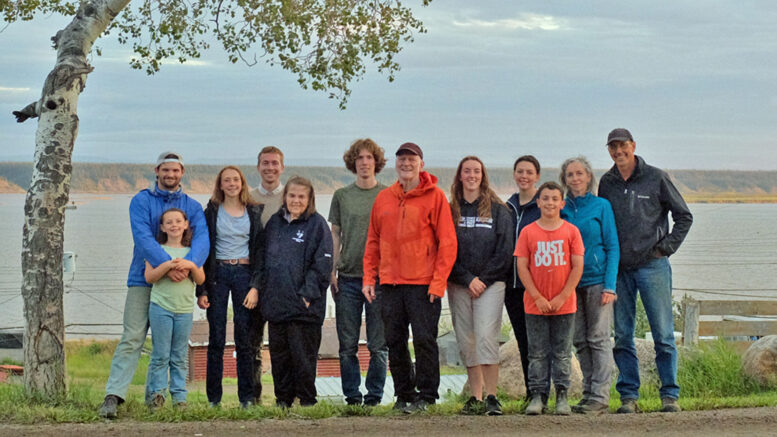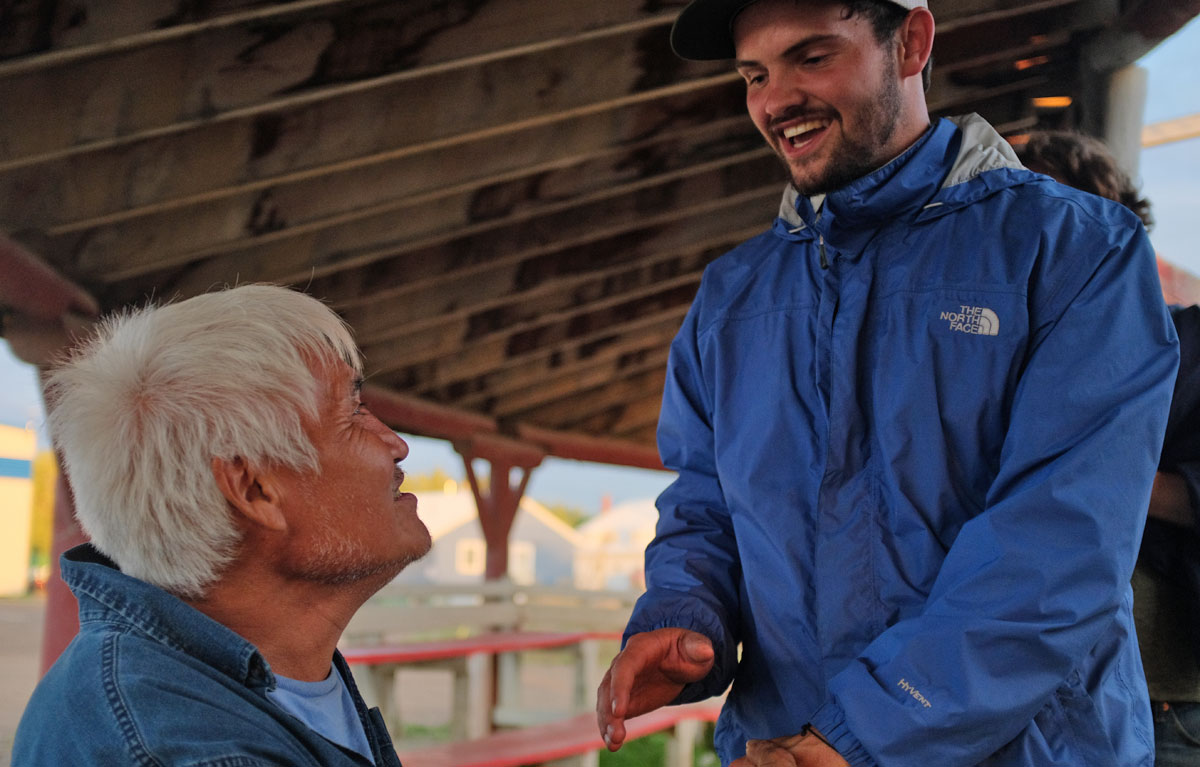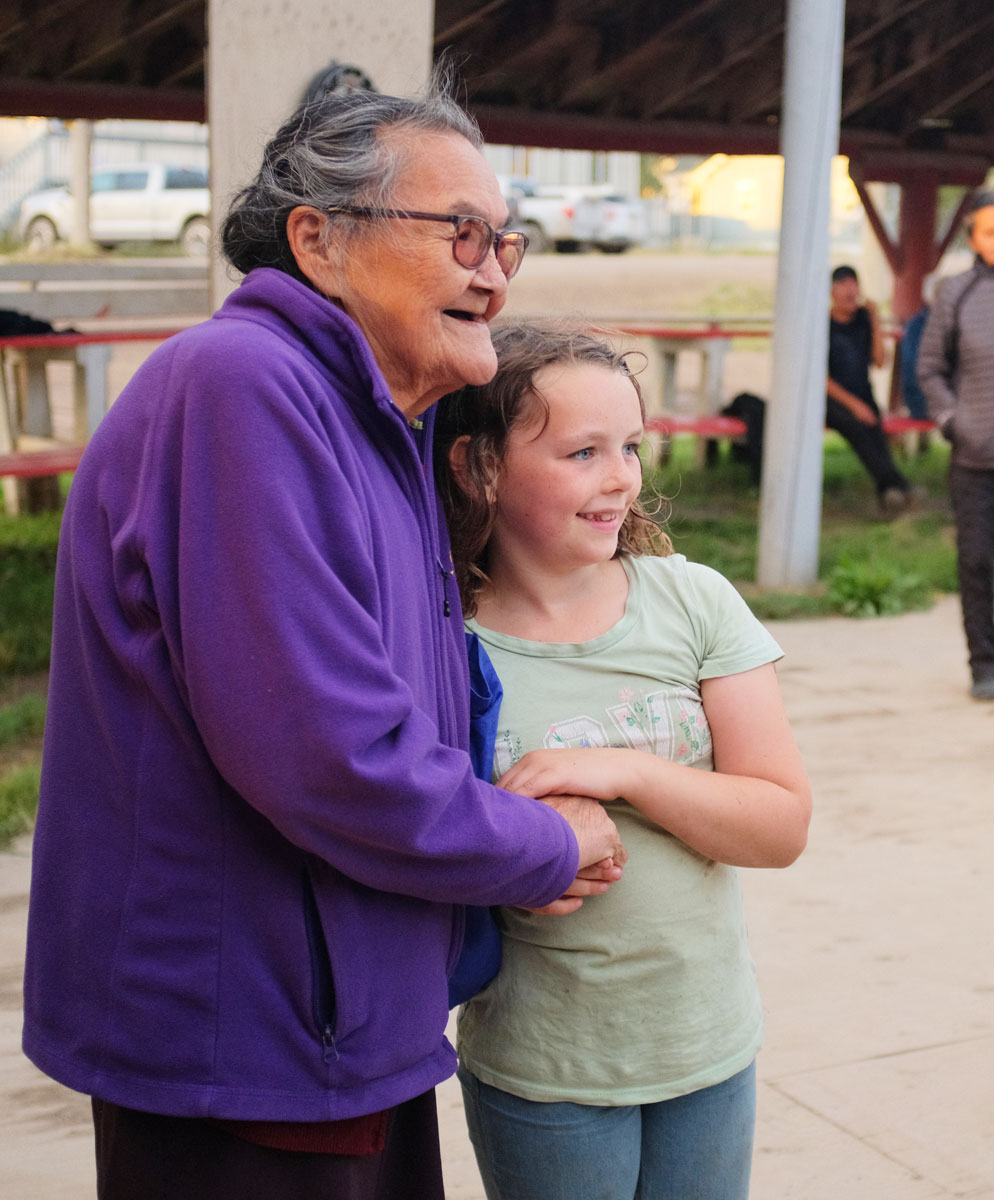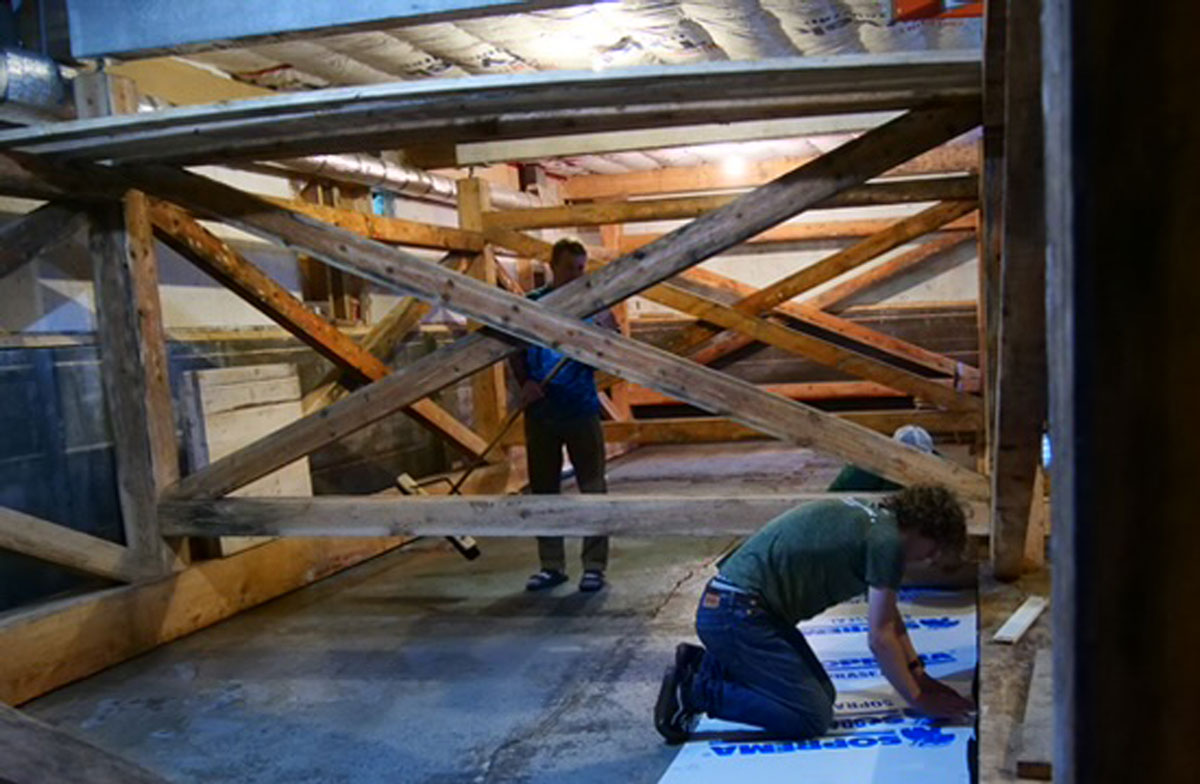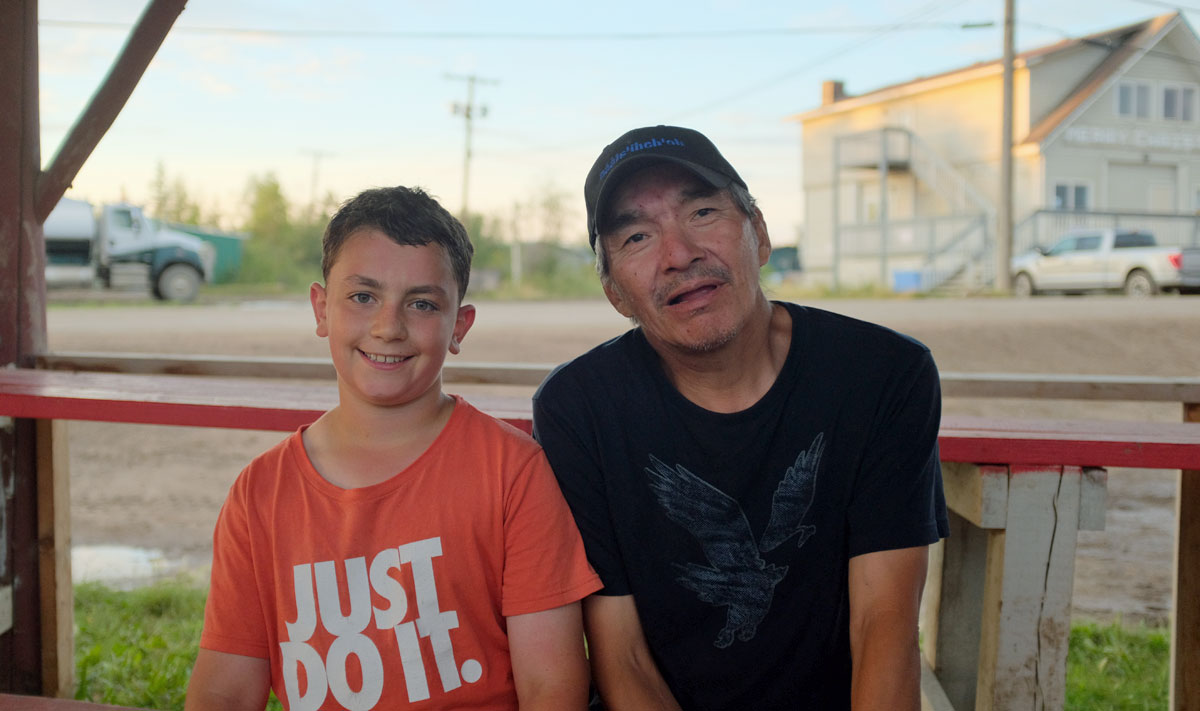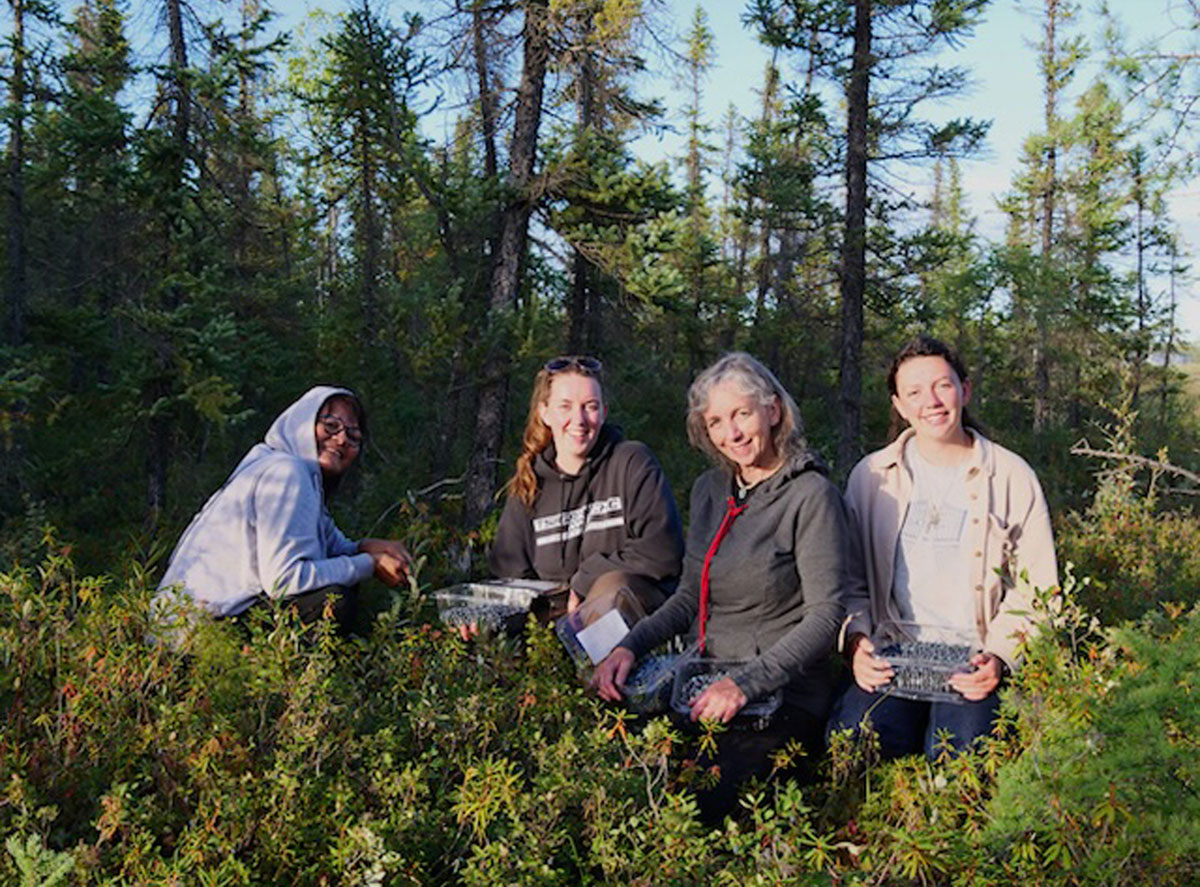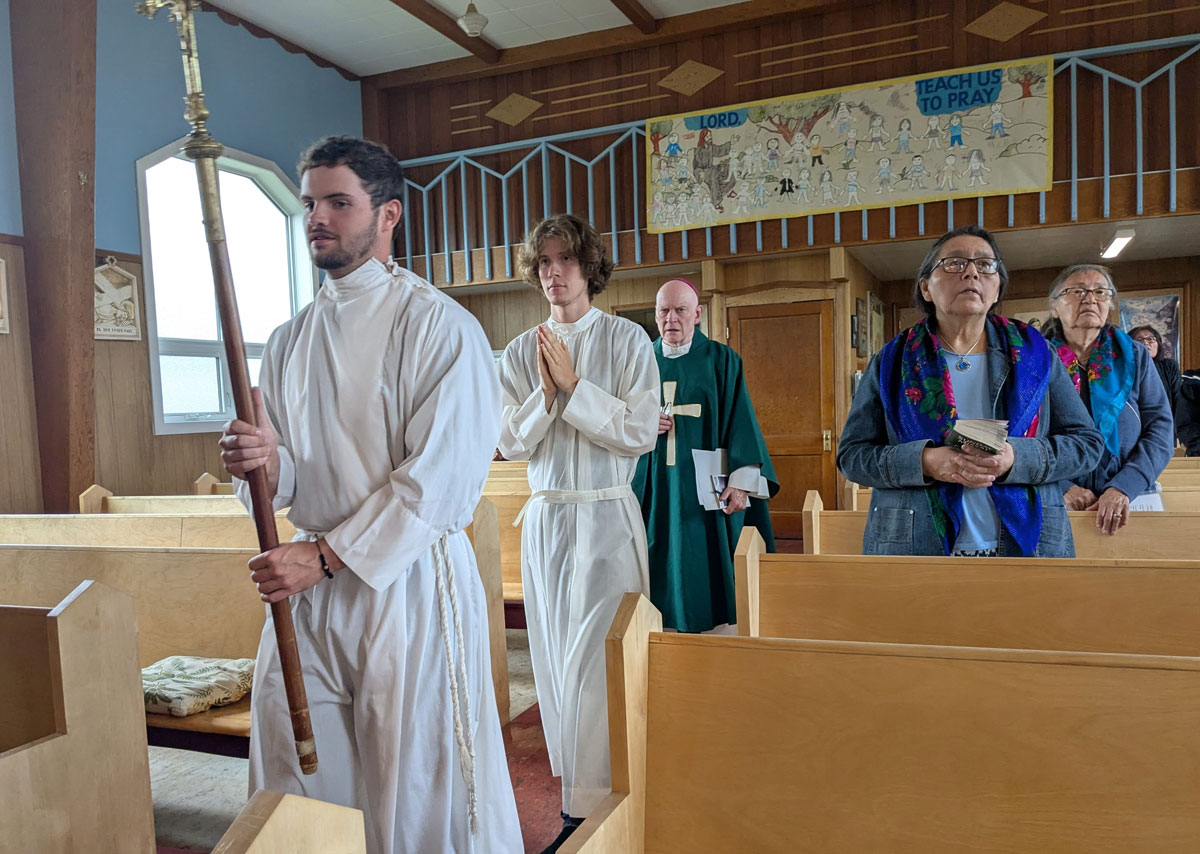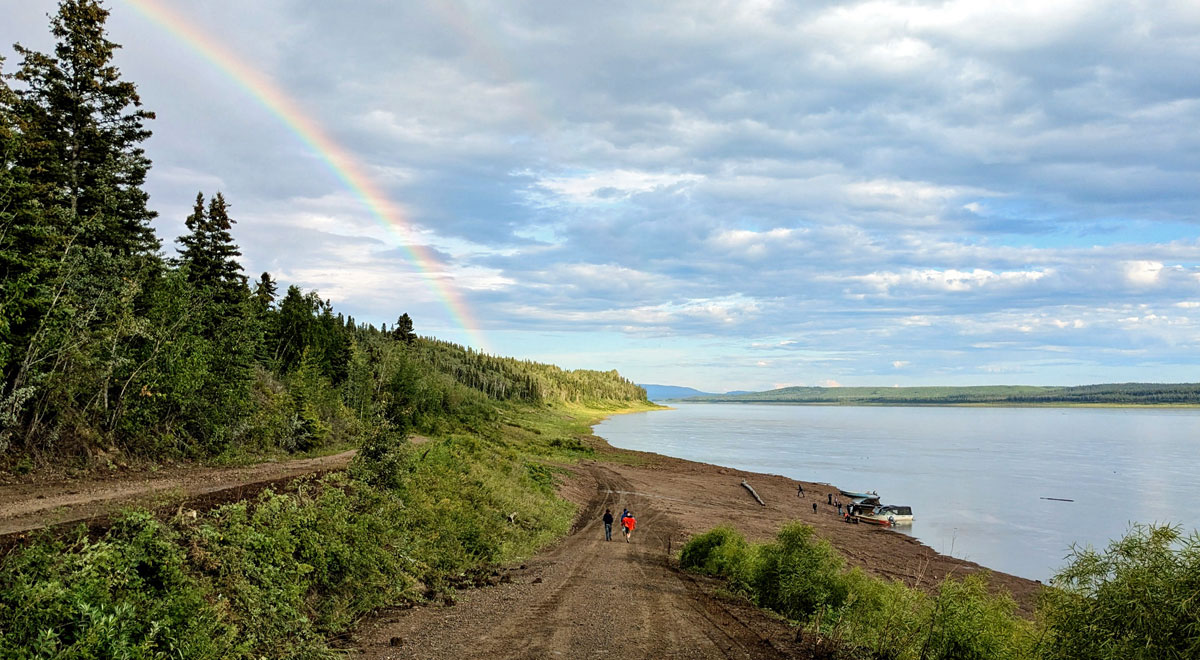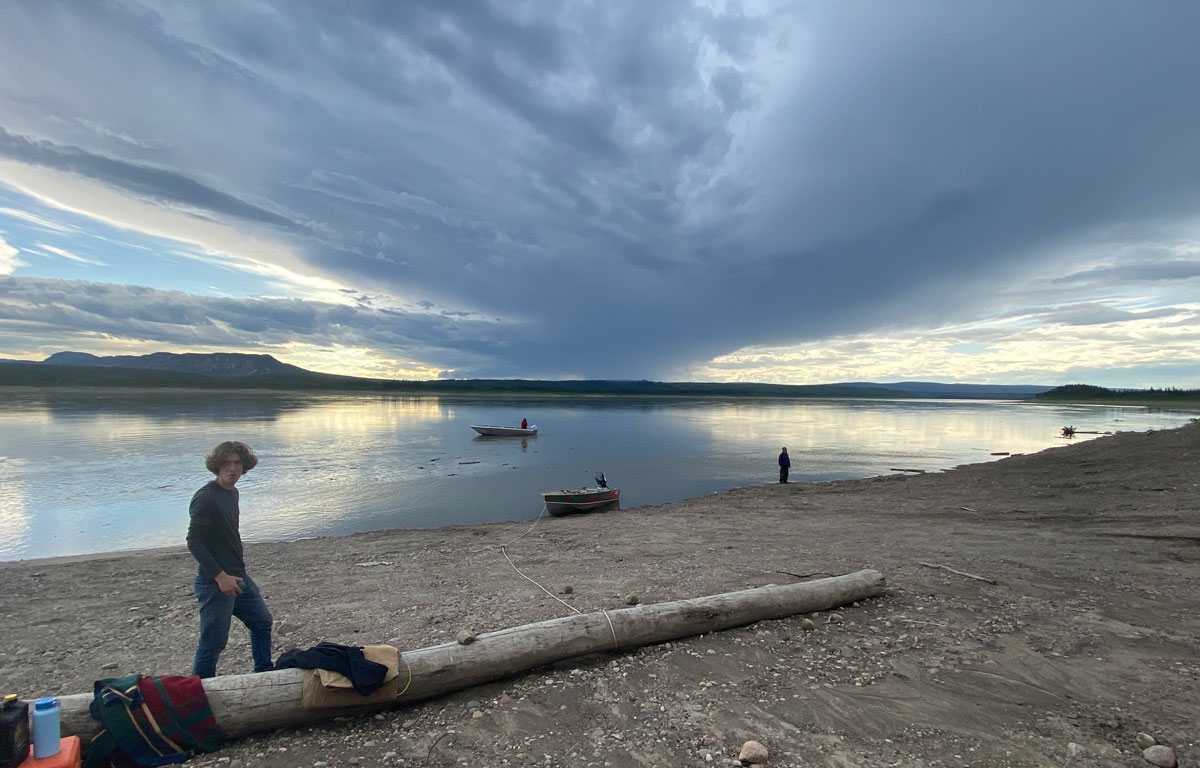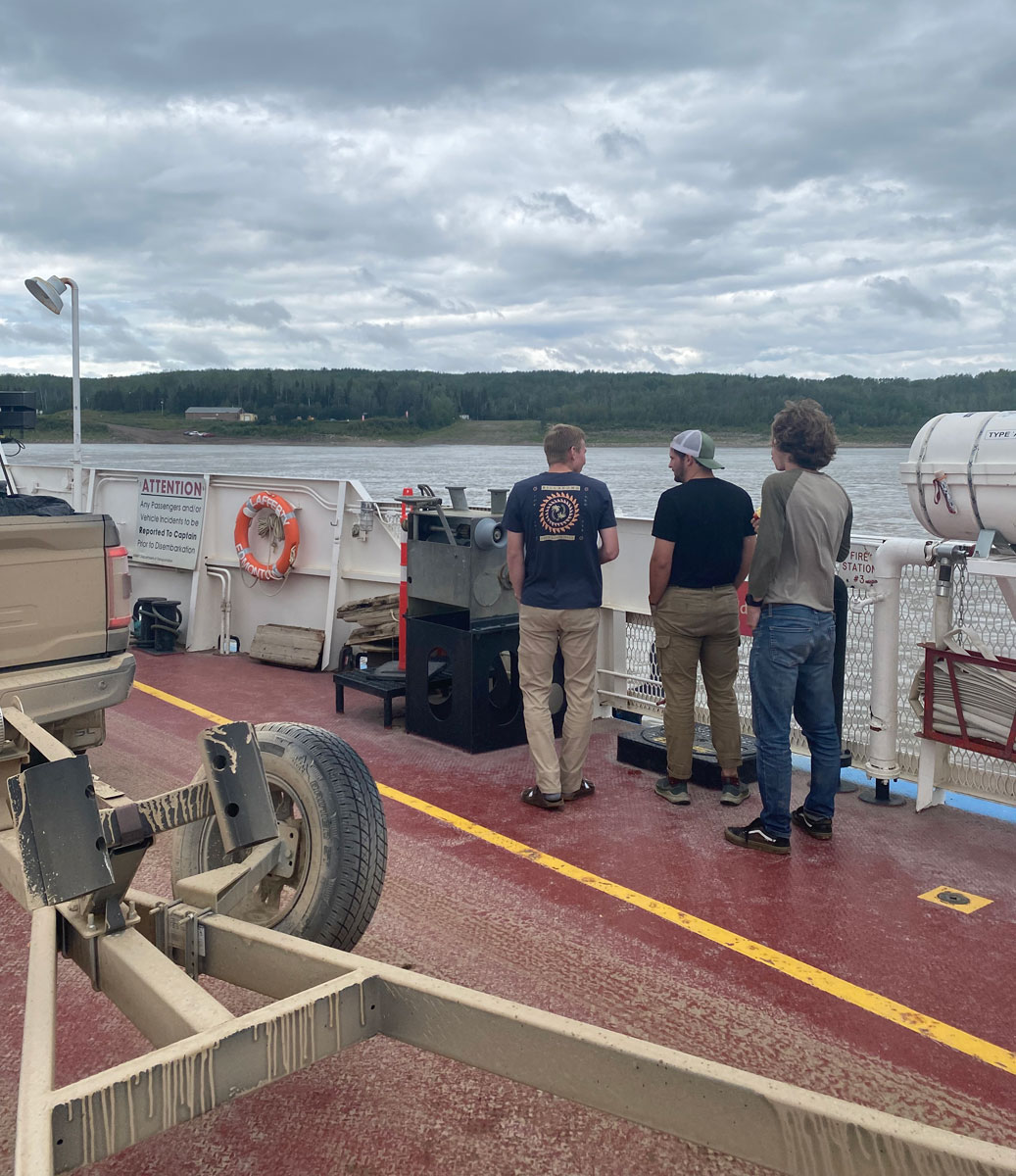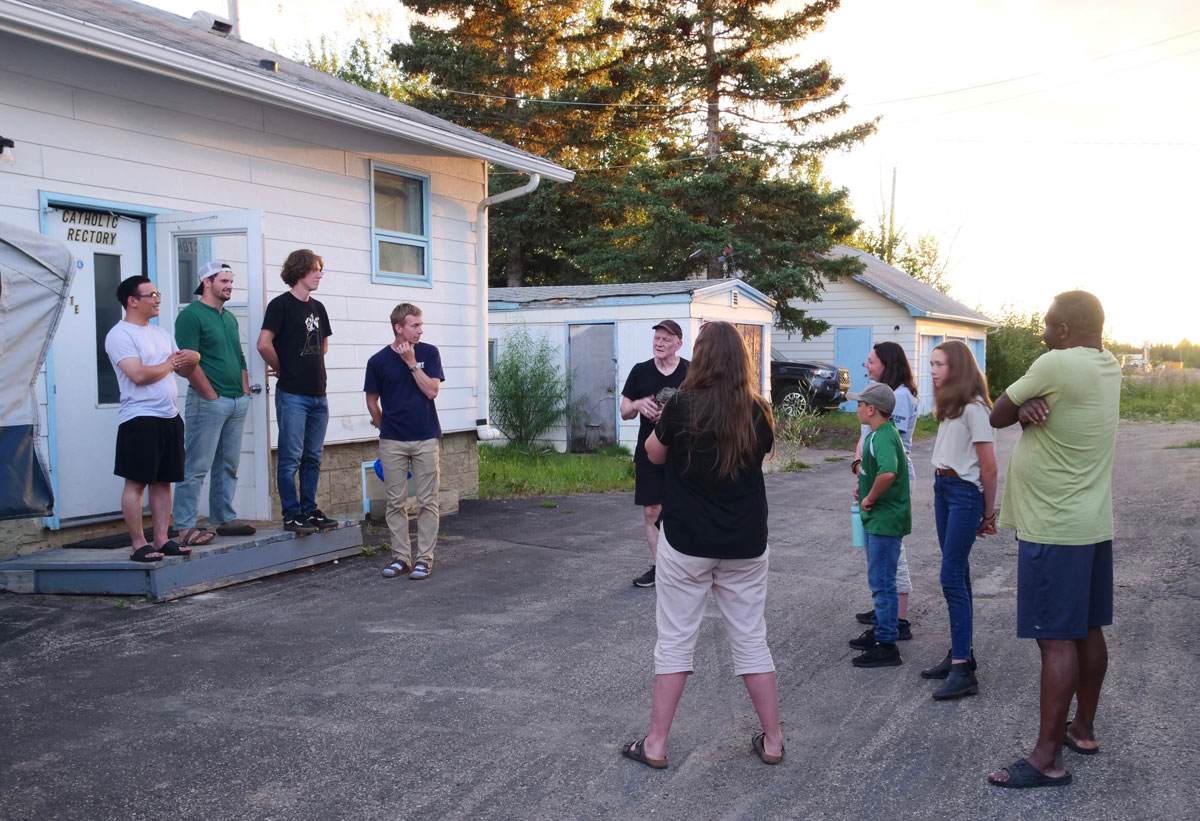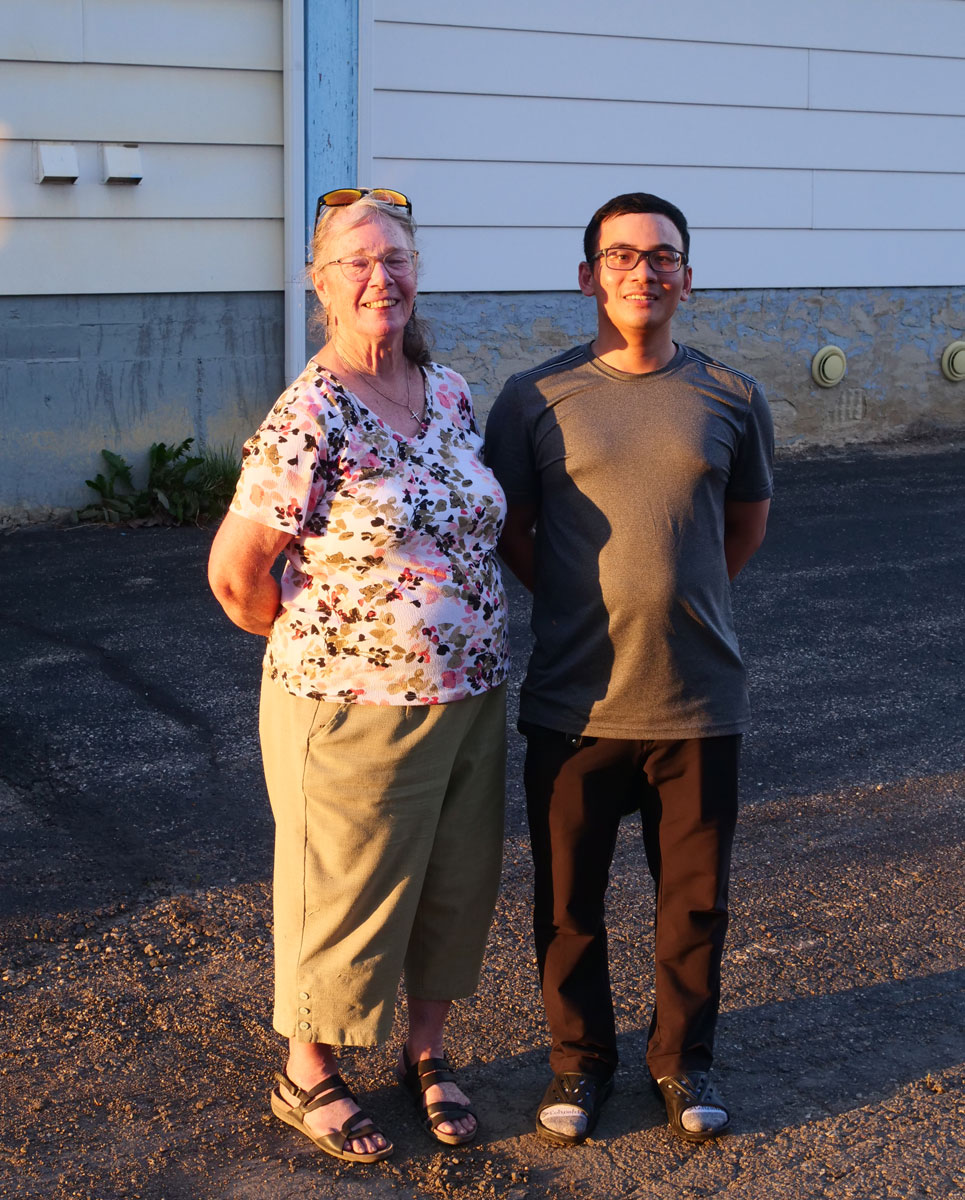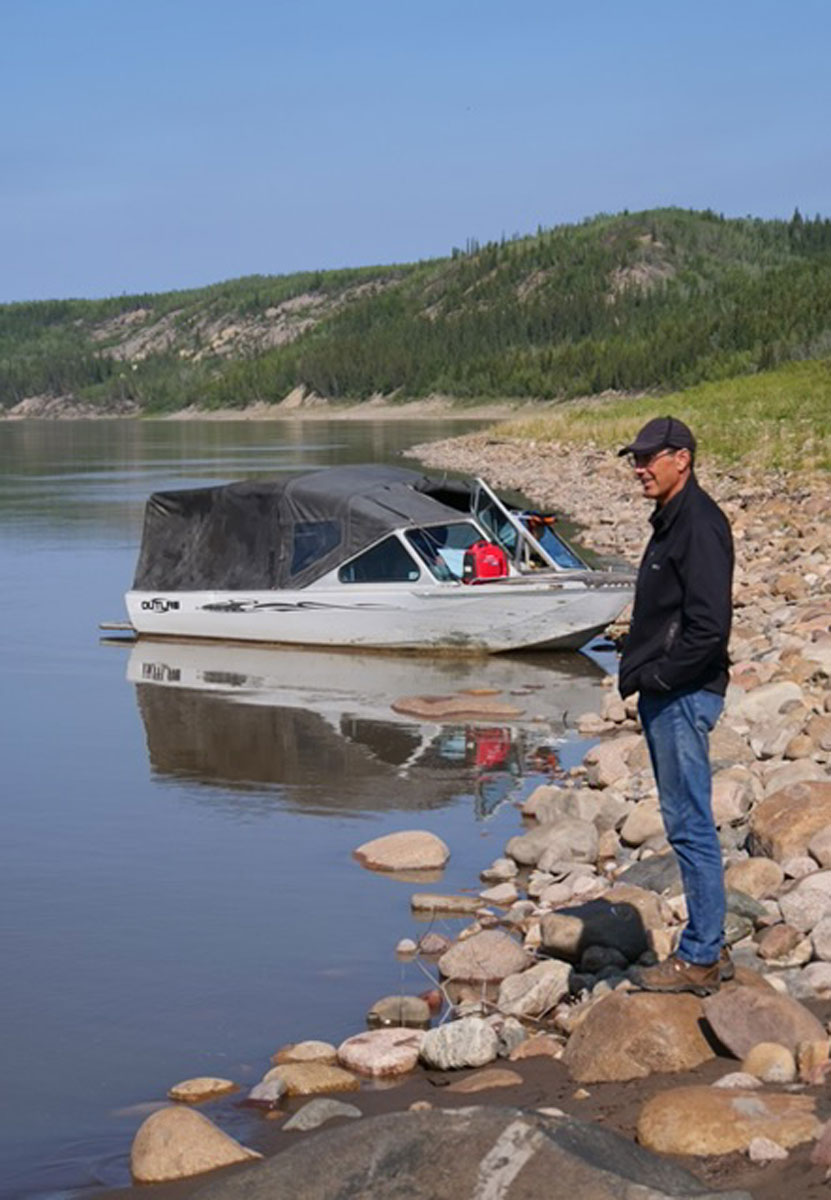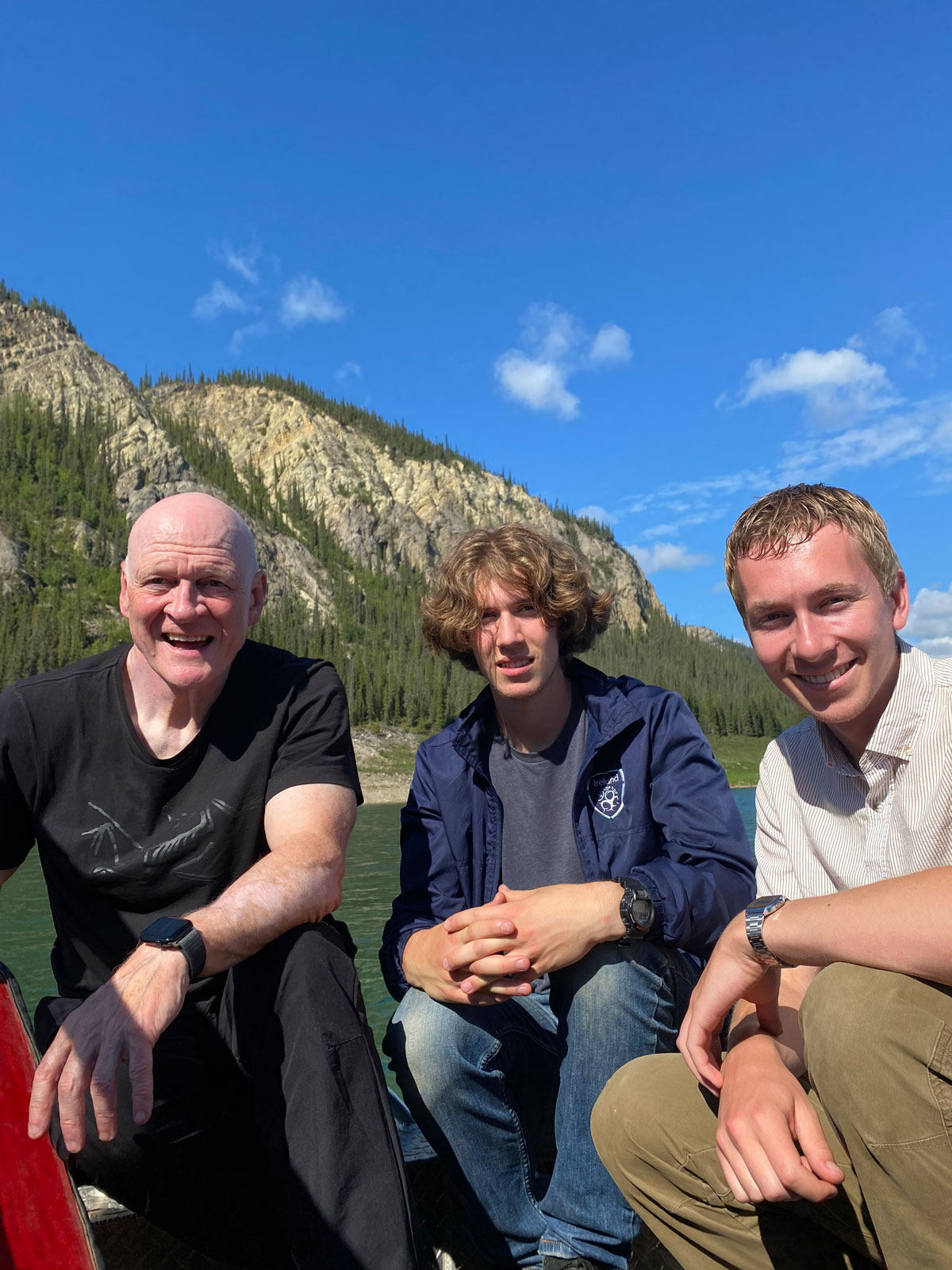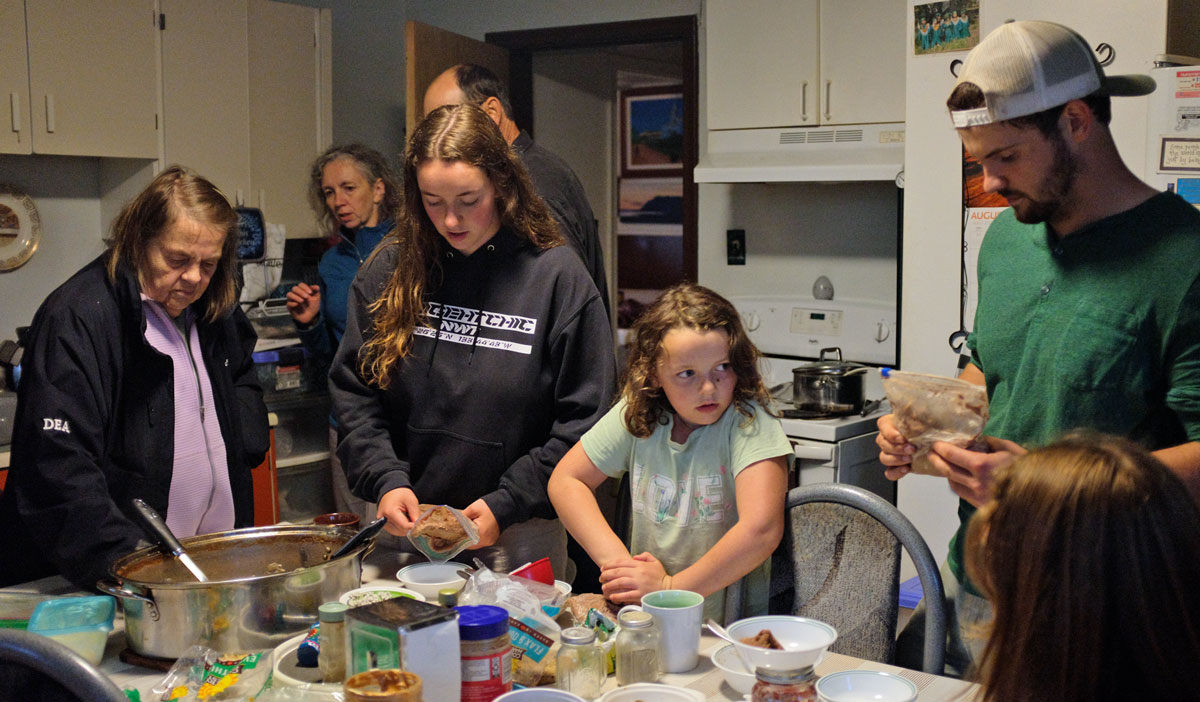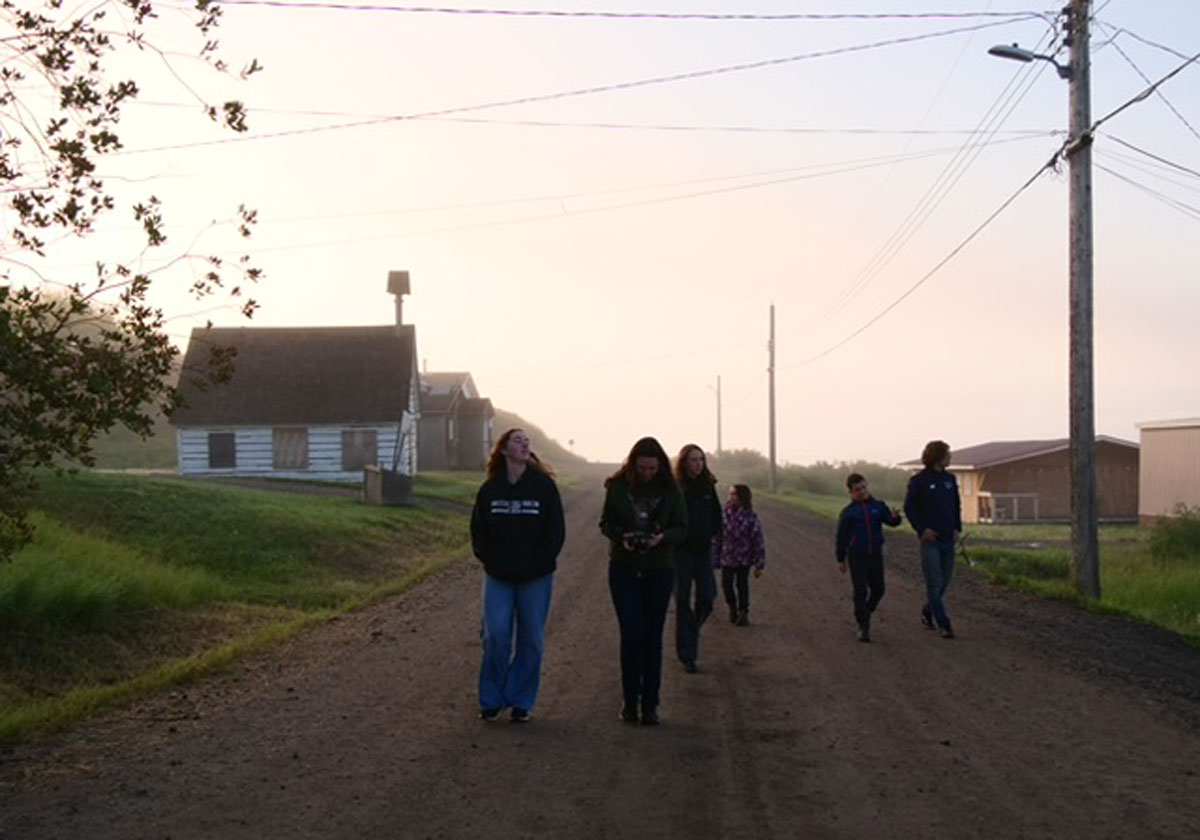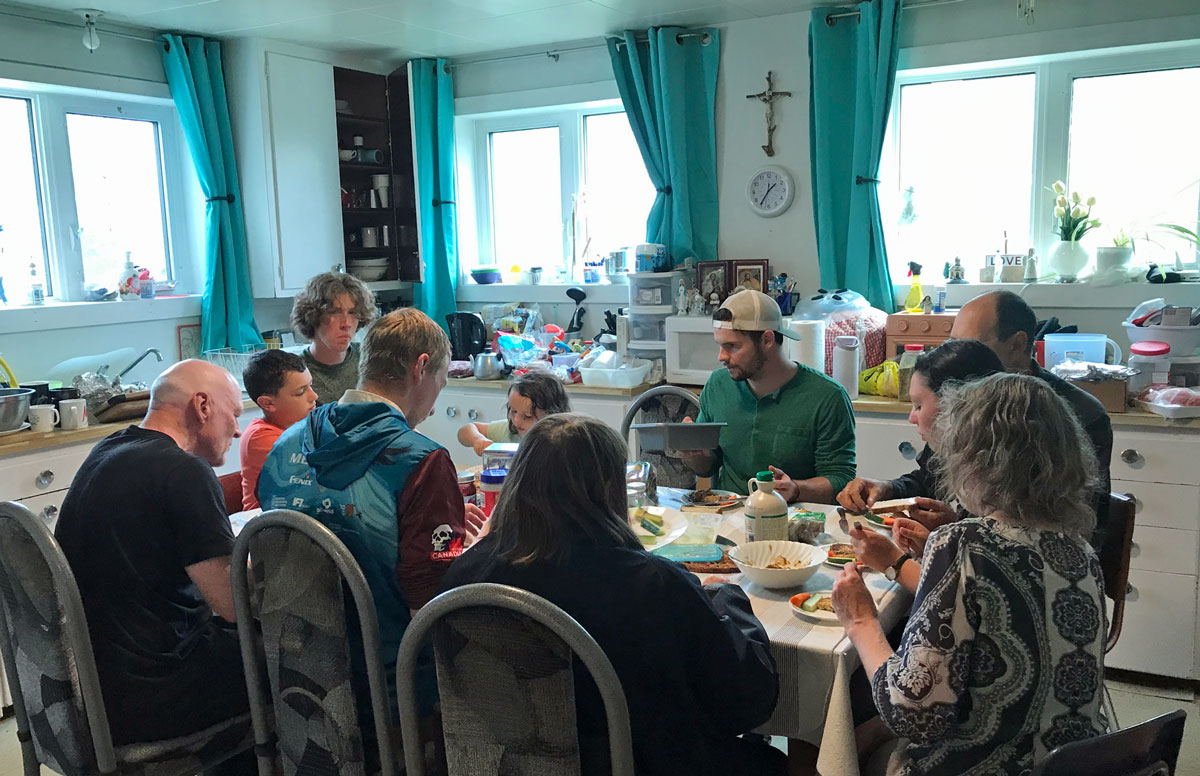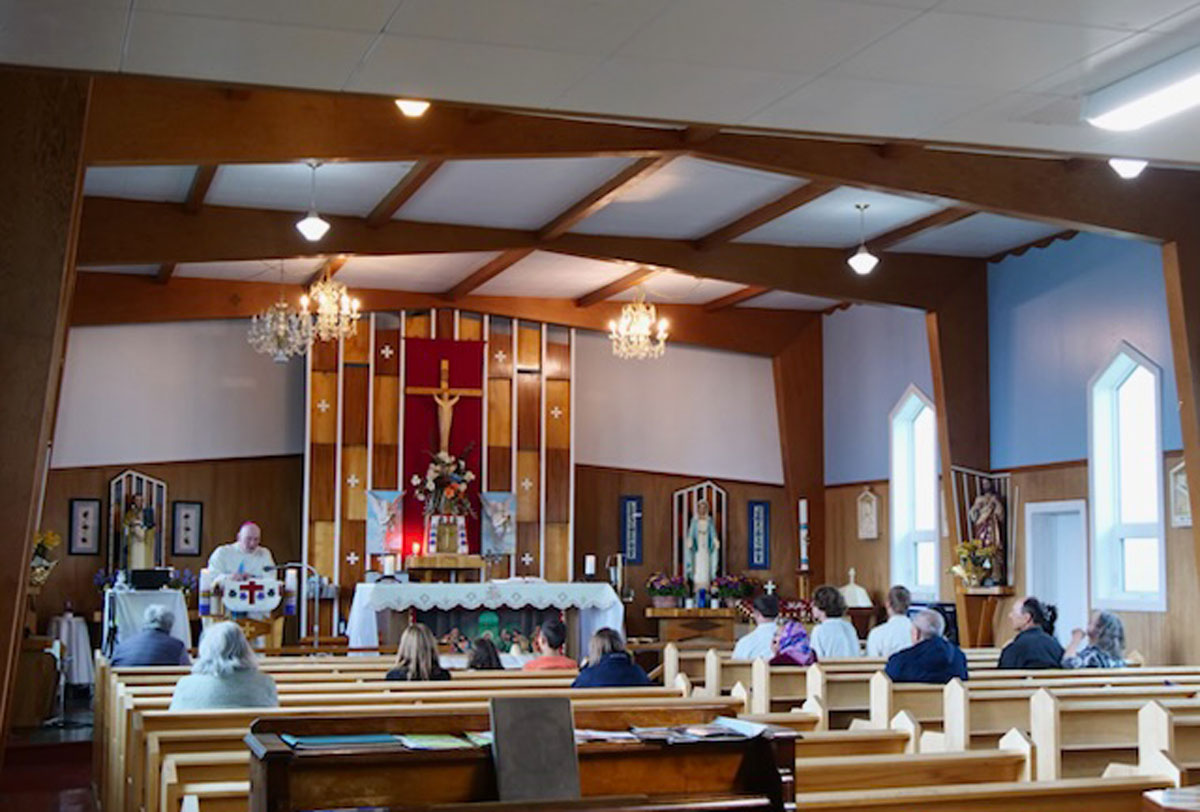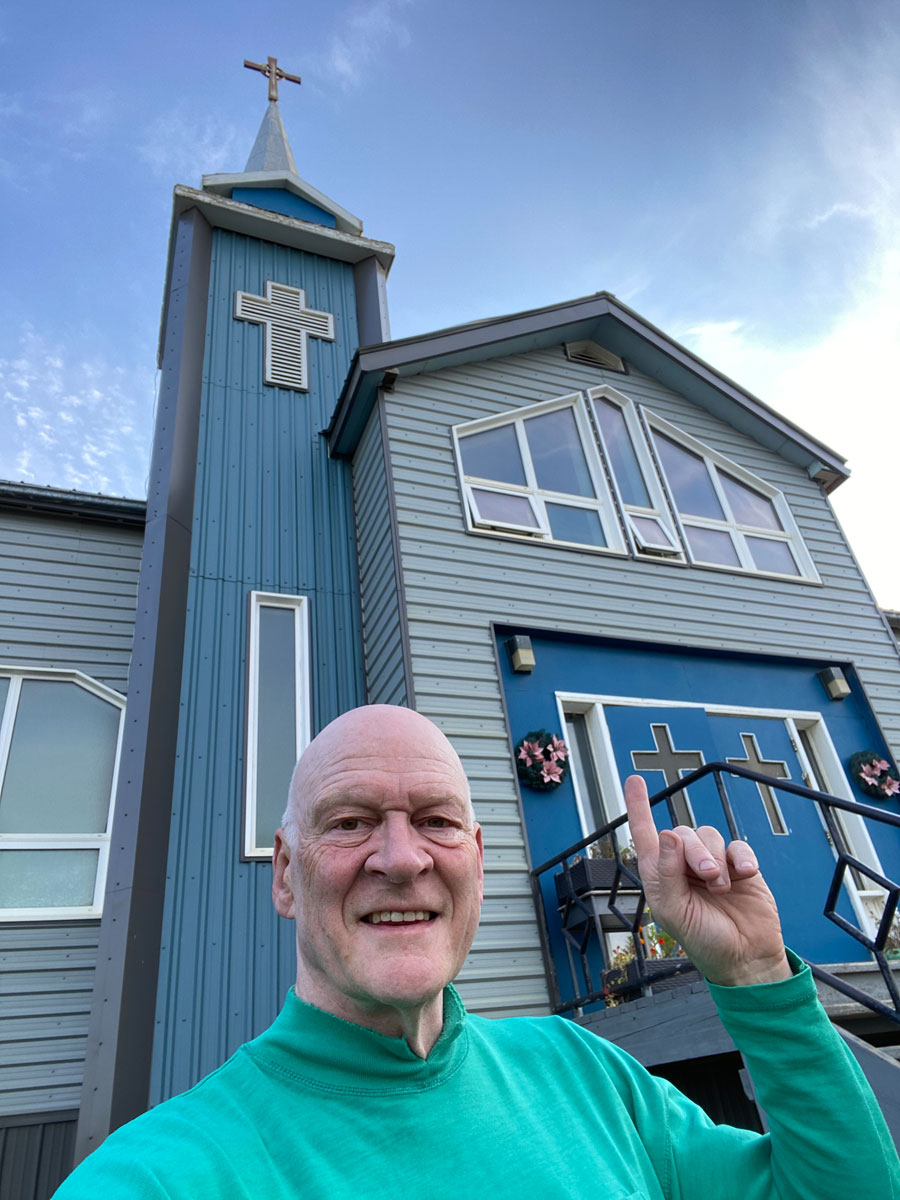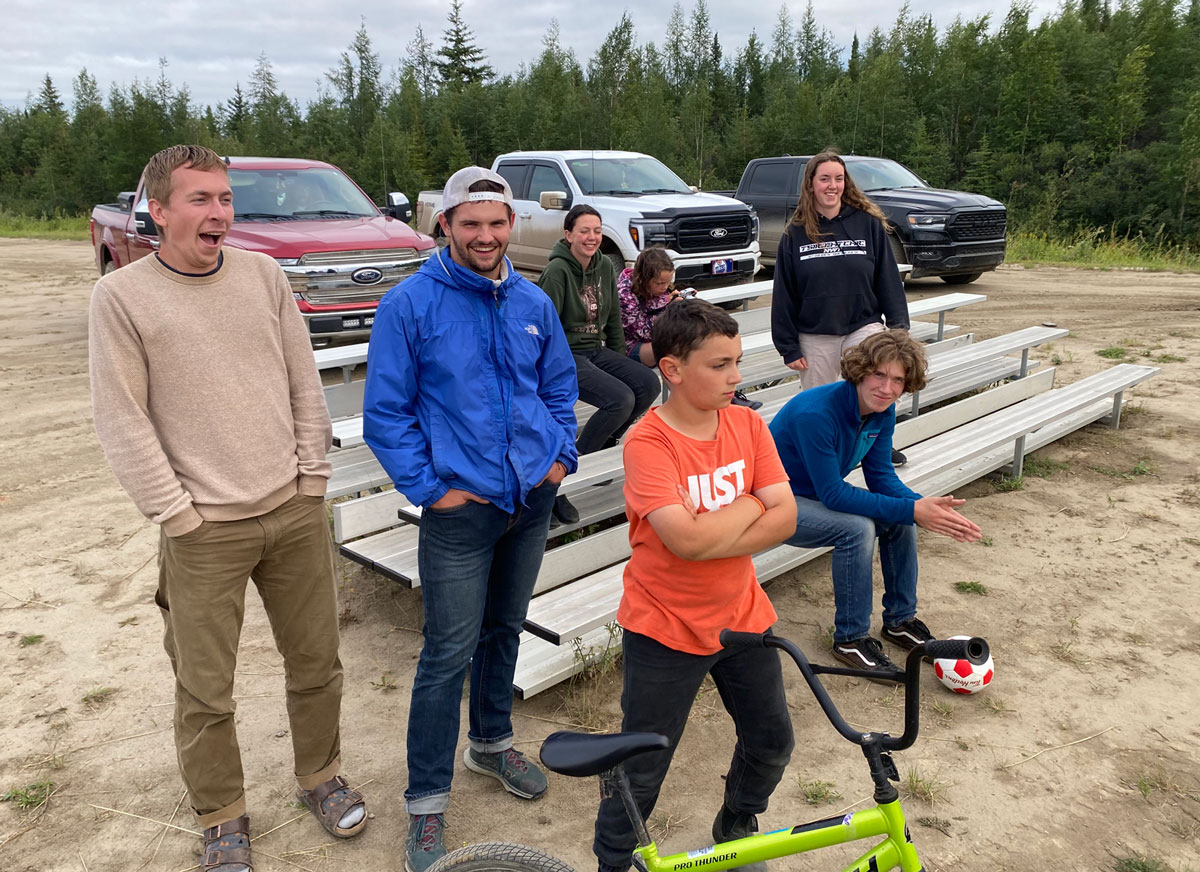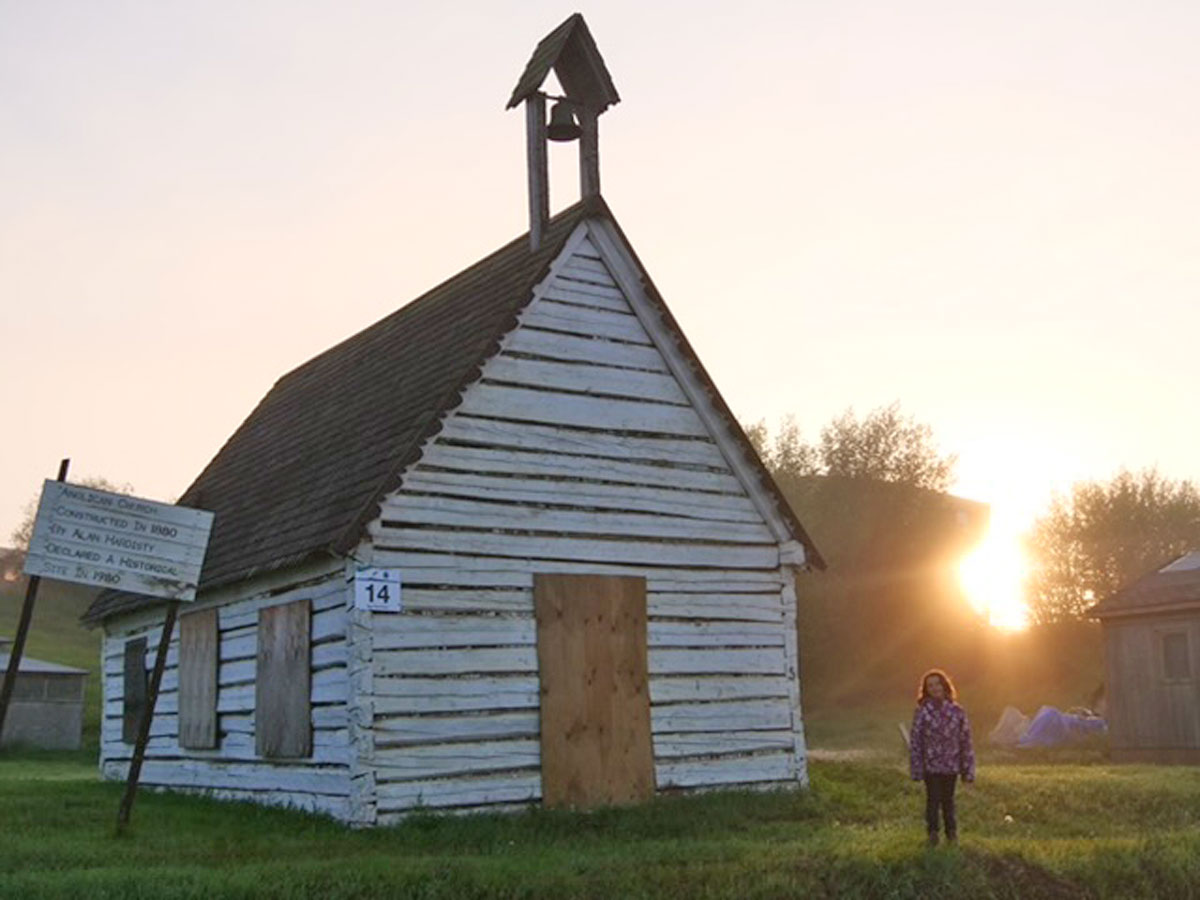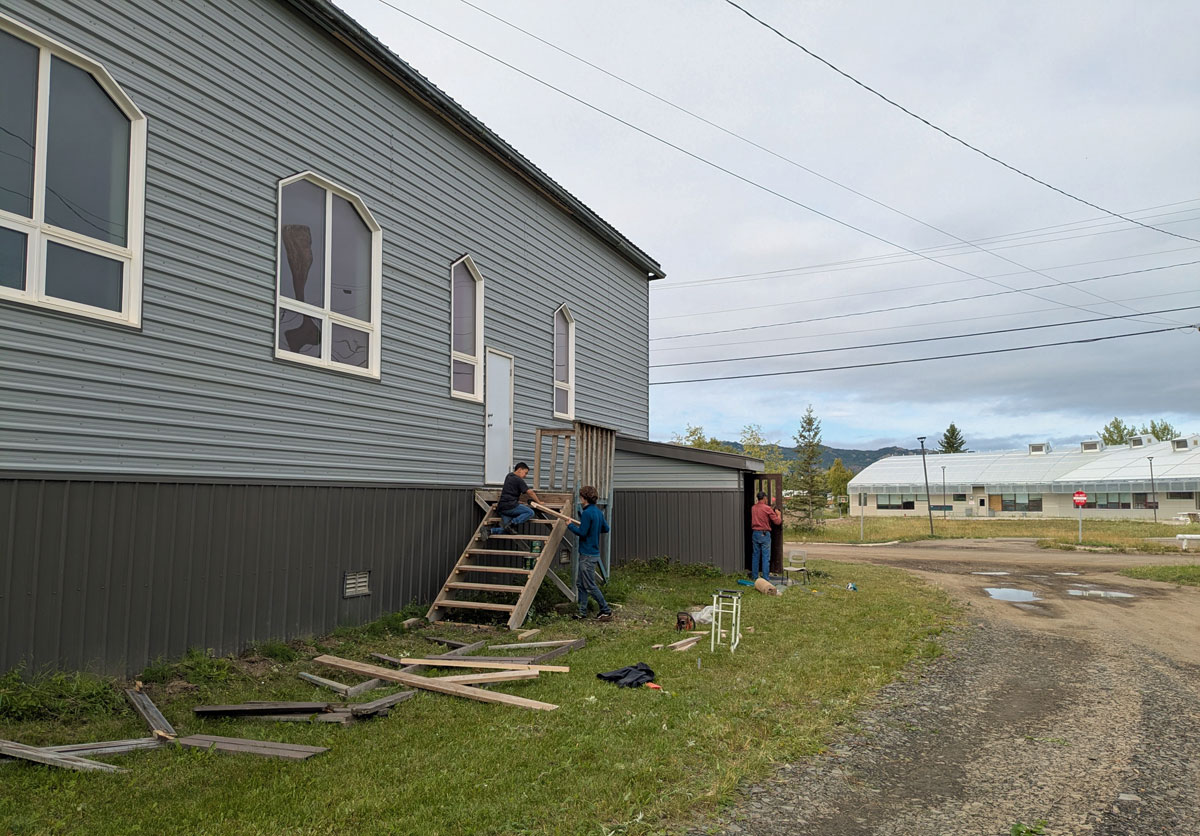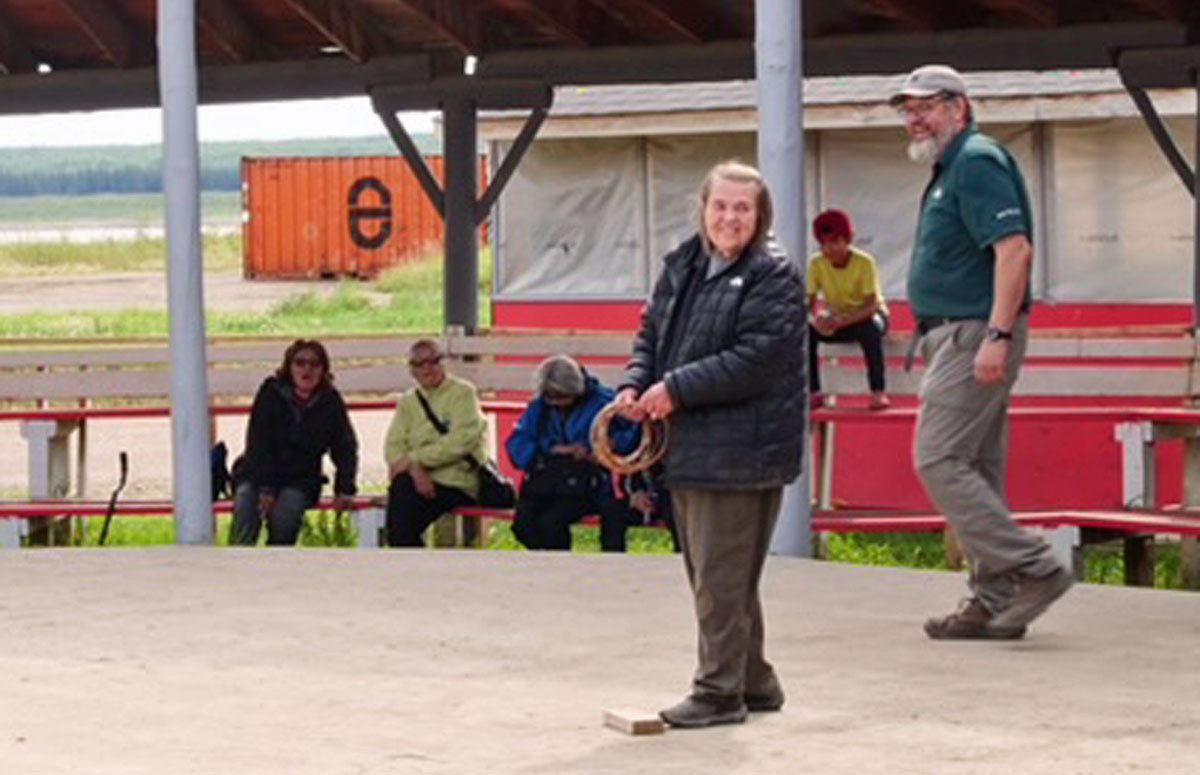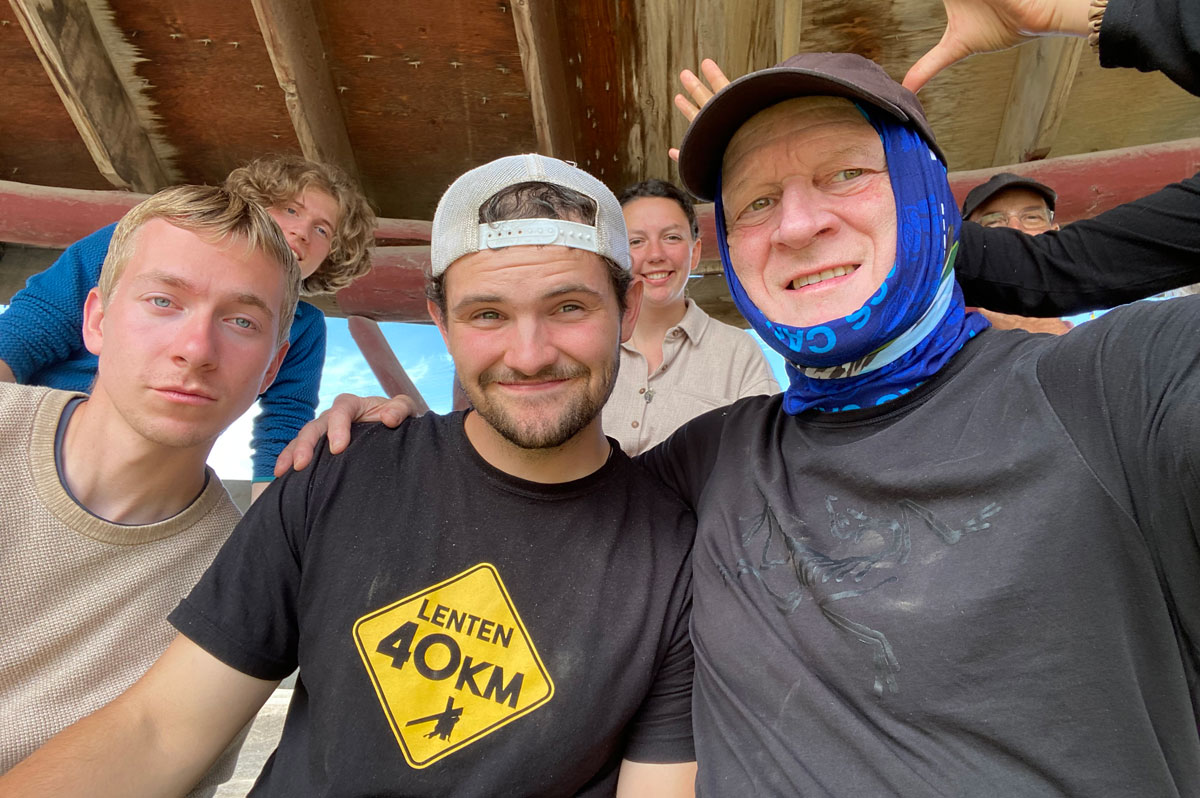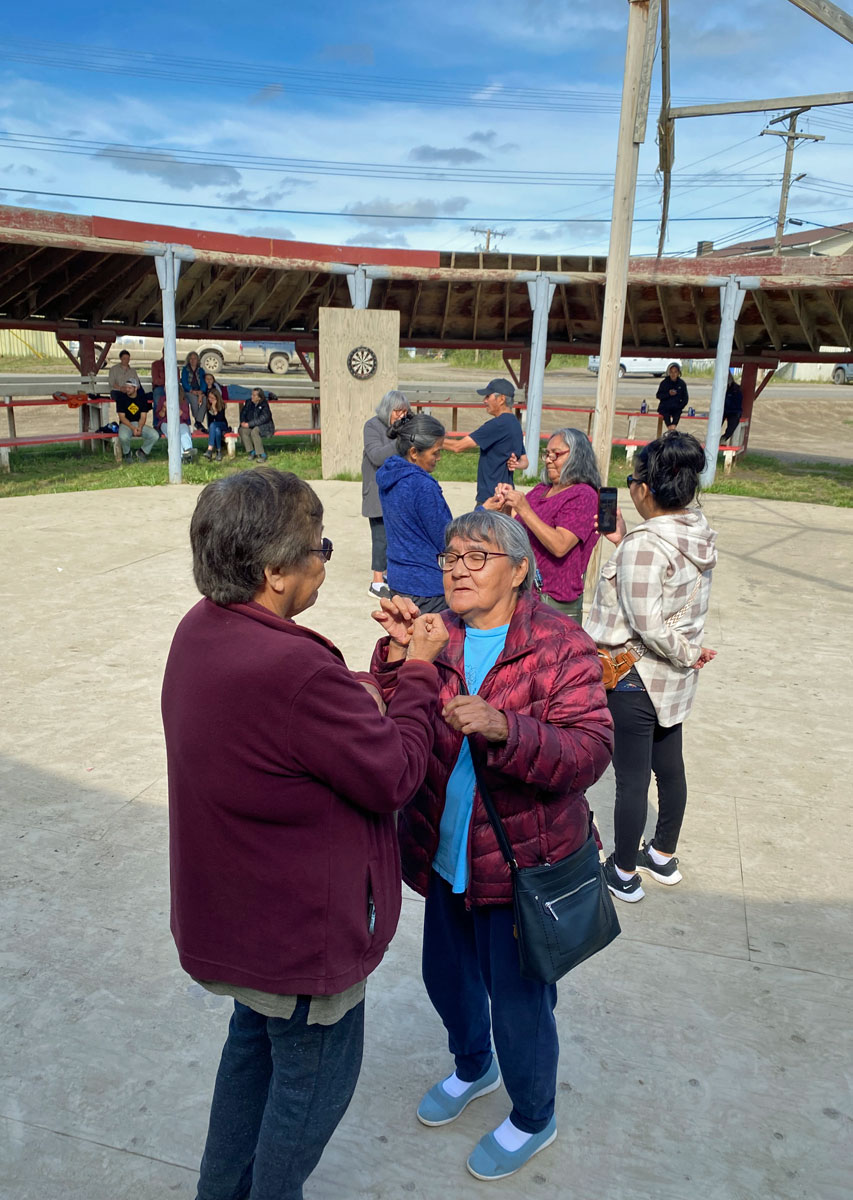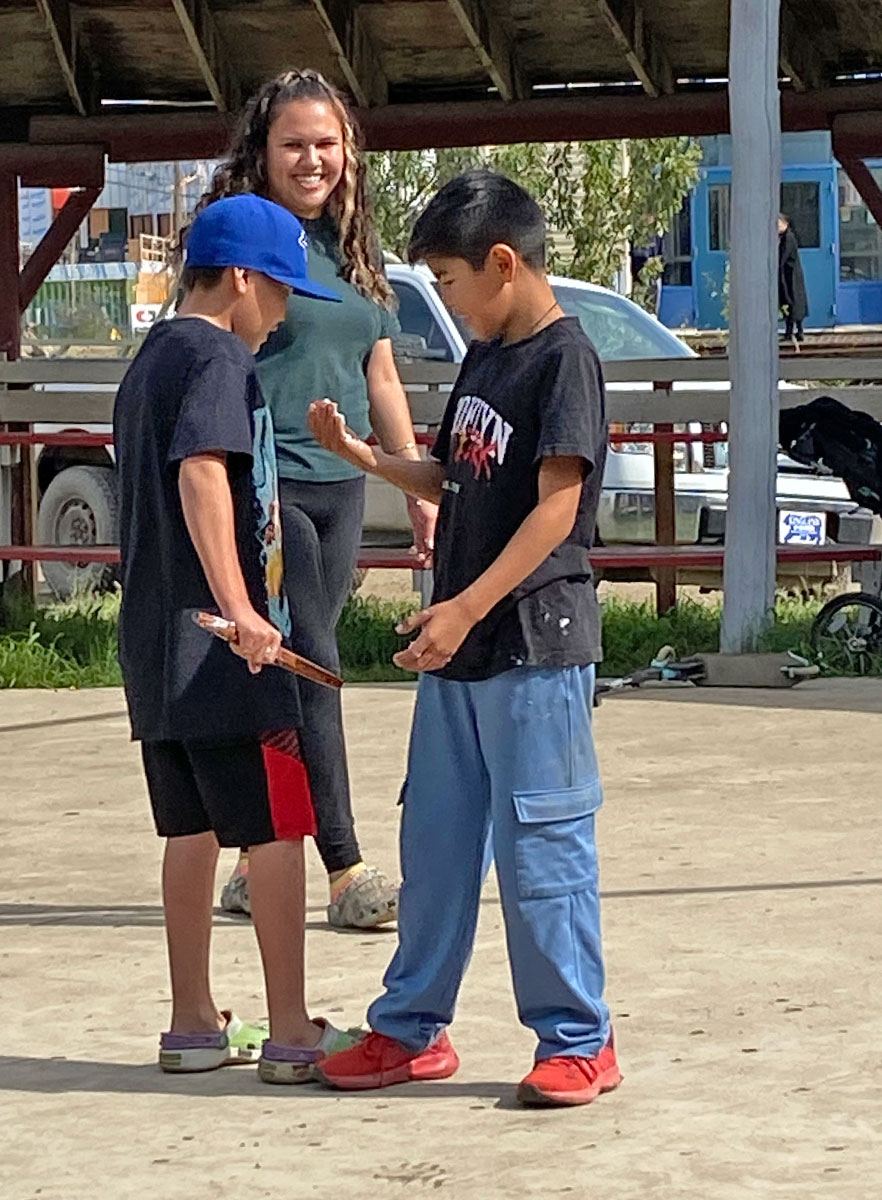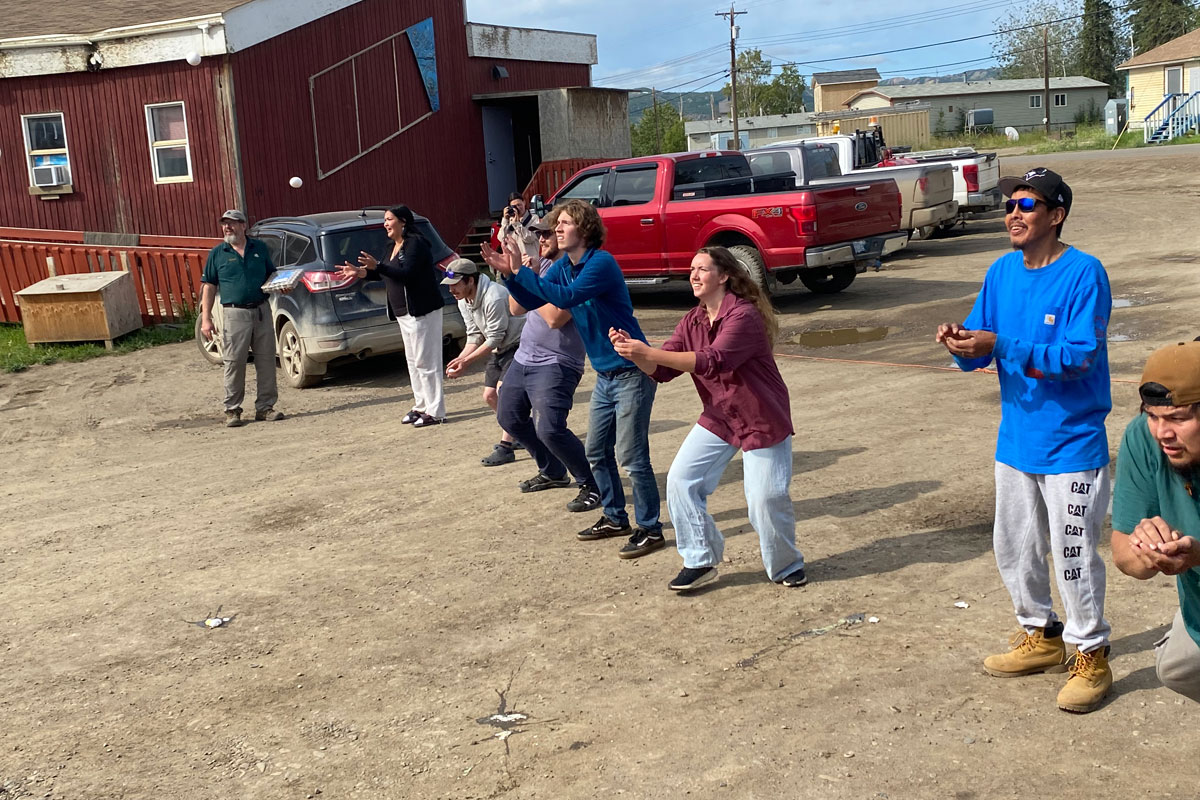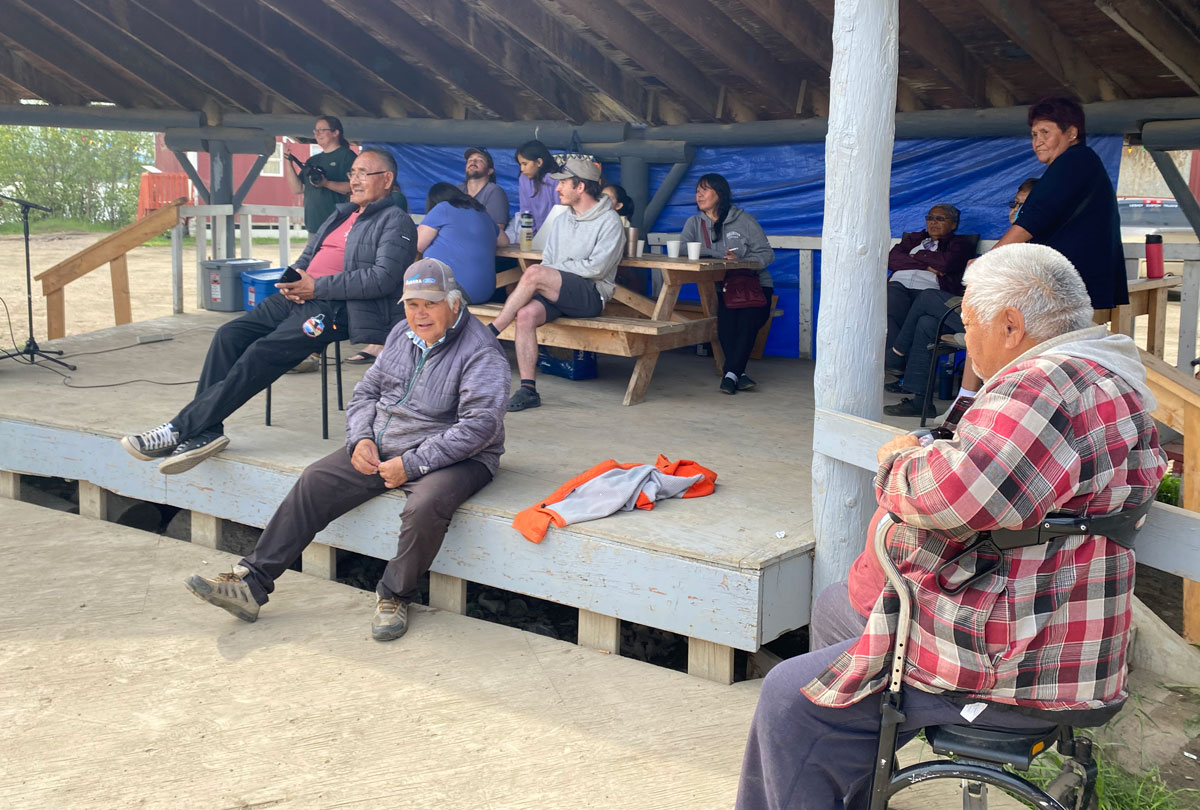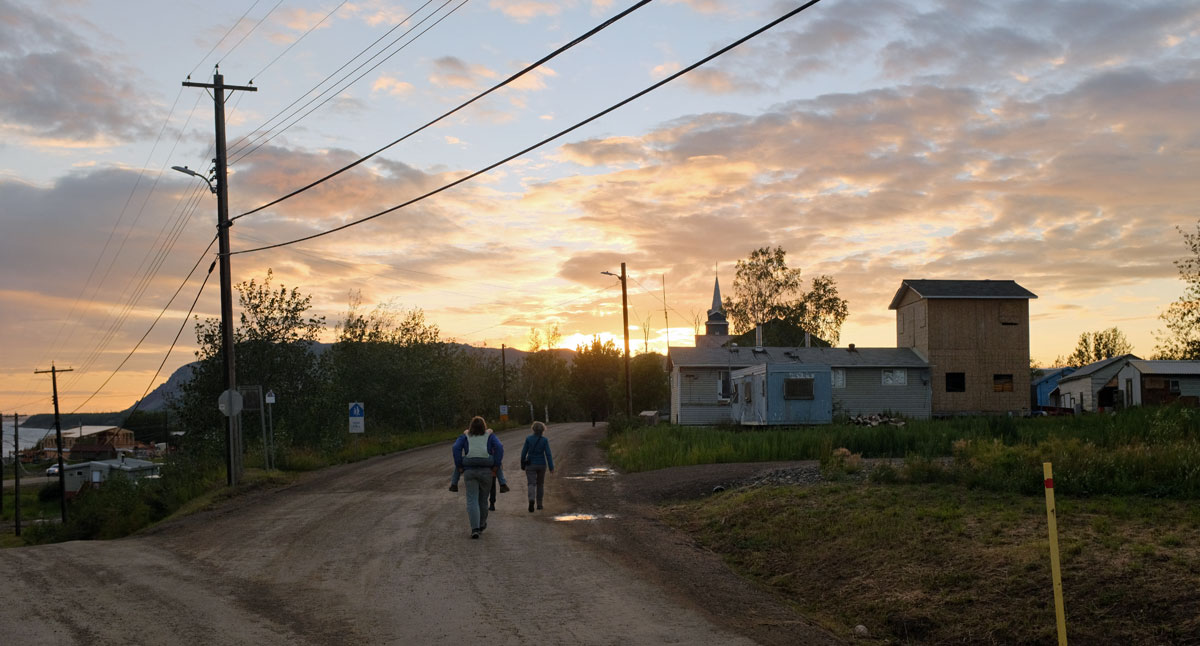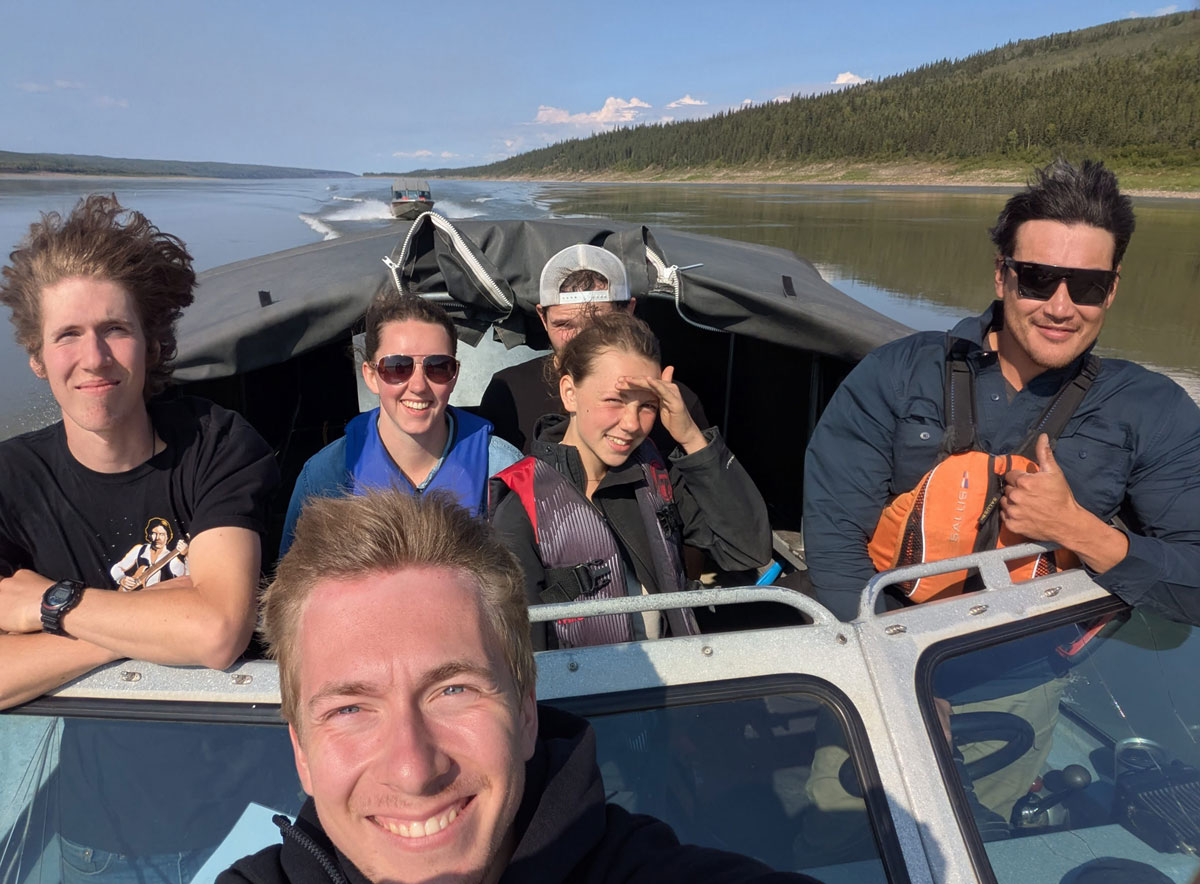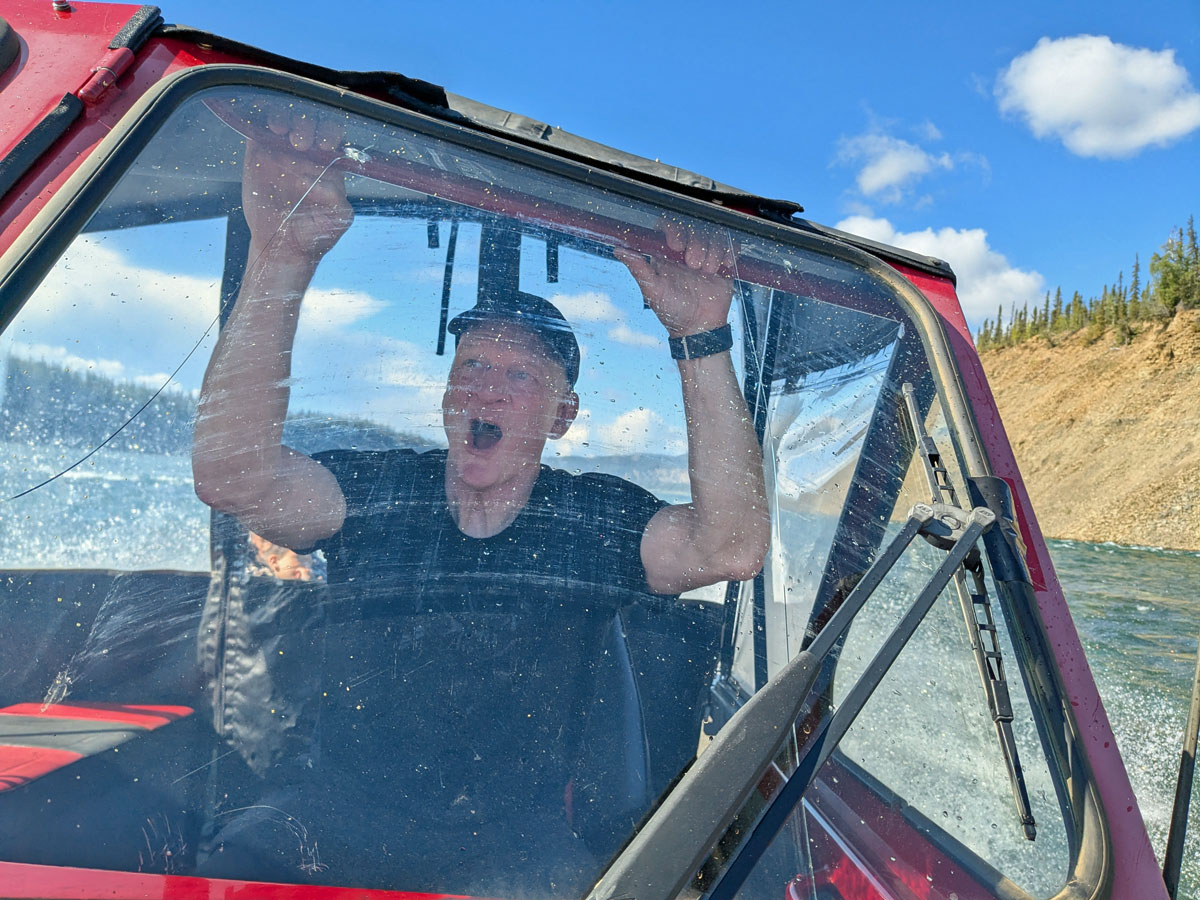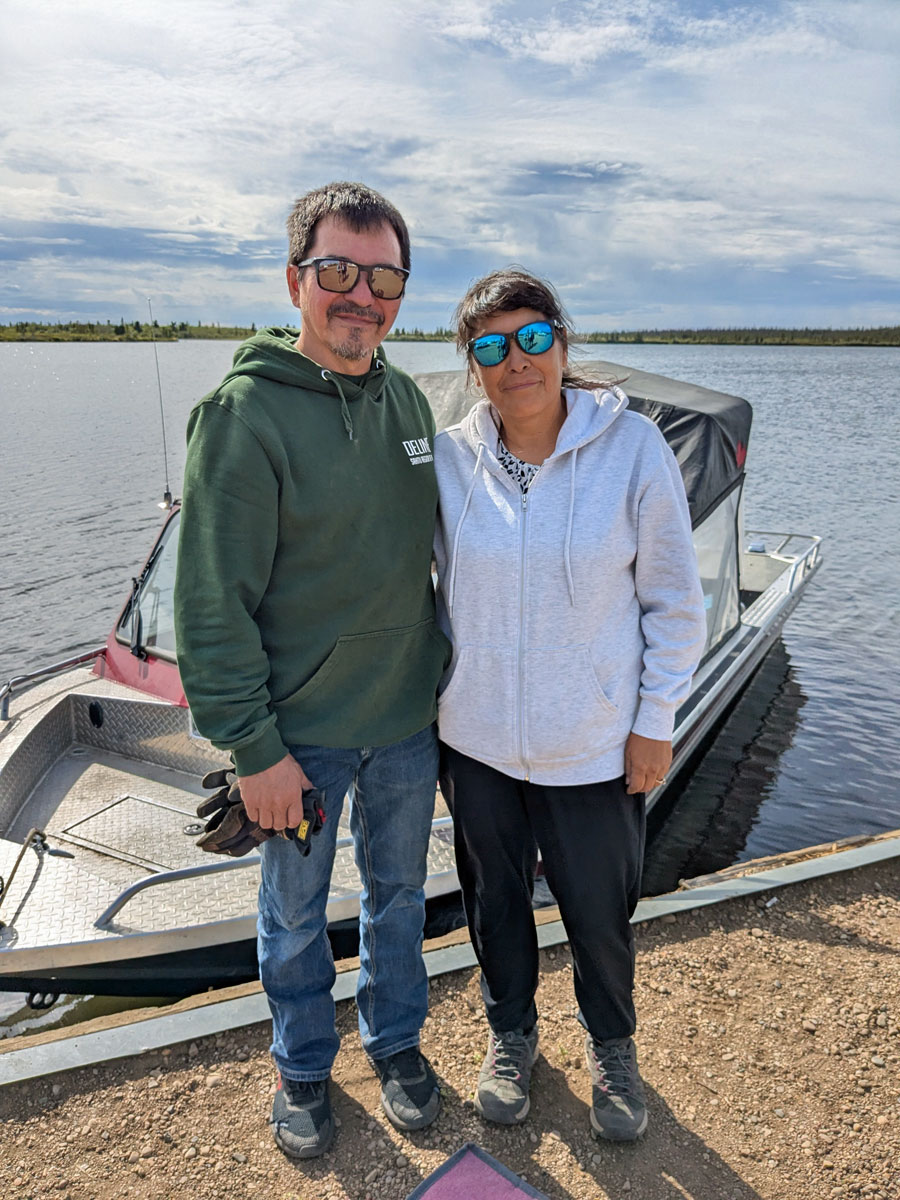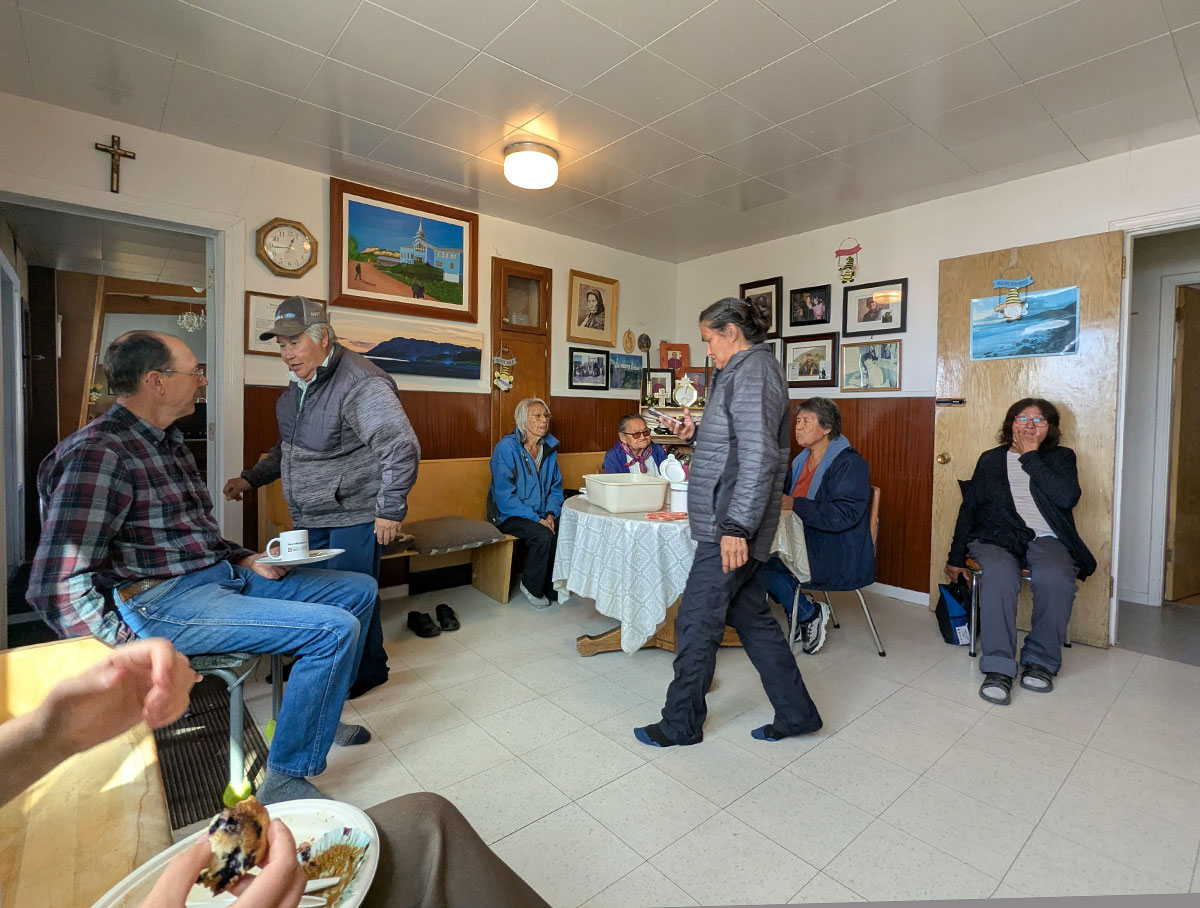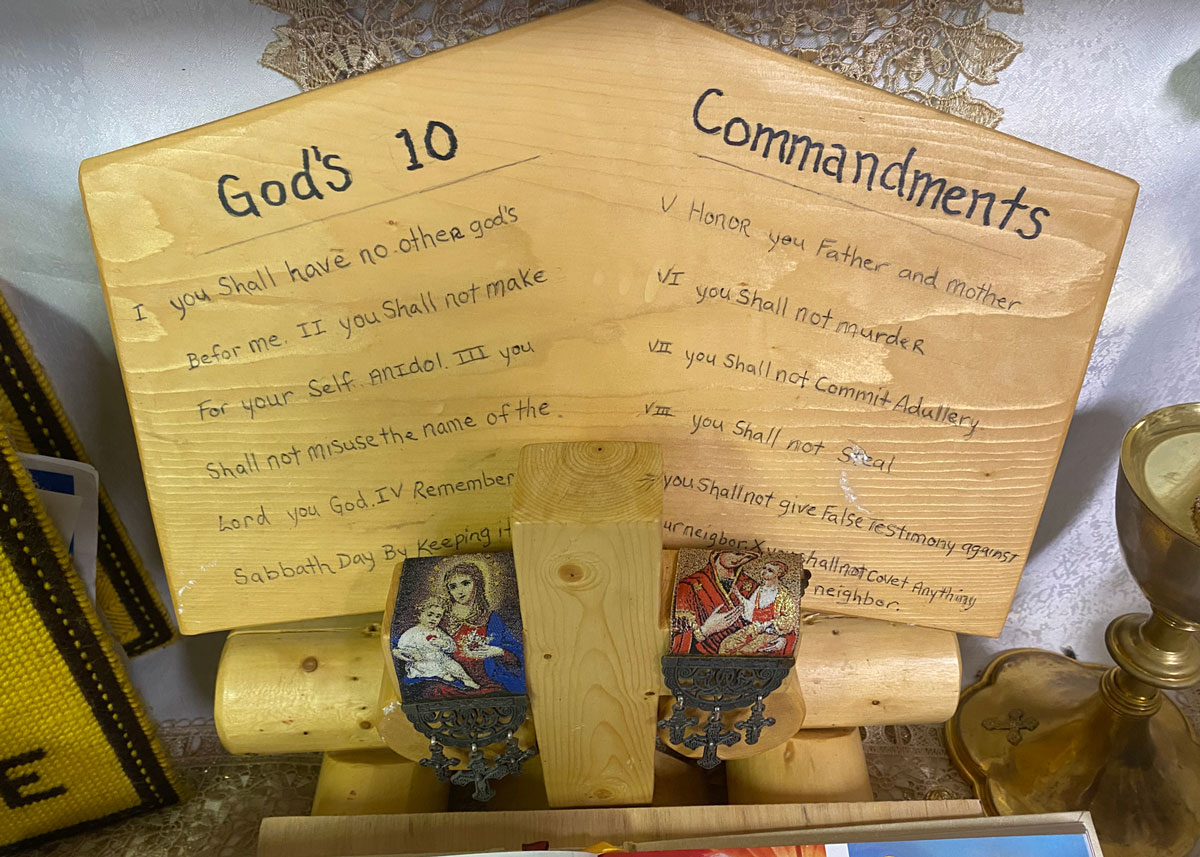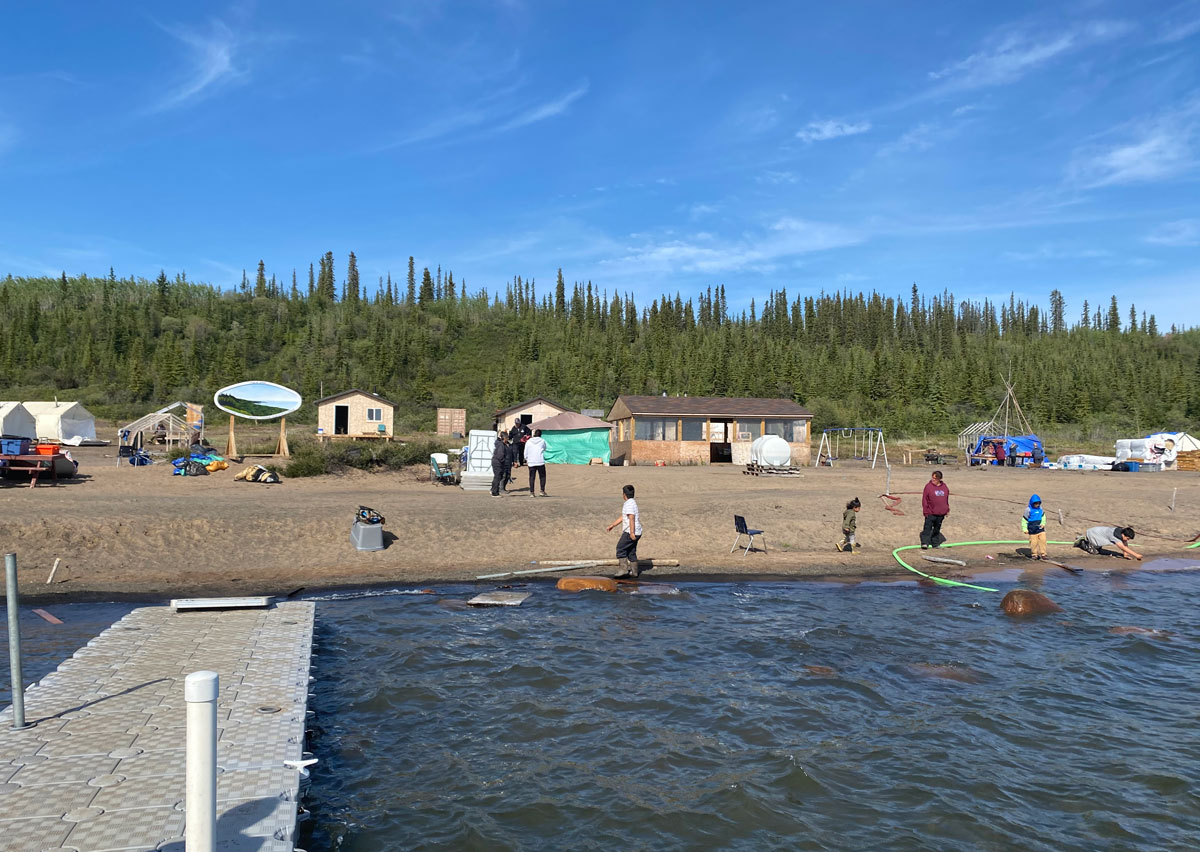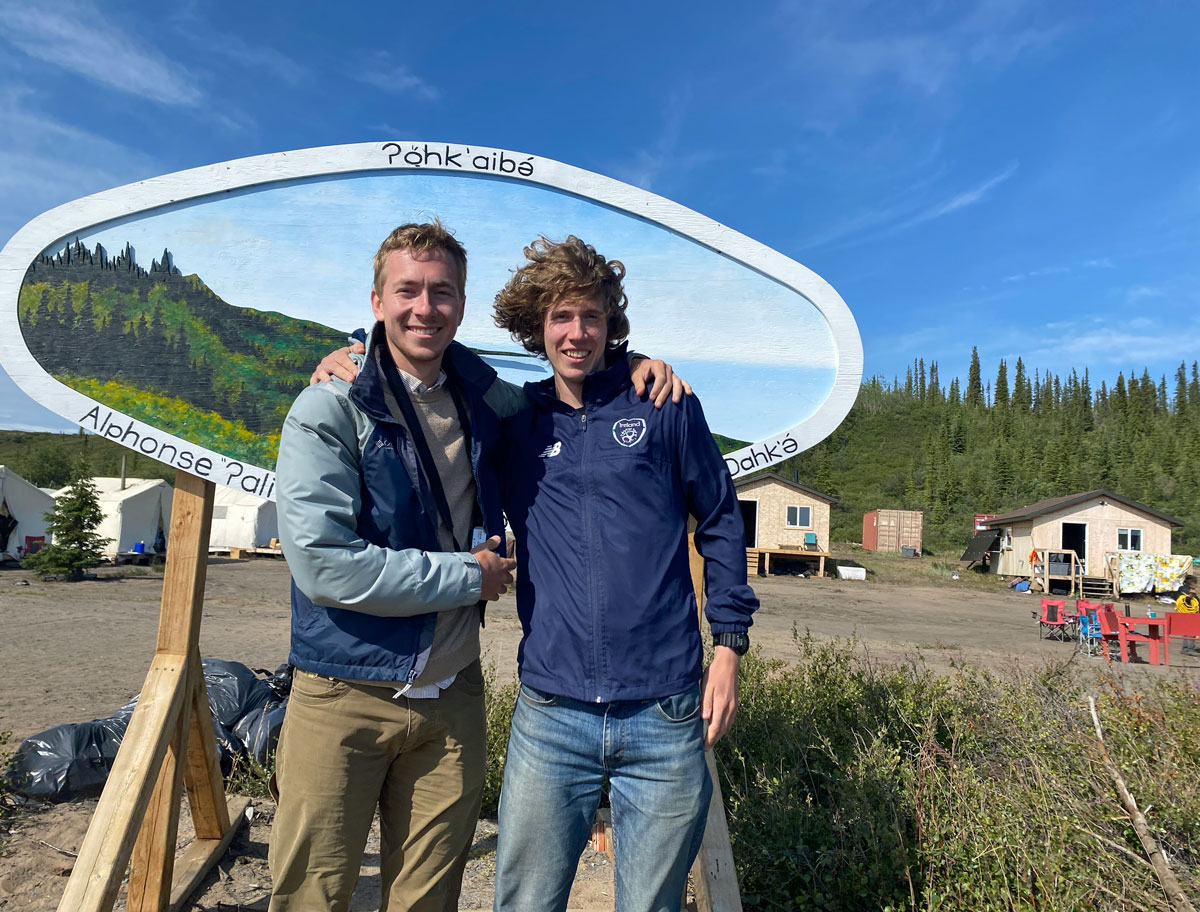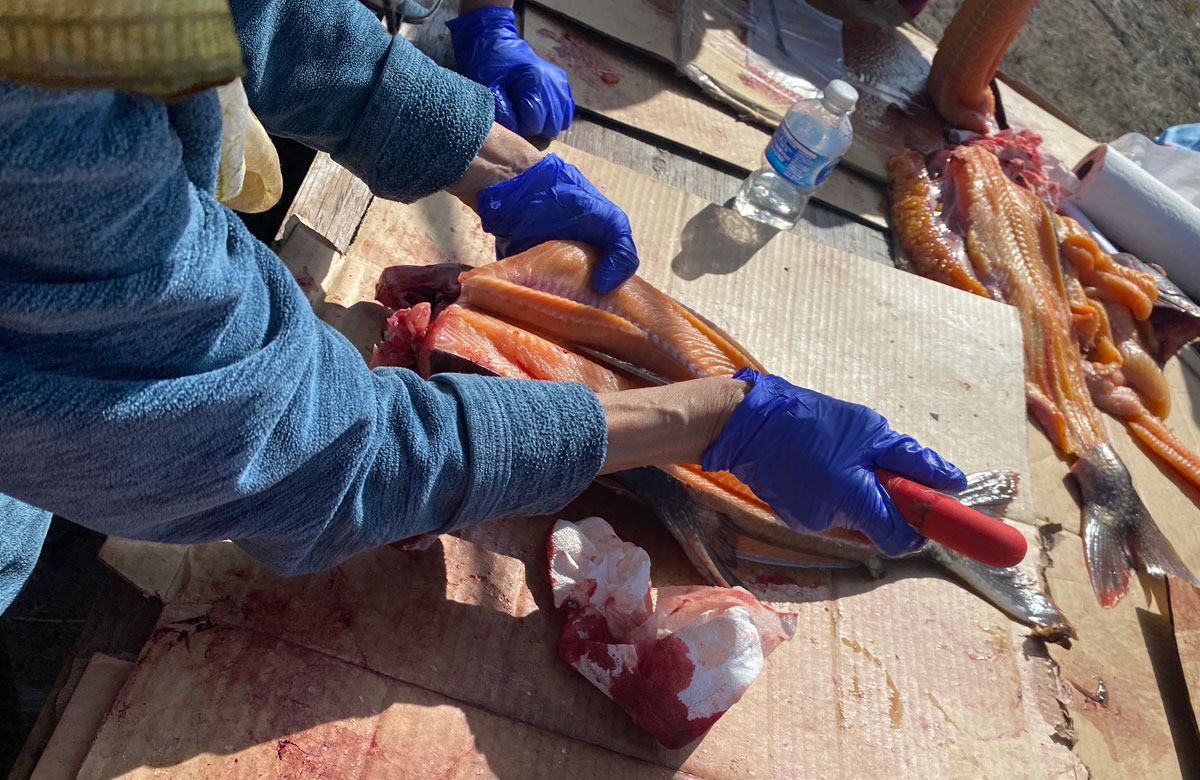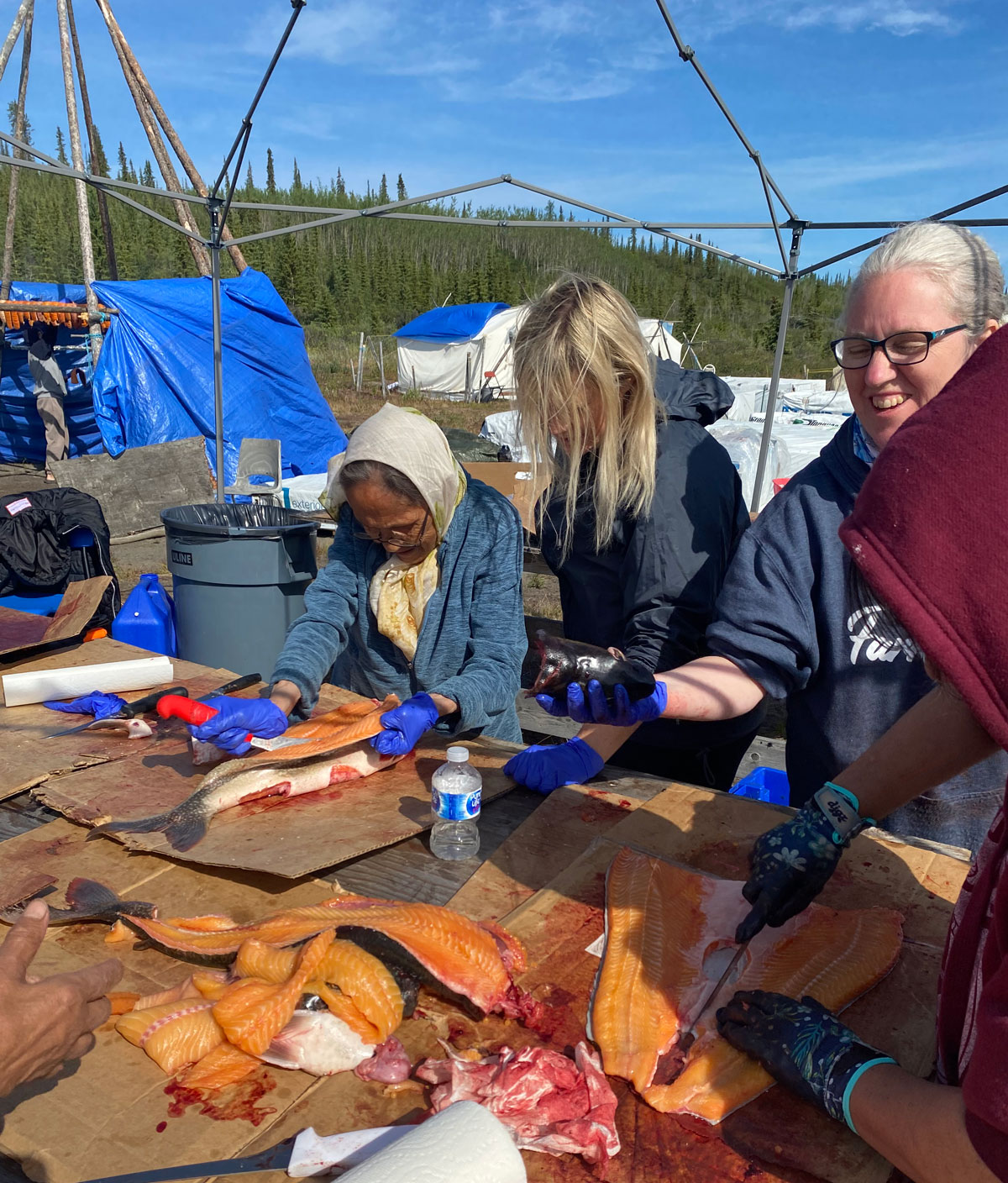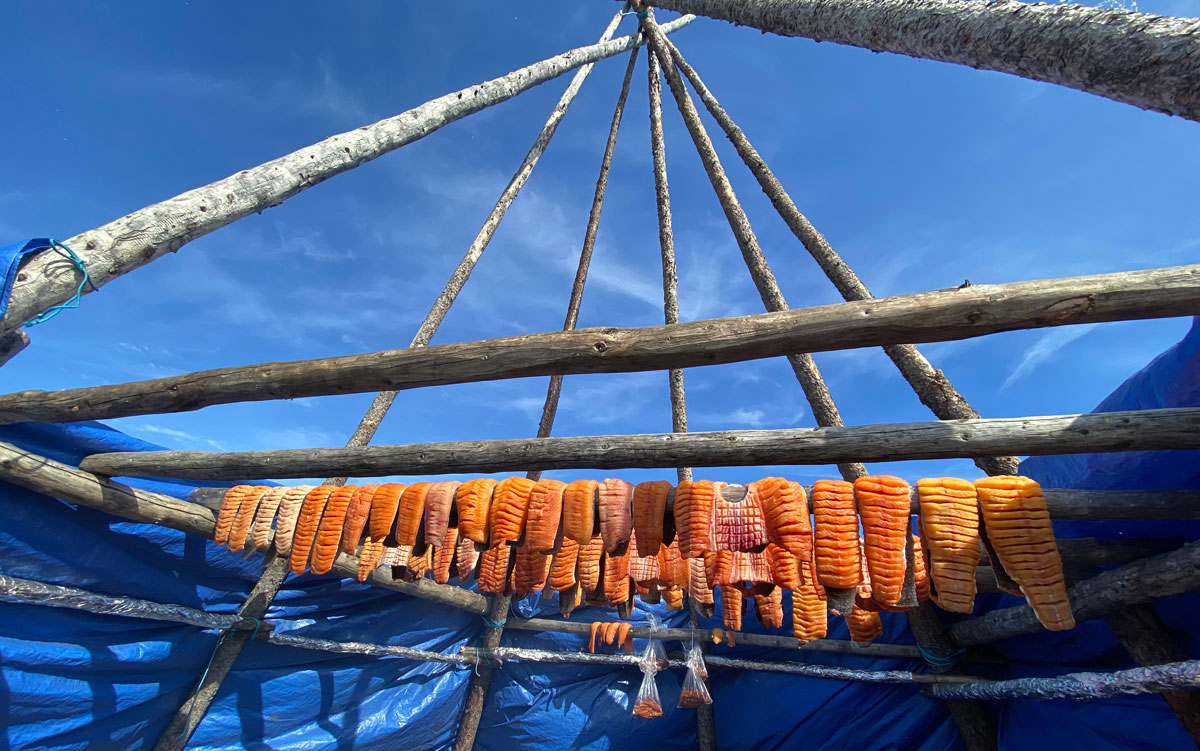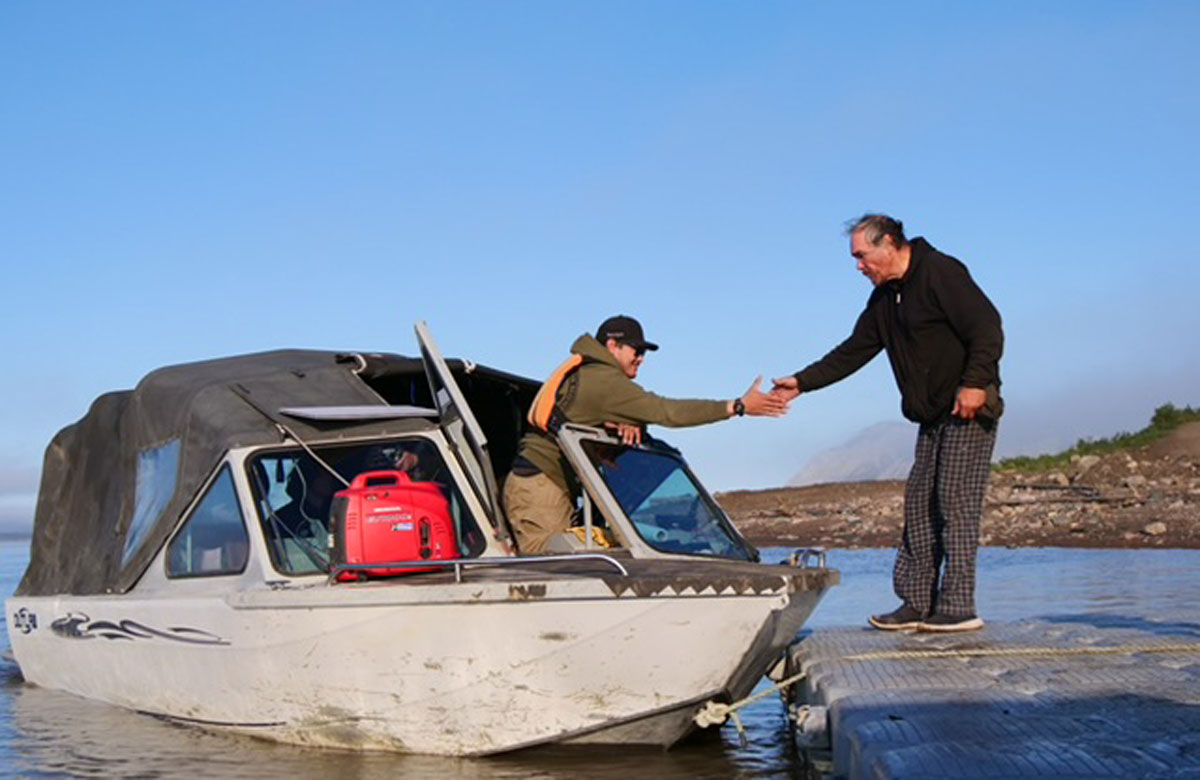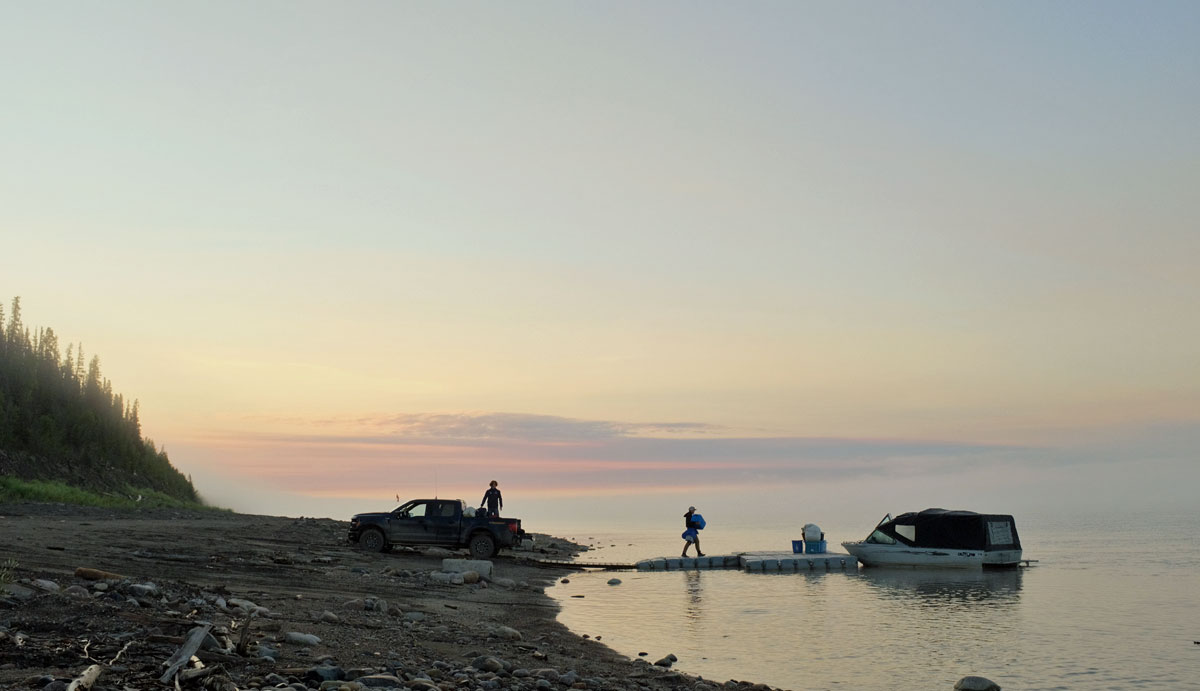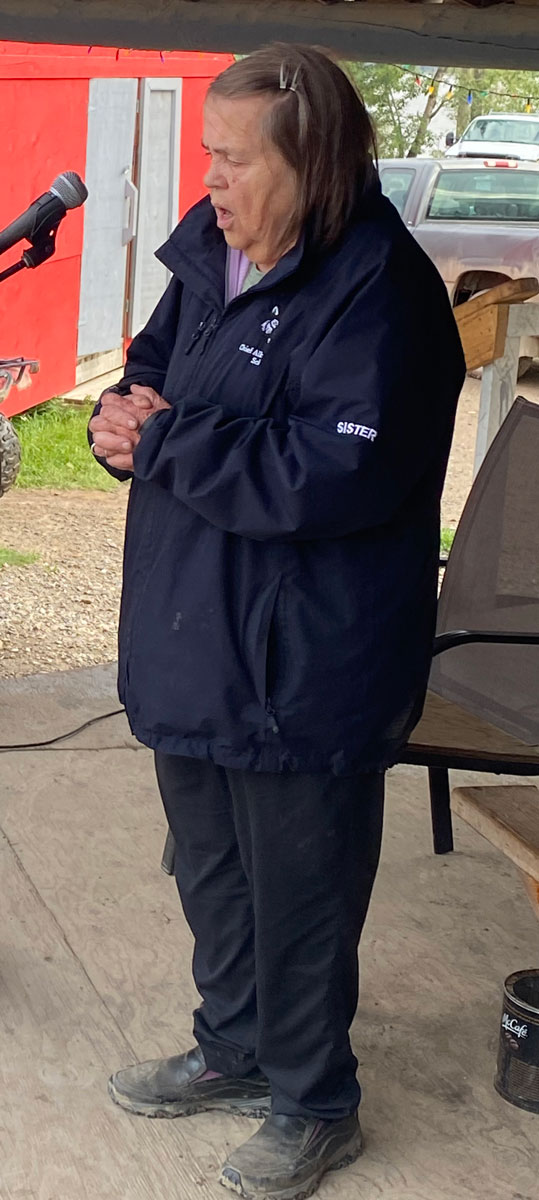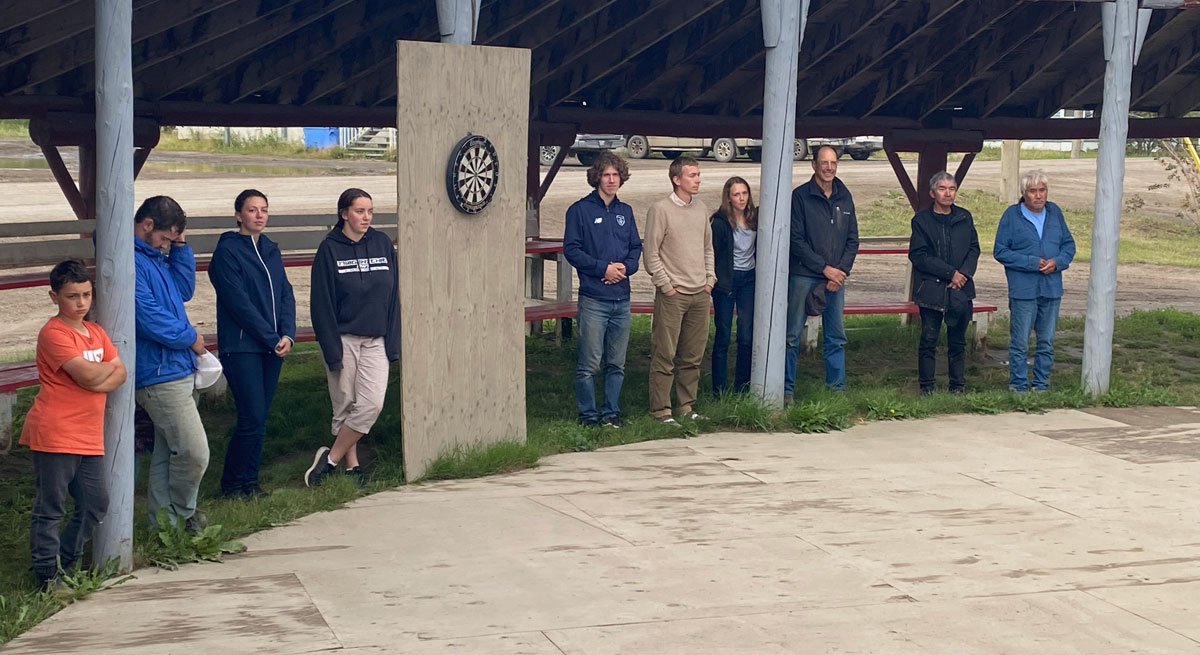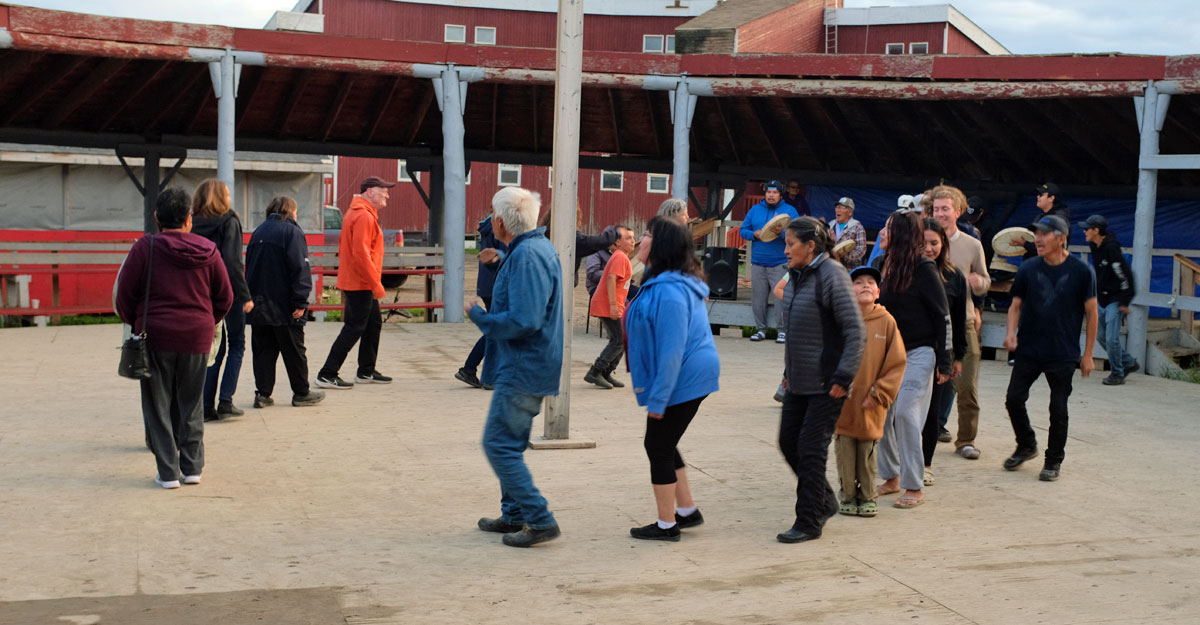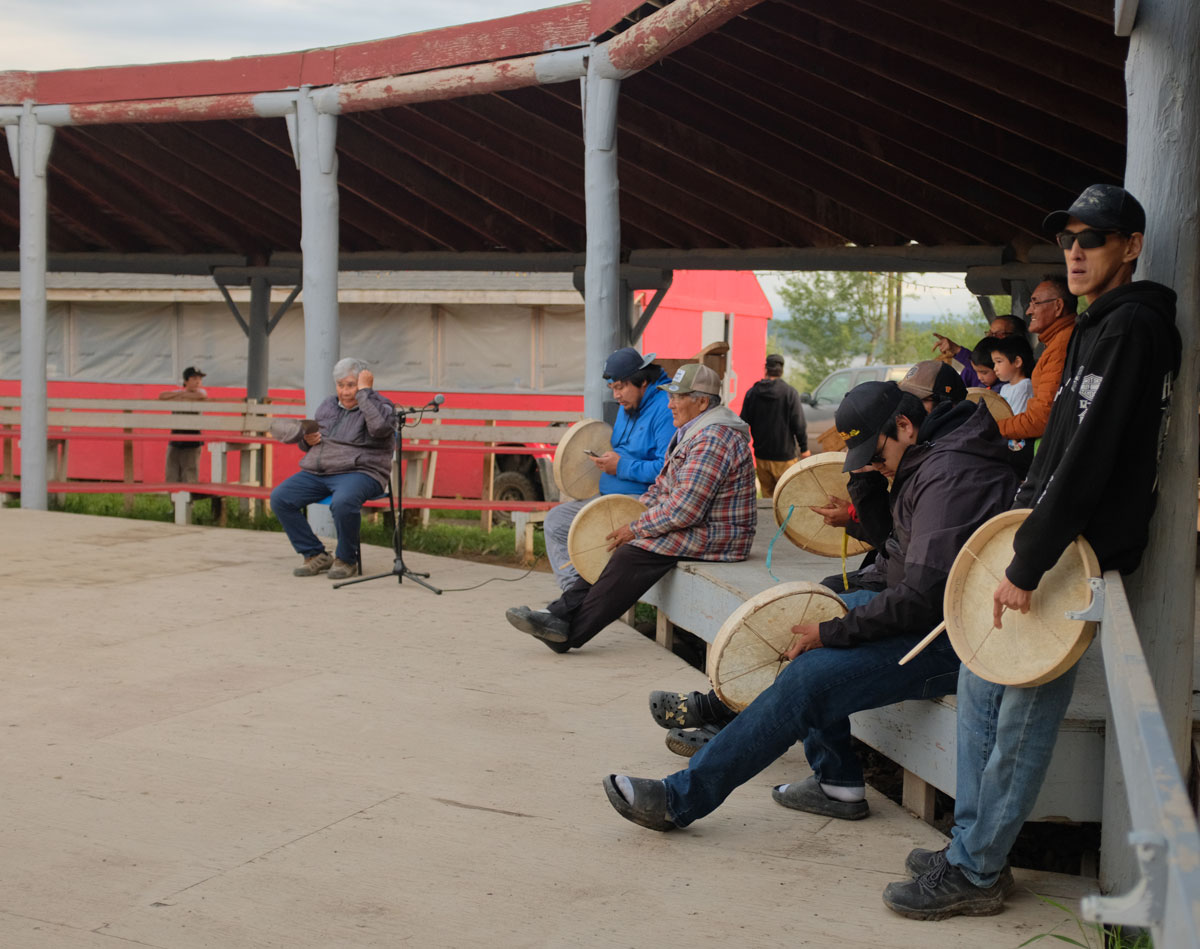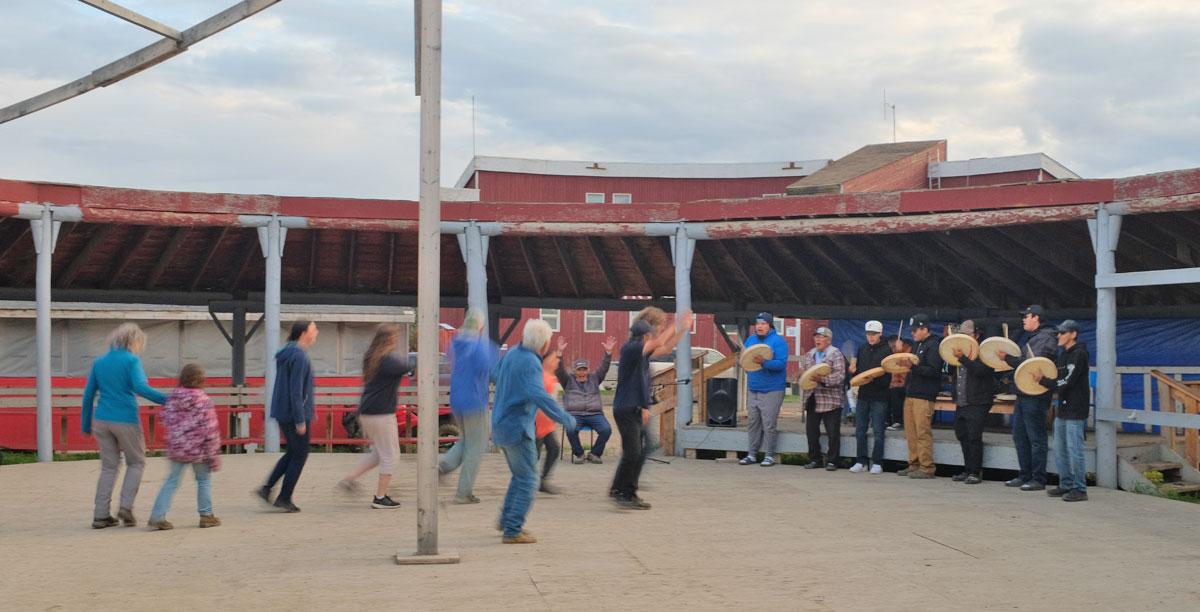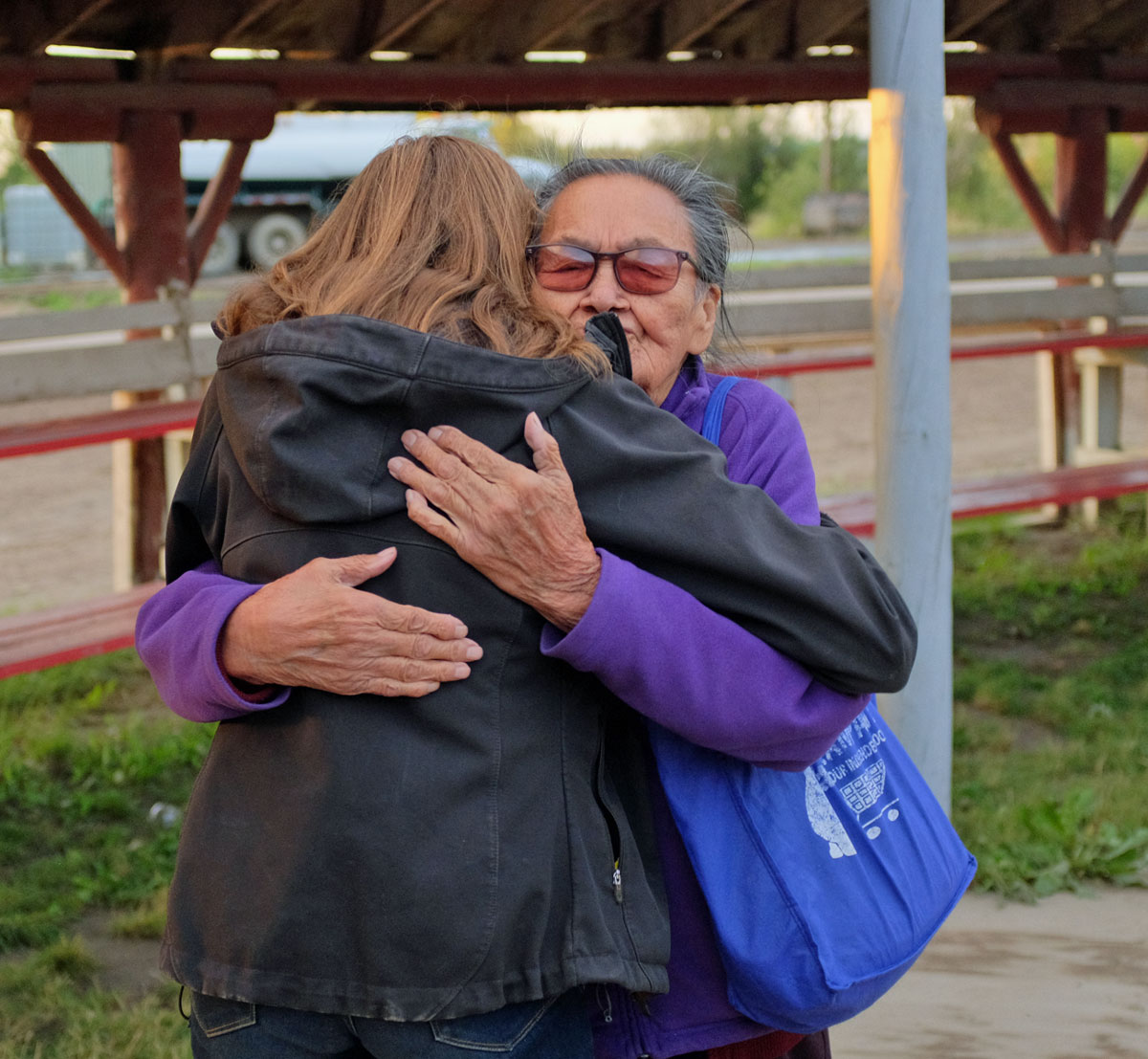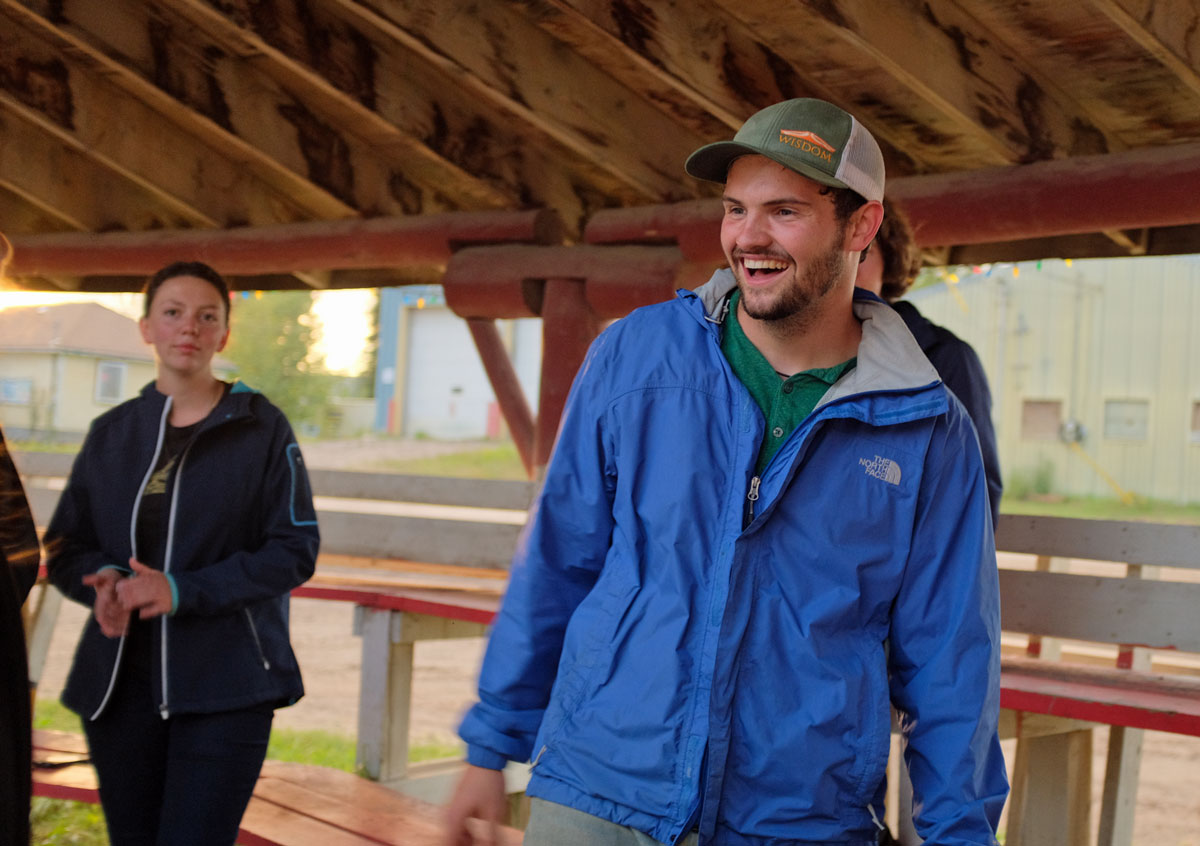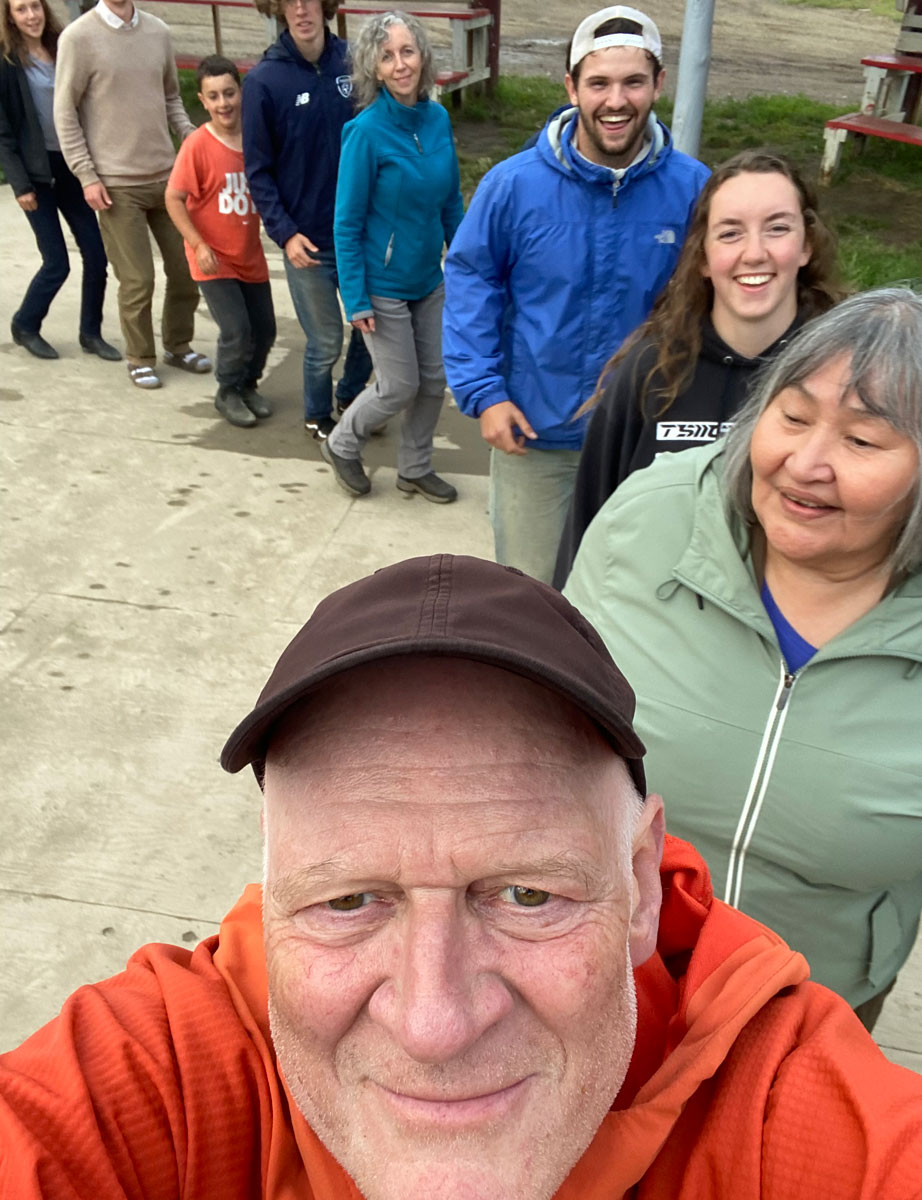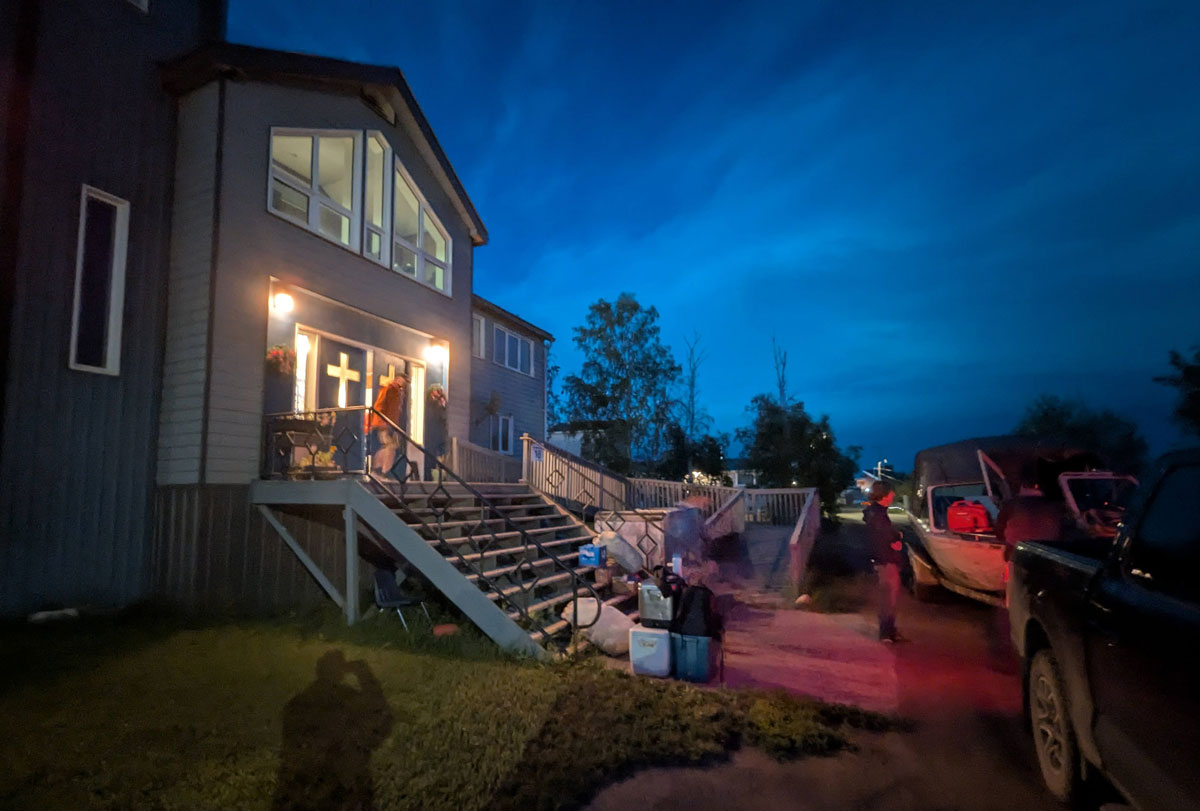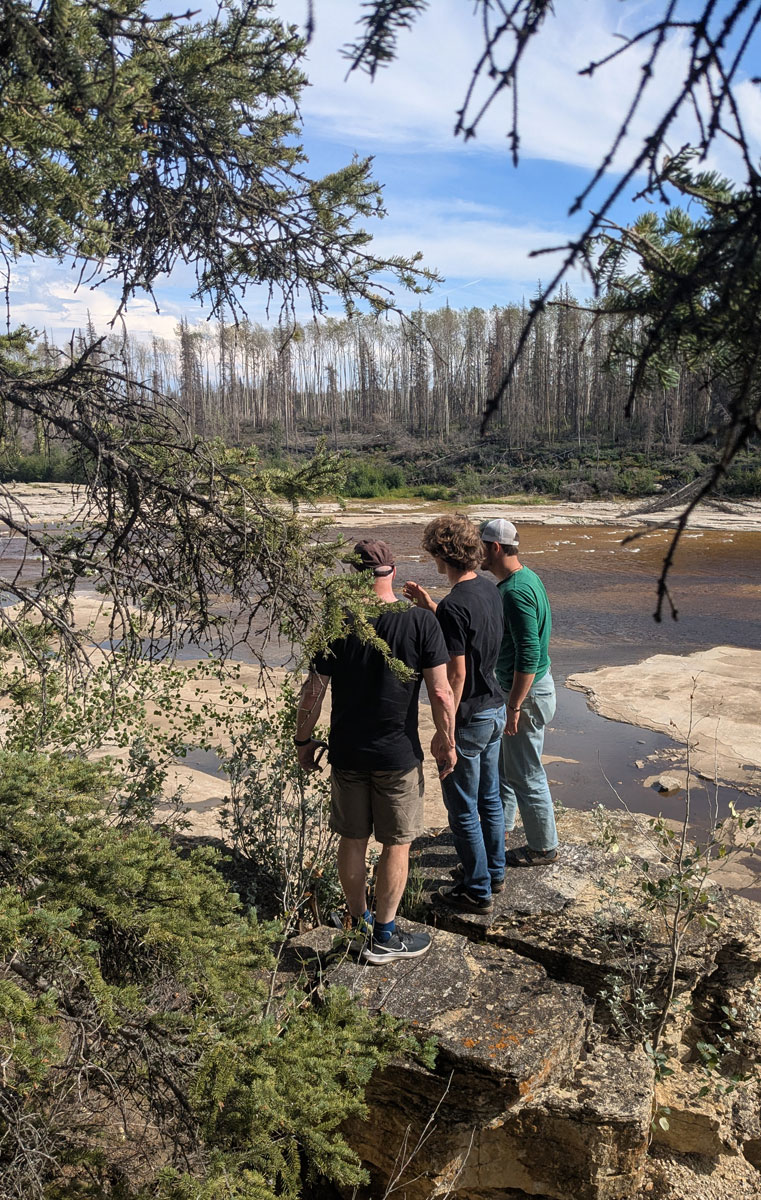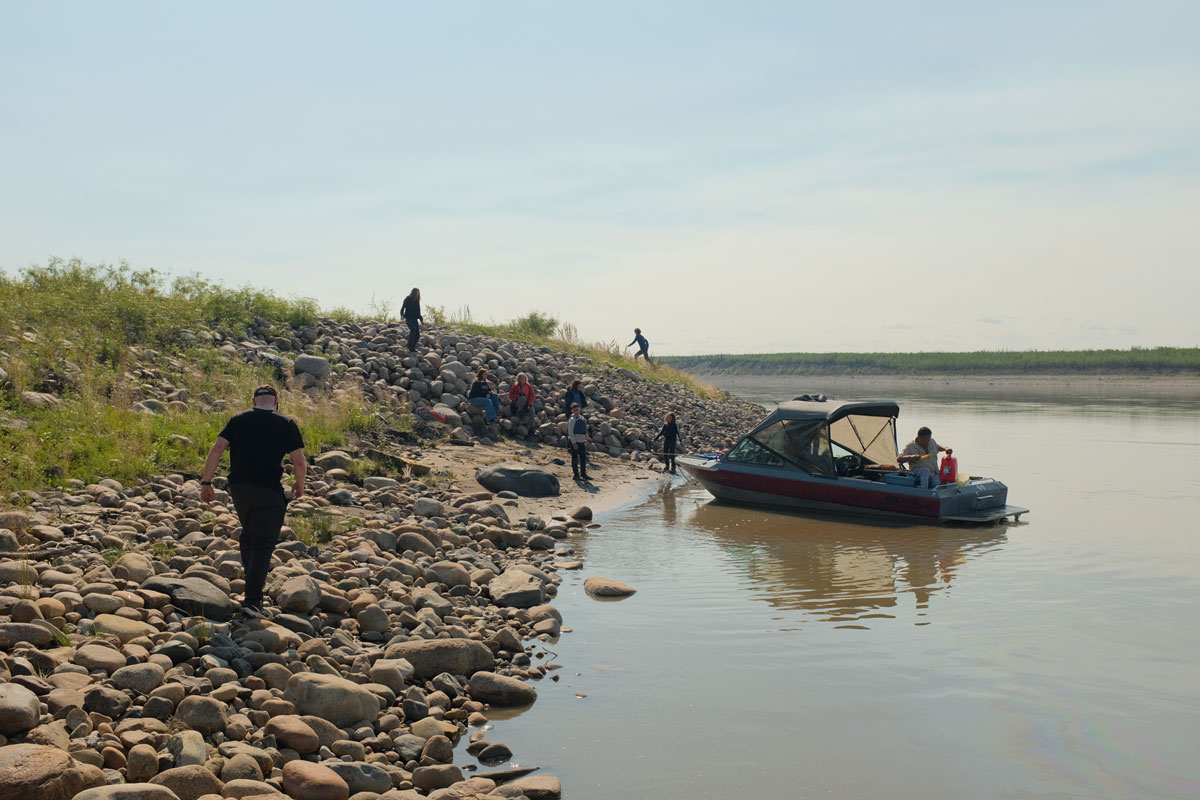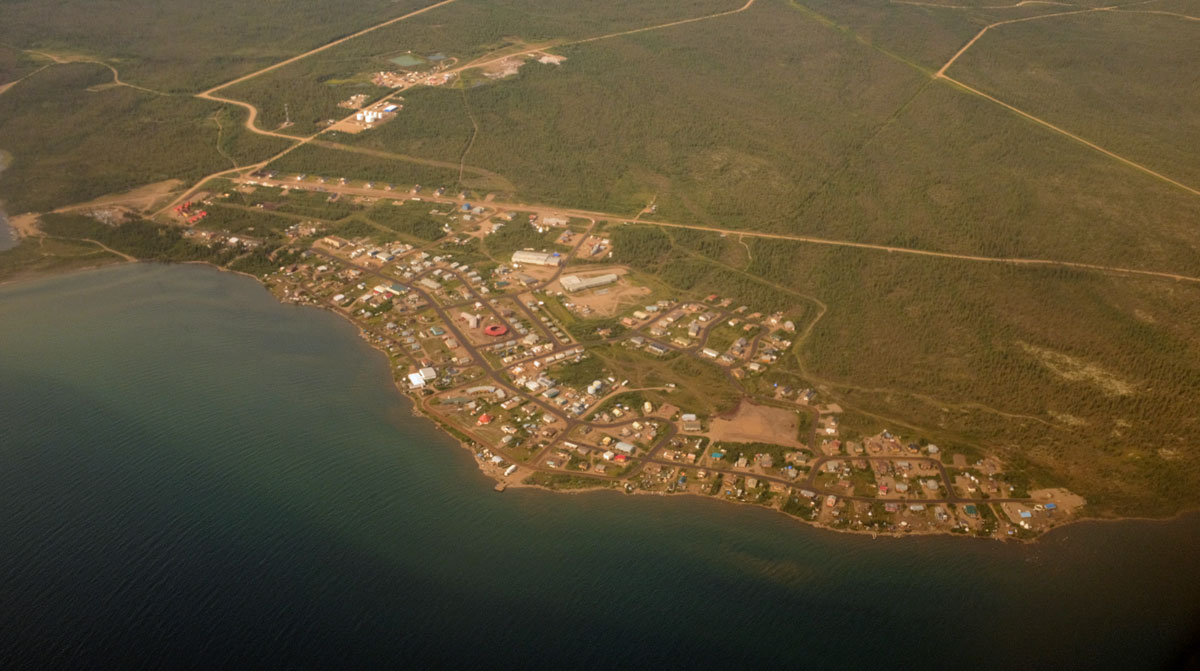(Updated Sept. 8, 2025)
By Kiply Lukan Yaworski, Catholic Saskatoon News
Encounter, dialogue and relationship were the touchstones on a northern pilgrimage and outreach trip this summer for a small team accompanied by Bishop Mark Hagemoen of the Roman Catholic Diocese of Saskatoon.
Summarized as a way of “seeking growth and healing, sharing culture and spiritual guidance for recovery, resilience, healing, and leadership,” the project was coordinated by Hagemoen, who built upon connections he has made wherever he has served over the years – as a priest in the diocese of Vancouver, as bishop of the northern Diocese of Mackenzie-Fort Smith in the Northwest Territories from 2012 to 2017, and now as bishop of Saskatoon.
Envisioned as a concrete way to respond to several of the Truth and Reconciliation Commission (TRC) Calls to Action, the project began a process which included mutual sharing and exchange between Indigenous and non-Indigenous groups of young adults, education about and promotion of Indigenous spirituality and culture, and personal and communal healing and growth, Hagemoen said.
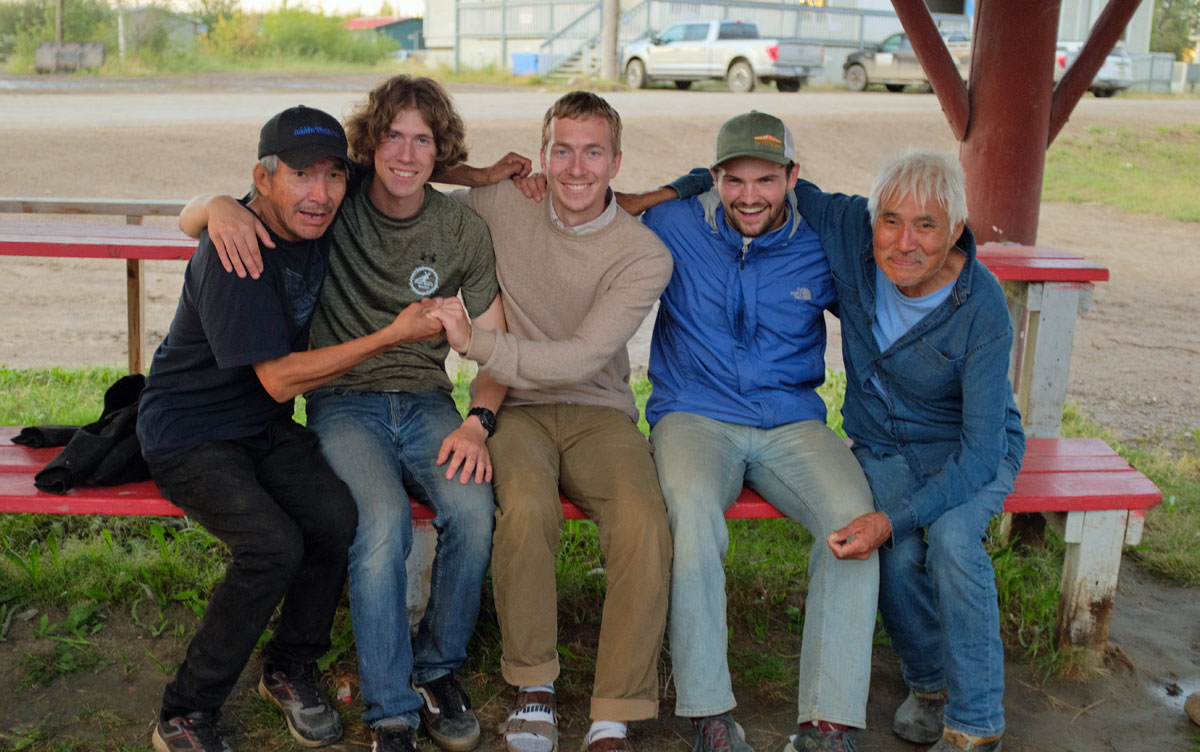
Ronan Gillespie, Kieran Gillespie, and Maximillian Connelly with members of the Tulita community. (Submitted photo)
“The project with Tulita and Deline Sáhtu Dene First Nations was designed to provide opportunities for shared cultural and spiritual exchange involving young adults — Indigenous and non-Indigenous, men and women, roughly 18 to 30 years,” said Hagemoen. It also included young team members providing practical assistance to communities in the form of tasks and work projects.
“The aim was to have young adults engage with each other, addressing current personal and community challenges to personal recovery, healing, and growth. Participants experienced Indigenous cultural teachings and ways of spiritual sharing that relate to personal growth, struggle, and the healing journey,” he described.
“This trip featured much growth, challenge, and learning as the team travelled, worked and served together. The mundane tasks of chores and service were also essential to serving the community, as well as preparing our own minds and hearts,” the bishop said.
“The foundation of learning and sharing is the slow steady commitment to be with one another, which features presence; community time with play, celebration, and prayer; relationship-building.”
This project was in part inspired by Hagemoen’s time in the north, experiencing healing circle sharing among the Sáhtu Dene peoples, “with the aim of sharing and addressing many current personal and community issues/ challenges, affected in part by the intrusion of larger non-Indigenous cultural influences, especially through the recent influence and ‘reach’ of technology,” he said.
The 2025 summer mission trip was also inspired by the positive experience of visiting young adult groups visiting the Northwest Territories and the Diocese of Mackenzie-Fort Smith from about 2014 through 2017. “Such groups visited for learning and cultural exchanges, and to experience the grandeur and healing that comes from being ‘on the land’ of the Dene traditional territories,” he said. “Visiting young people also benefitted from doing simple manual work and service, and by providing summer day camps for children and youth.”
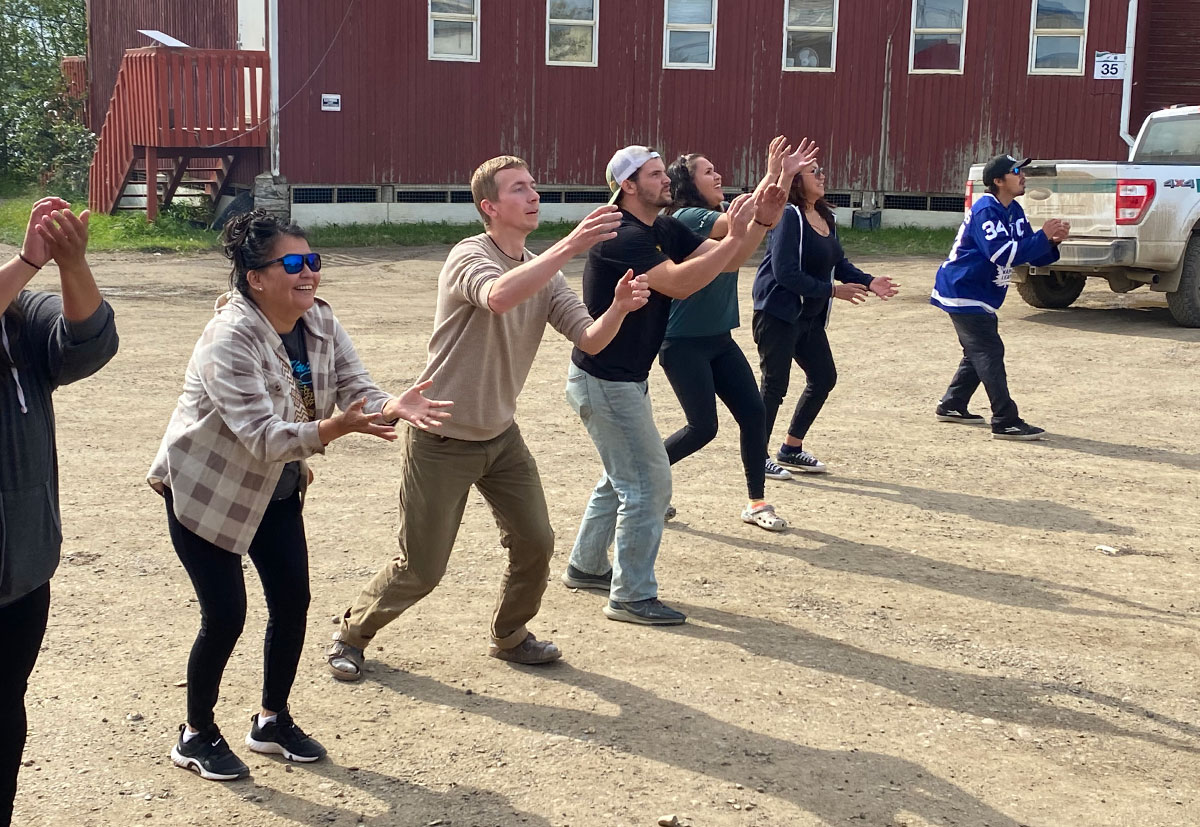
Team members participated in an egg toss during the Community Days events in Tulita, NT. (Submitted photo)
A joint Indigenous Reconciliation Fund project of the Roman Catholic Diocese of Saskatoon and the Diocese of Hamilton, the missionary trip to the Diocese of Mackenzie-Fort Smith happened with the invitation and blessing of Bishop Jon Hansen, CSsR, noted Hagemoen.
The Pilgrim Journey
The summer project began with a long trip by pick-up truck from Saskatoon to the NWT, via Grande Cache, AB, where Bishop Mark Hagemoen and three of the project participants first tackled an Aug. 2-3 mountain relay race in Grande Cache, AB, that the bishop ran in support of the Indigenous Reconciliation Fund.
After that race, three relay race team members Maximilian Connelly and brothers Kieran Gillespie and Ronan Gillespie – who are all alumni of the St. Therese Institute of Faith and Mission young adult Catholic formation program offered at Bruno, SK – travelled north with Hagemoen from Grande Cache, with stops in Grande Prairie, AB, Hay River, NT, and Fort Simpson, NT, before the final leg via Wrigley to Tulita, NT – with an additional visit from there to Deline on Great Bear Lake, NT.
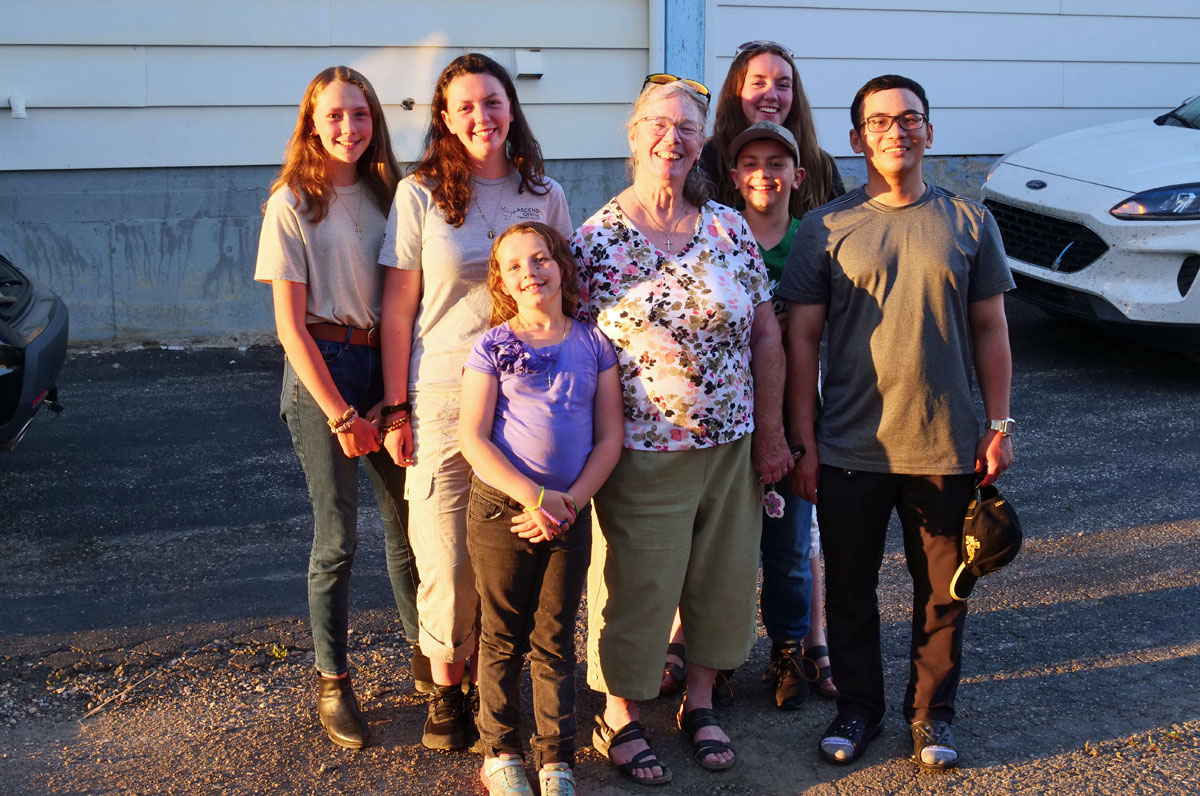
Steiner family members with Sr. Maggie Beaudette and Fr. Peter Dai Nguyen at Hay River. (Submitted photo)
Each stop along the way proved to be an occasion of experiencing and learning more about the local Dene culture and history, noted Hagemoen. “We experienced some of the ways in which inculturation happens between Indigenous Peoples and the Catholic faith,” he said.
“We were very privileged to receive hospitality and accommodation by Archbishop Gerry Pettipas, CSsR in Grande Prairie AB; by Fr. Innocent Ukaegbu, Fr. Peter Dai Nguyen, and Sr. Margaret Beaudette, CSJ, in Hay River NT; Fr. Peter Anochirim and Martina Norwegian in Fort Simpson NT; Charlotte Canadian in Wrigley NT, and by Fr. Nel Esguerra in Peace River, AB.
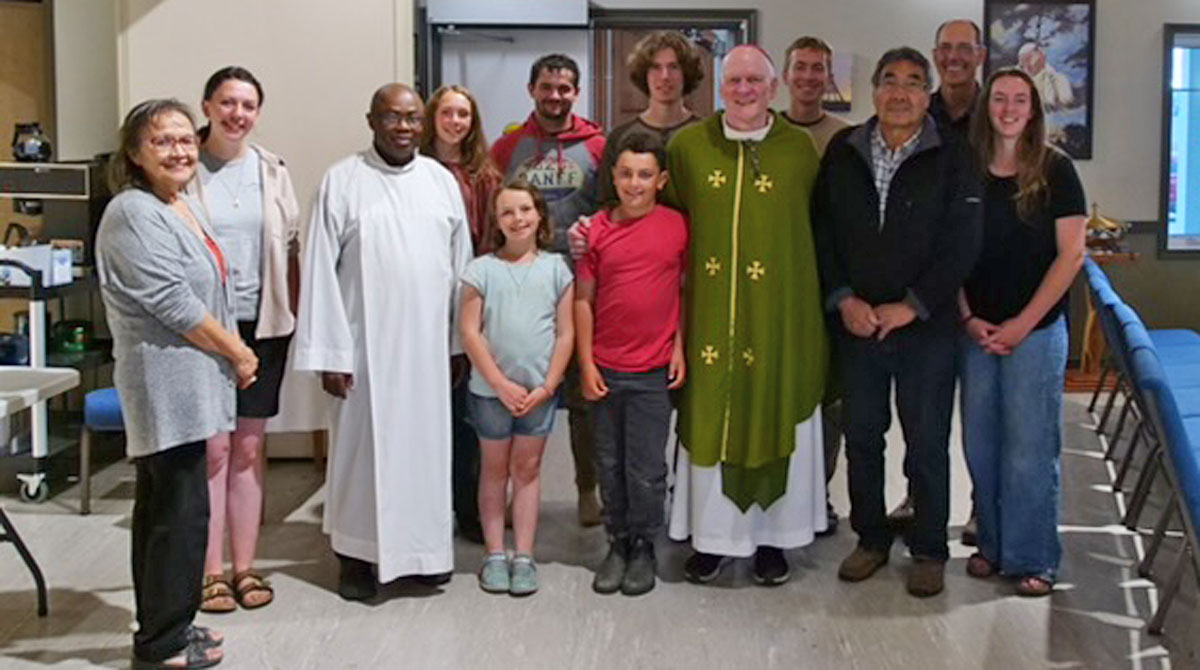
En route to the Sahtu Dene Nations at Tulita and Deline, NT, Bishop Hagemoen and the team celebrated Mass at Fort Simpson with members of the community and their pastor Fr. Peter Anochirim. (Submitted photo)
Ray and Therese Steiner and family of Fraser Lake, BC, also joined the team to provide service and outreach at Tulita, NT. The Steiner family have spent several years working in the Northwest Territories — particularly in Tsiigehtchic, NT, where they lived for two years doing pastoral ministry which featured work with children, families, and elders. Their oldest daughter, Kathleen Steiner, spent several years as a missionary internationally with other young adults, Hagemoen noted.
“We had been invited by Bishop Mark Hagemoen to return to Tulita, where we had been in 2017 for family ministry and a large renovation project on the church and rectory,” wrote Ray and Therese Steiner in a reflection about the experience. “It was time to check on the building and perhaps more importantly, to be with the Dene people again and to support Bishop Mark as he brought a group of young adults to experience the amazing welcome, generosity and kindness of the Dene people. Our family was so excited to be going back.”
The Steiner family’s journey to Tulita involved travelling three days by truck, meeting people along the way, and then travelling “the final leg of the journey – an awe-inspring six-hour boat ride down the Mackenzie River under the Midnight Sun.”
The Steiners observed that “It never takes long in the far North to see God’s steadfast love towards us, both in the magnificence and abundance of His creation and in the goodness of the people.”
Tasks, Encounters, Sharing, and Learning
“Upon arriving into Tulita, the immediate task was to meet local Chief Frank Andrew and begin to attend to some practical work at the pastoral center, where our host, Sr. Celeste Goulet, CSSF, lived and worked,” said Hagemoen.
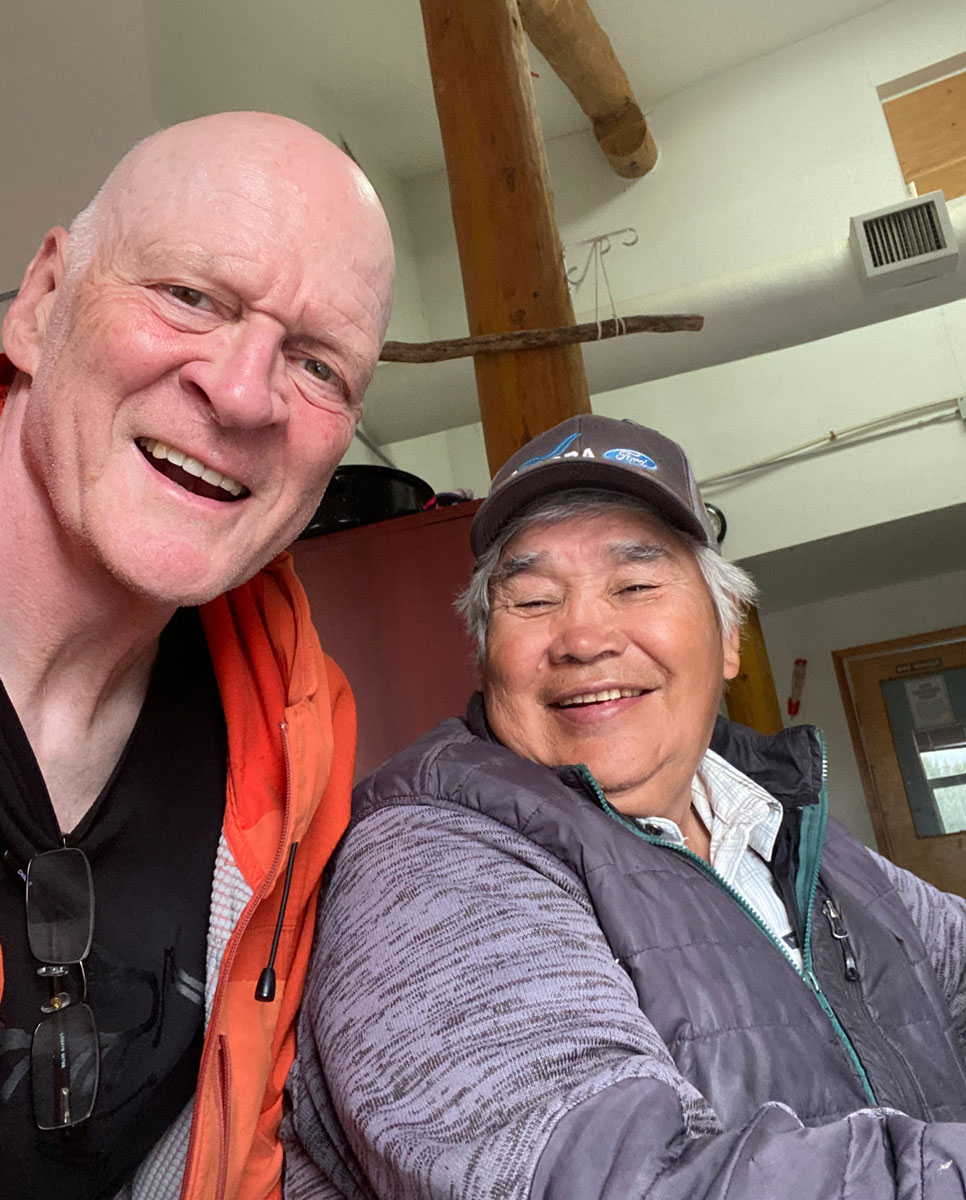
Bishop Mark Hagemoen met with Chief Frank Andrew at the Tulita Dene Nation office. (Submitted photo)
“Such visits always feature regular – even mundane – chores and tasks,” the bishop said, noting that Sr. Goulet, (a Felician sister who has spent 46 years in the community), needed the team to address a number of maintenance issues regarding the building and grounds.
“There was also the immediate task of preparing food for our rather large community, as well as preparing bannock for visitors to the pastoral Centre,” he said.
“Sr. Celeste, who has served Tulita with faithfulness and humility for close to 50 years, leads the rosary each morning on the local radio station,” noted Ray and Therese Steiner in their reflection about the 2025 visit.
“During our days in Tulita, we gathered around the radio at the kitchen table to join her in prayer. We were surprised to hear not only Sister’s voice, but also people calling in from all across the town to lead various decades. This simple pause for daily prayer together was an inspiration for us of unity and sharing faithfulness.”
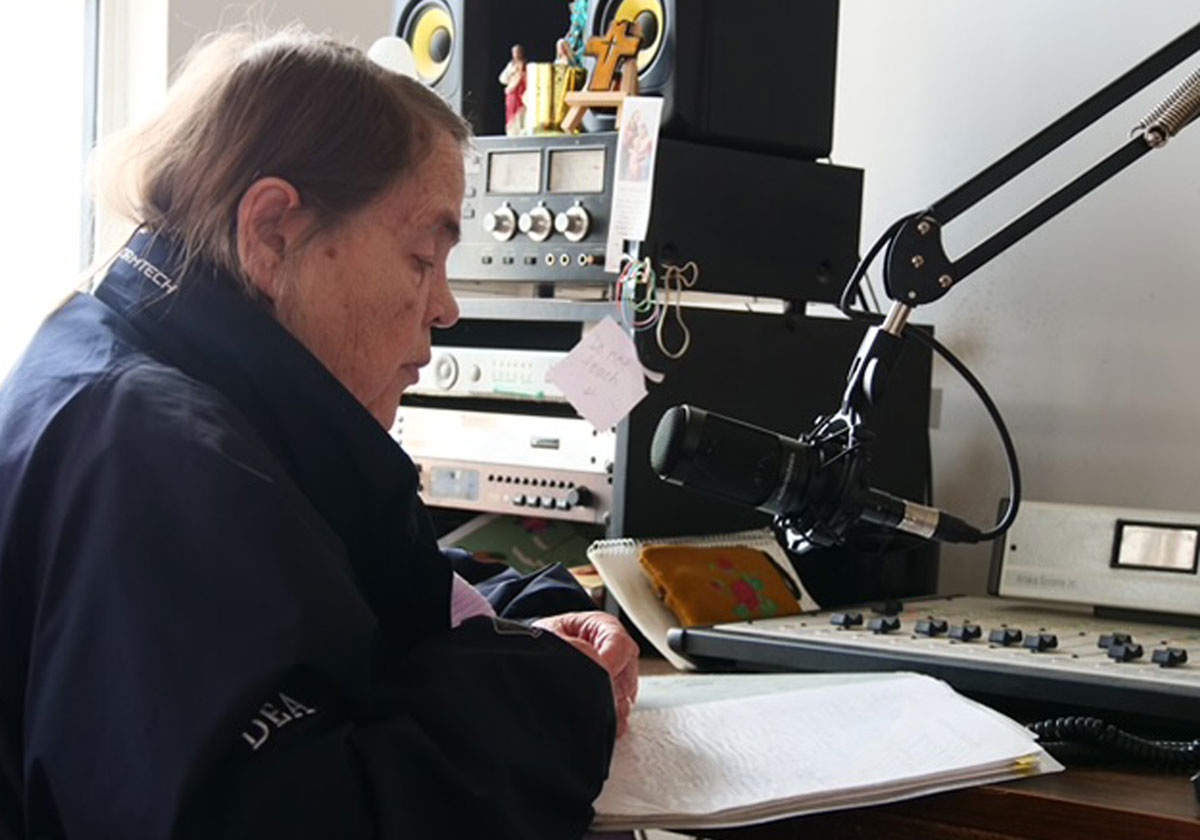
Sr. Celeste Goulet hosts a regular community radio program in Tulita that includes praying of the rosary. (Submitted photo)
The bishop added: “Max Connelly and Kathleen Steiner introduced our team to the community during the radio broadcast regularly hosted by Sr. Goulet and outlined our hopes for our visit – including our desire to meet and learn from the community. They also announced a sharing circle event, and invited any young people, or others, to attend.”
The visiting group hosted sharing circles over two different evenings during their time in Tulita.
“Together with the local people, we shared stories and challenges of our individual life journeys, and prayed and sang together,” said the Steiners. “As we shared experiences of God’s faithfulness, especially through trials and difficulties, we were uplifted and drawn closer to God and one another. We listened to one another, and as one people prayed together and for one another.”
Team member Maximilian Connelly said: “I believe we did some good through God’s grace by providing opportunities for places of sharing and prayer on a couple of occasions. The stories I heard spoke of deep sorrows. From tragic deaths to ongoing addictions the pain was evident…. Yet, the most profound and present theme was that of gratitude, of acceptance of hurt and surrendering these hurts to God.”
“Though there was hurt, there was also hope,” said Ronan Gillespie. “The older generation, including elders and parents, were clear in expressing their hope for the struggling youth.”
Connelly said he was greatly impacted by the culture and spirit of the Dene people in Tulita “Our short stay allowed a glimpse at the generosity and warmth of the people, as they welcomed us and shared with us about life in a northern community.”
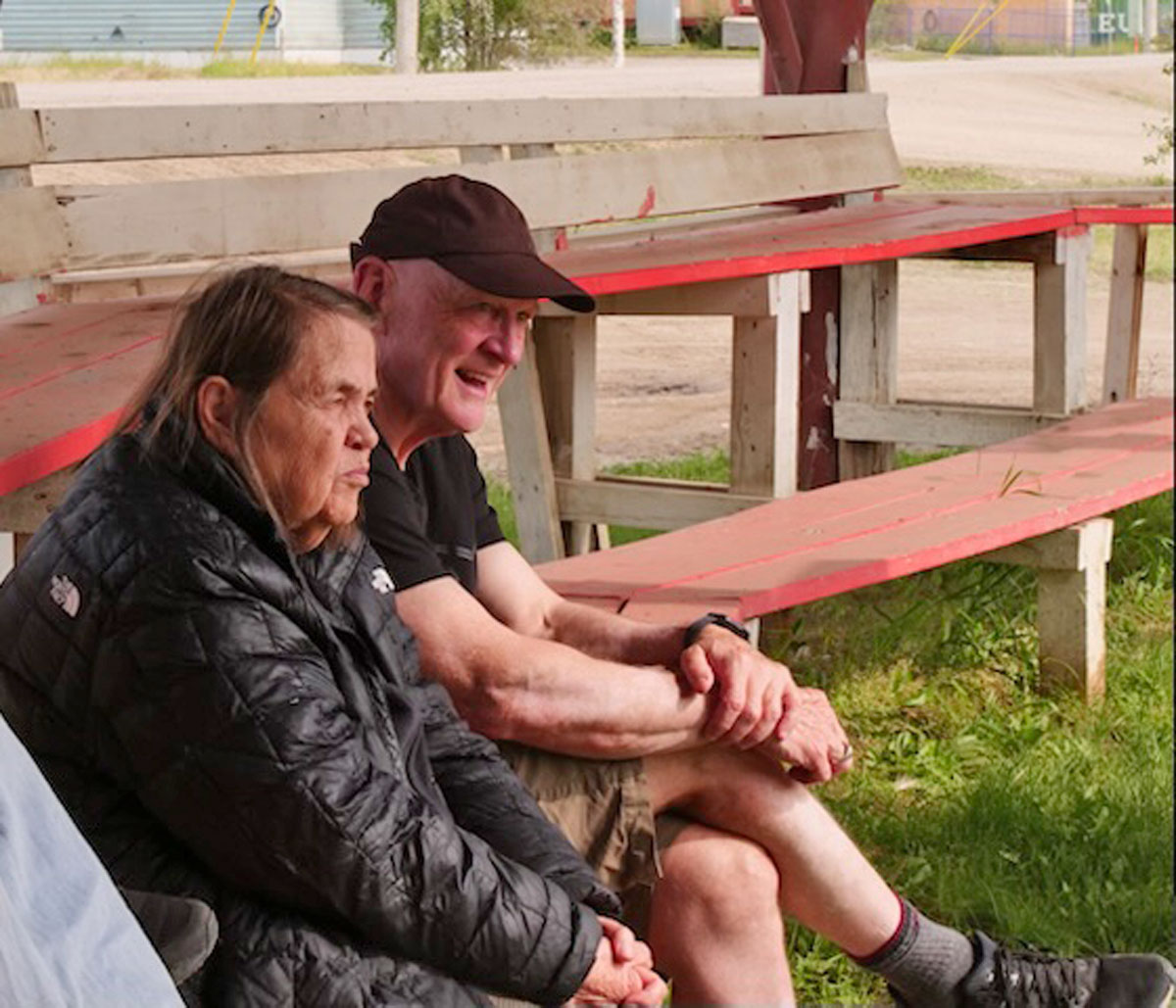
Sr. Celeste Goulet, a Felician sister who has served in the north for some 46 years, sits with Bishop Mark Hagemoen at a community event in Tulita, NT. (Submitted photo)
Community fun, joy and celebration were part of relationship-building and encounter during the visit. For instance, a community soft-ball game proved to be a great occasion to break the ice, and a chance to get to know many of the community members, said Hagemoen.
Daily Mass and proximity to the church-chapel at the pastoral centre was a real support for the team, he added.
“Many of the community members – especially many elders – frequented the chapel, which had a daily service at 5:30 p.m. Following each service, community members gathered to meet and catch up on the goings on. They also would sometimes share about more serious or meaningful issues that were on their hearts, or that impacted their community.”
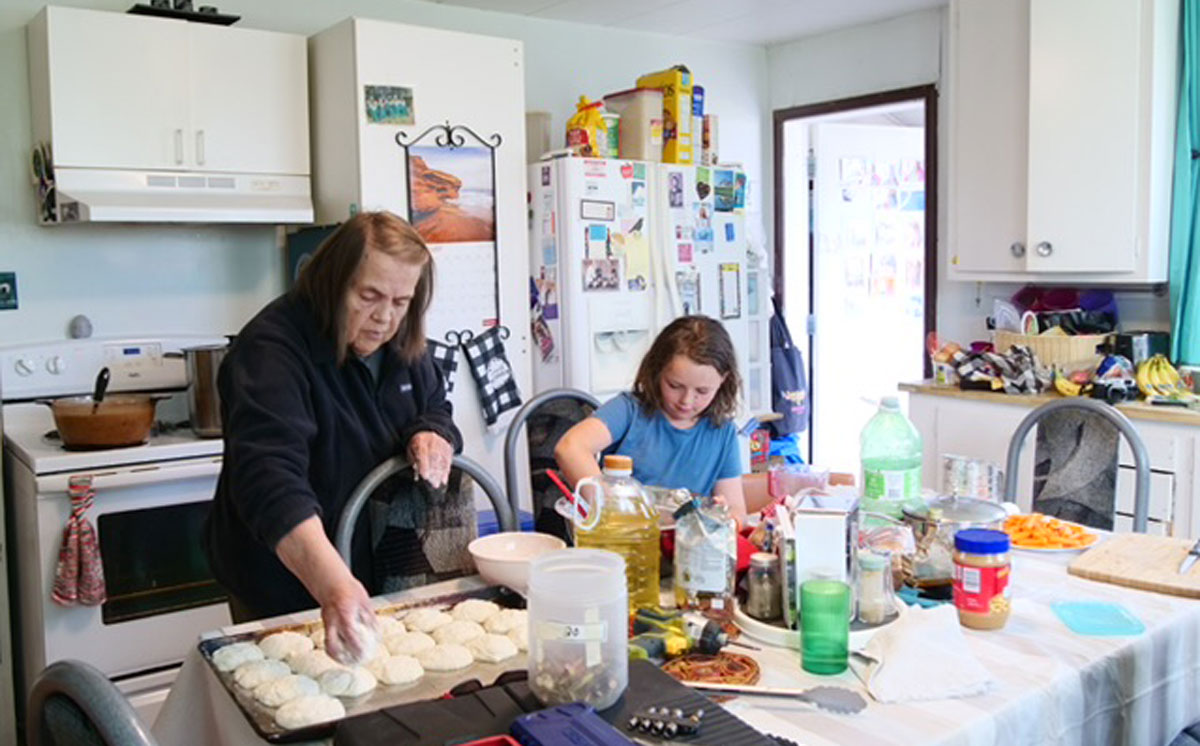
Sr. Celeste Goulet and team member Eliza Steiner preparing food for visitors to the Tulita pastoral centre and church. (Submitted photo)
The weekend after the team’s arrival featured “Community Days” at which the local Dene band, along with Parks Canada, celebrated a range of community events, including games and other activities. “This was also a great way to get to know members of the community, and experience some of the local culture —and for the community to get to know and relate to us as visitors,” said the bishop.
Trip to Deline: Preparations for a Spiritual Gathering
A few members of the team were also invited to visit Deline on Great Bear Lake by Danny Bayha – a member of the Deline Dene community, and a friend of Bishop Hagemoen.
“This meant taking a three-hour boat ride from Tulita up the Great Bear River. Our boat driver and host was Leroy Andre, a long-time member of the Deline community and former chief. His sharing and teachings were very informative and enjoyable.”
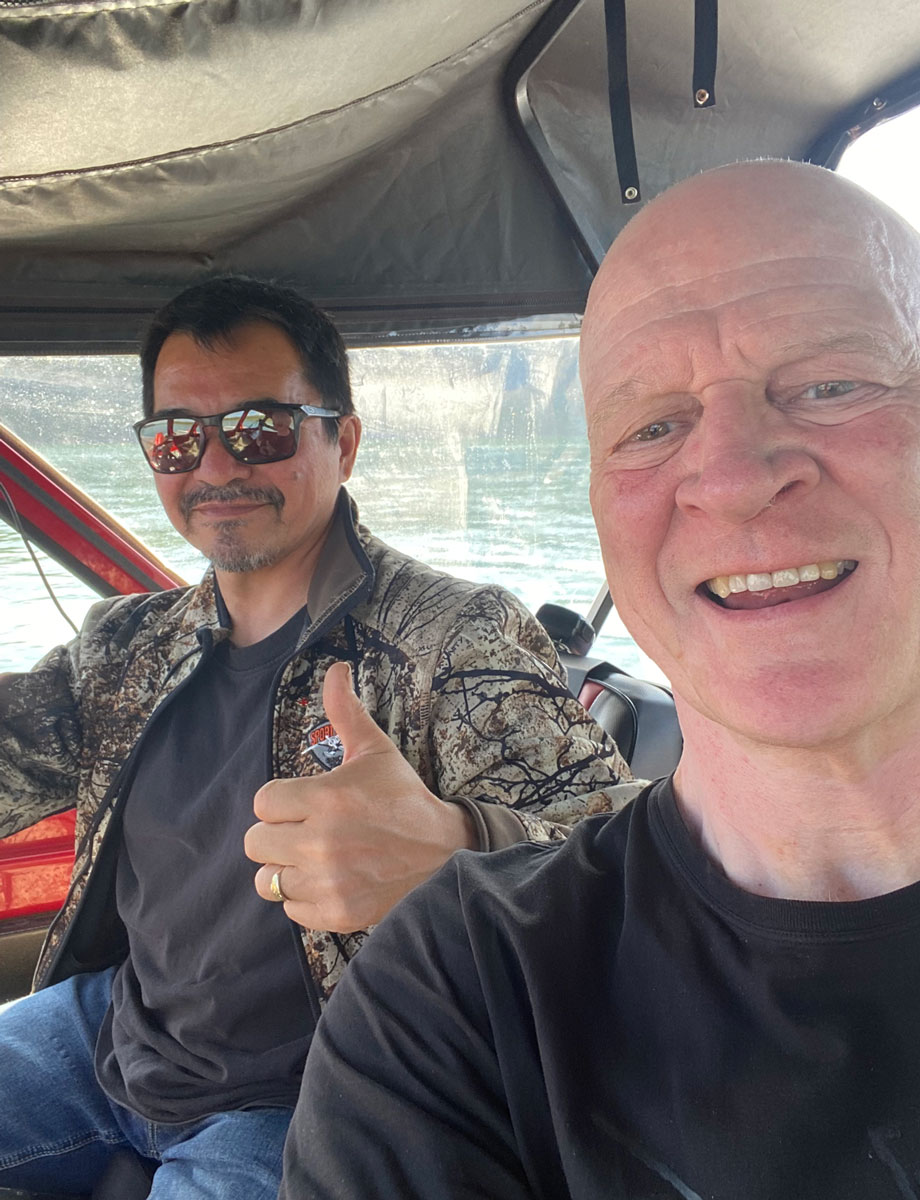
Leroy Andre piloted the boat that carried some members of the team up the Great Bear River Delta during a visit to Deline Dene Nation. (Submitted photo)
The Deline community was preparing for their annual Spiritual Gathering, which features the celebration and recalling the teachings of their four Dene prophets, on the site of the house of prophet Ehtseo Louis Ayha (1857-1940), at the east end of the Deline community. The visit was also an opportunity for the bishop to celebrate Mass, which the Deline community has only infrequently, and are quite devoted to – especially the elders.
“On the day of our arrival – and after an early evening Sunday Mass and barbeque – we were invited to a meeting of community members at the prophet’s house – to discuss preparing for the Spiritual Gathering, which was to be held in five days. Many of the hopes and aspirations, along with the concerns for the health and well-being of the community – were expressed by the community participants at the meeting,” said Hagemoen.
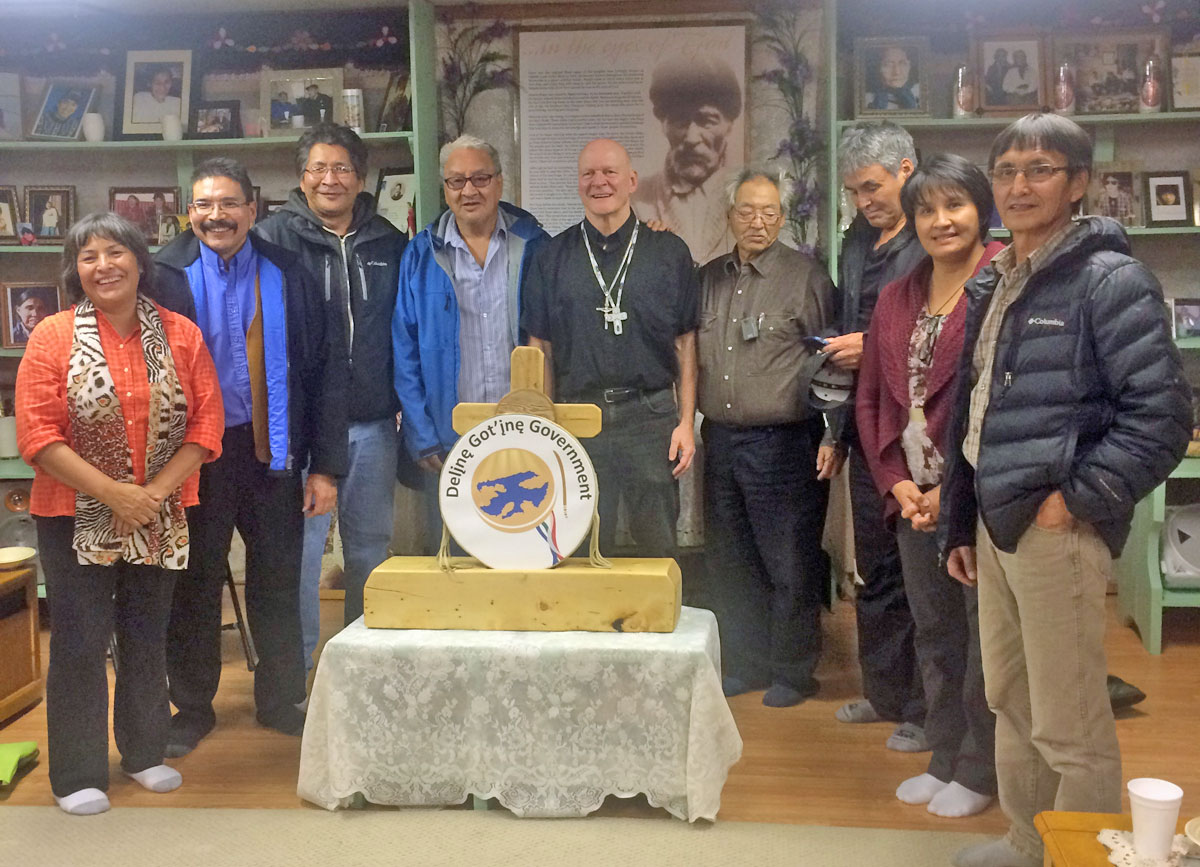
FILE PHOTO: Bishop Hagemoen meets with community members at the Deline Got’ine First Nation in the house of one of the four Deline prophets. The photo was taken in 2017, during Hagemoen’s time as bishop of the Mackenzie-Fort Smith diocese, when the community was in the midst of planning its annual Spiritual Gathering, and also celebrating the achievement of self government. (Submitted photo)
Team member Kieran Gillespie reflected on the preparations for the Spiritual Gathering: “Danny (Bayha) and others shared their vision and hope for a community transformed and united in the love of Christ. They are working to spread the gospel to the young people especially, and doing their best to teach and spread the messages from the four prophets who guided their people.”
The bishop added: “What featured prominently in the discussion was the great respect that everyone had for the life and teachings of the four prophets. There continues to be a strong hope that their life and teachings would be handed down to the younger generations — and that their strong spiritual teachings and simple yet rigorous way of living on and learning from the land – would be a central feature of the coming Spiritual Gathering, and would be a focus for future spiritual learnings and events.”
Ronan Gillespie also reflected on the encounter, saying: “In Deline I was blessed to be a part of the discussion centered on how to help the young people. One of the key points brought up in the sharing was the need to… spend time out on the land. I was blessed to witness a different culture, one of respect and care for one another.”
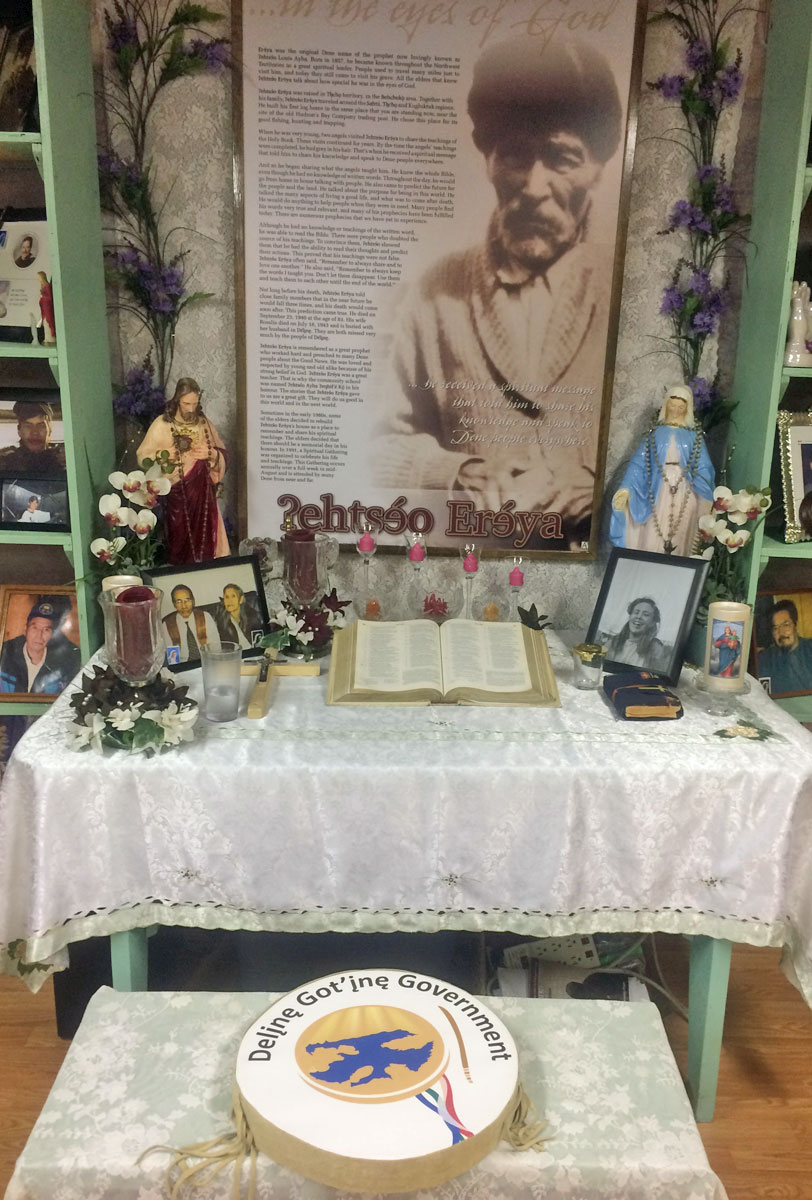
A display about Ehtseo Louis Ayha (1857-1940), one of the four Deline prophets whose teachings continue to be preserved and shared by the Dene community. (Submitted photo)
Team members were also invited to visit an “on the land” fishing camp 30 kilometres east of Deline on Great Bear Lake, which the community is developing as a youth, family, and elder program site, which involved another trip by boat. “This boat ride was much wilder than the previous boat rides up the Mackenzie (Decho) and Great Bear Rivers. Great Bear Lake is the size of a small ocean, and experiences great distances and strong wind currents,” said Hagemoen.
“Upon our arrival, we were immediately confronted with a series of tents set up on wind-swept shores on the north end of the lake. A recent large catch of fish were being prepared by the Dene women,” the bishop said.
“The elders were teaching the younger women and youth the traditional ways of filleting trout. One of the elders – who was 92 years old – handled a large filleting knife with great familiarity and skill. It was a marvel to watch her effortlessly, but with great reverence, prepare each trout by her hand. Each fish was then prepared in the traditional way for drying and smoking, so as to build the food stores for the upcoming winter season.”
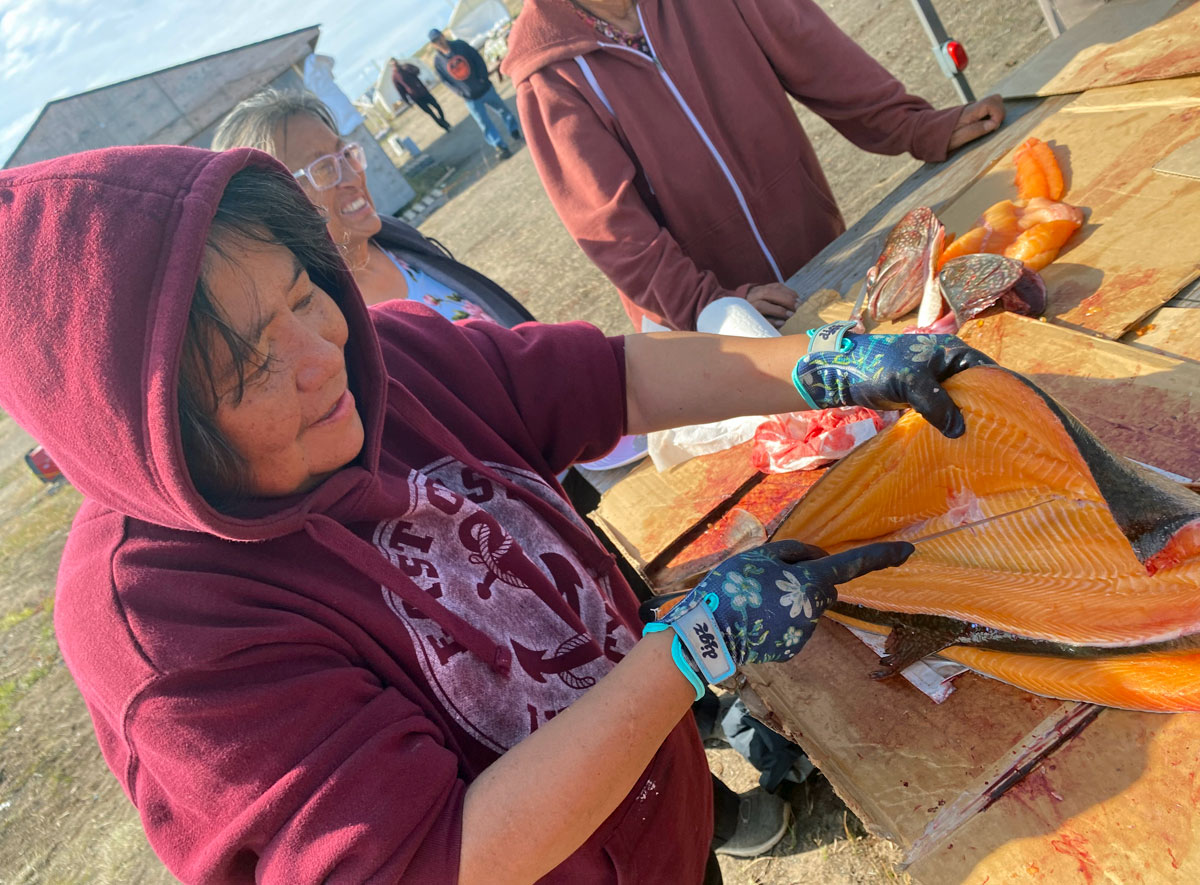
Traditional methods of filleting and preserving fish were part of the “on the land” camp visit. (Submitted photo)
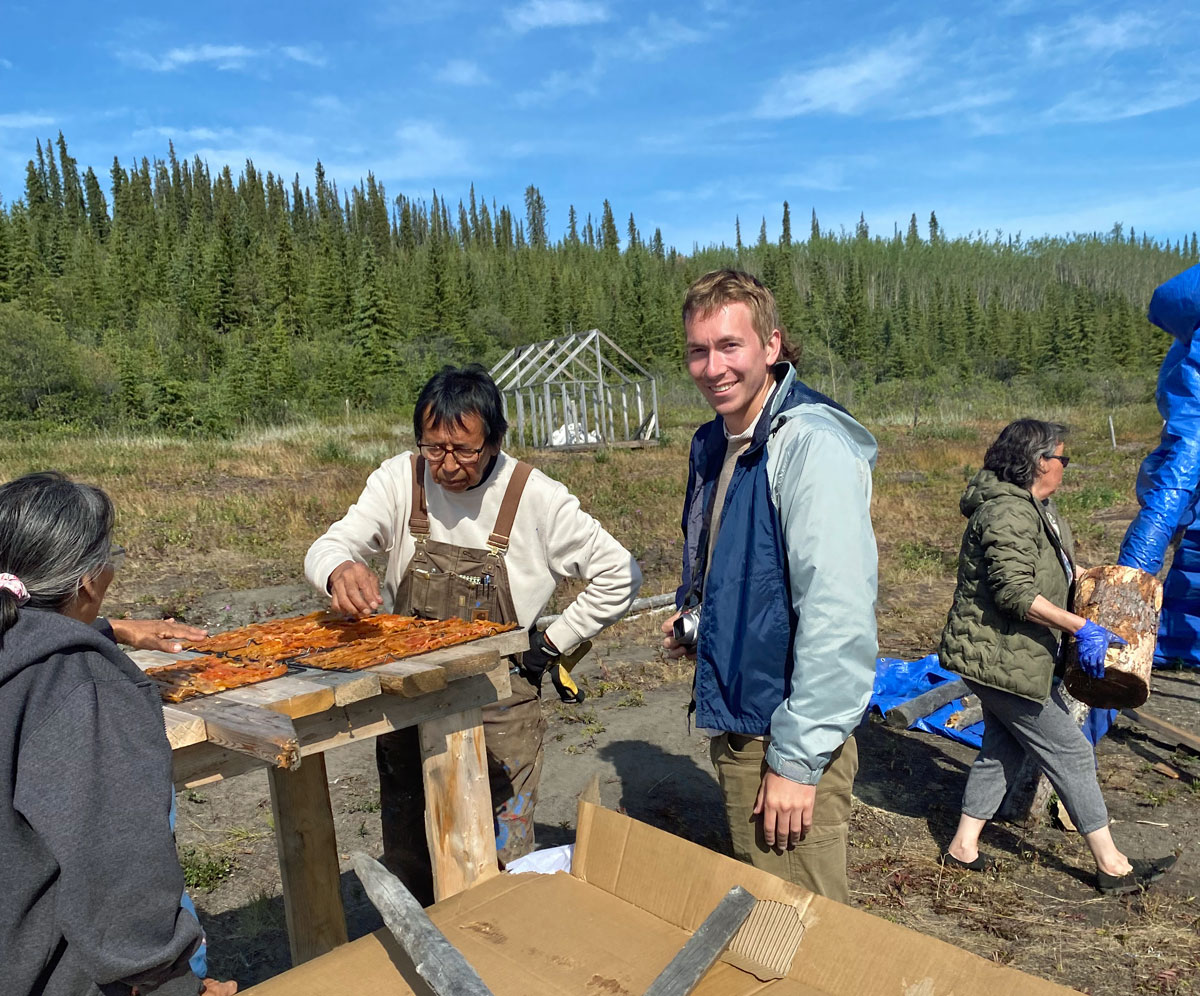
Team member Kieran Gillespie learns about the preservation of fish at the “on the land” camp. (Submitted photo)
Bishop Hagemoen said that he later had the privilege to share a few words with the community at the fish camp, “as this was the concluding day of the camp, and a time to give thanks for God’s blessings of such beauty and abundance, and of our lives.” The bishop was also asked to bless the camp and call forth the Creator’s grace and protection. “This was an honour,” he said.
Last Day in Tulita
“Upon our return to Tulita, we prepared for our last day, which included another healing circle gathering’ in the evening. Those who returned from Deline heard from those who remained and hosted the first gathering,” said Hagemoen. “There was a good turnout from the community. Many shared their stories of life, blessing and struggle. They also prayed for God’s healing in their lives and said that their prayers were answered.”
Participant Kieran Gillespie said that there were many moments throughout the trip “where we got to see God working.” He recalled how one woman prayed for at the spiritual sharing circle one evening reported how her pain eased enough to permit her to wash her floor for the first time in a long time. “She shared with us that she was filled with so much joy and gratitude, that she cried while washing her floor.”
On the final evening in Tulita, the team was invited to a ‘drum dance’ – which the Tulita chief, Frank Andrew, had arranged to express gratitude for the visit. “This was also a great opportunity to experience a very important Dene spiritual tradition expressing thanks and celebration with the community gathered,” said Hagemoen. “Again, Sr. Celeste and I had the privilege of giving a spiritual message and blessings, following Chief Andrew’s words of welcome and address.”
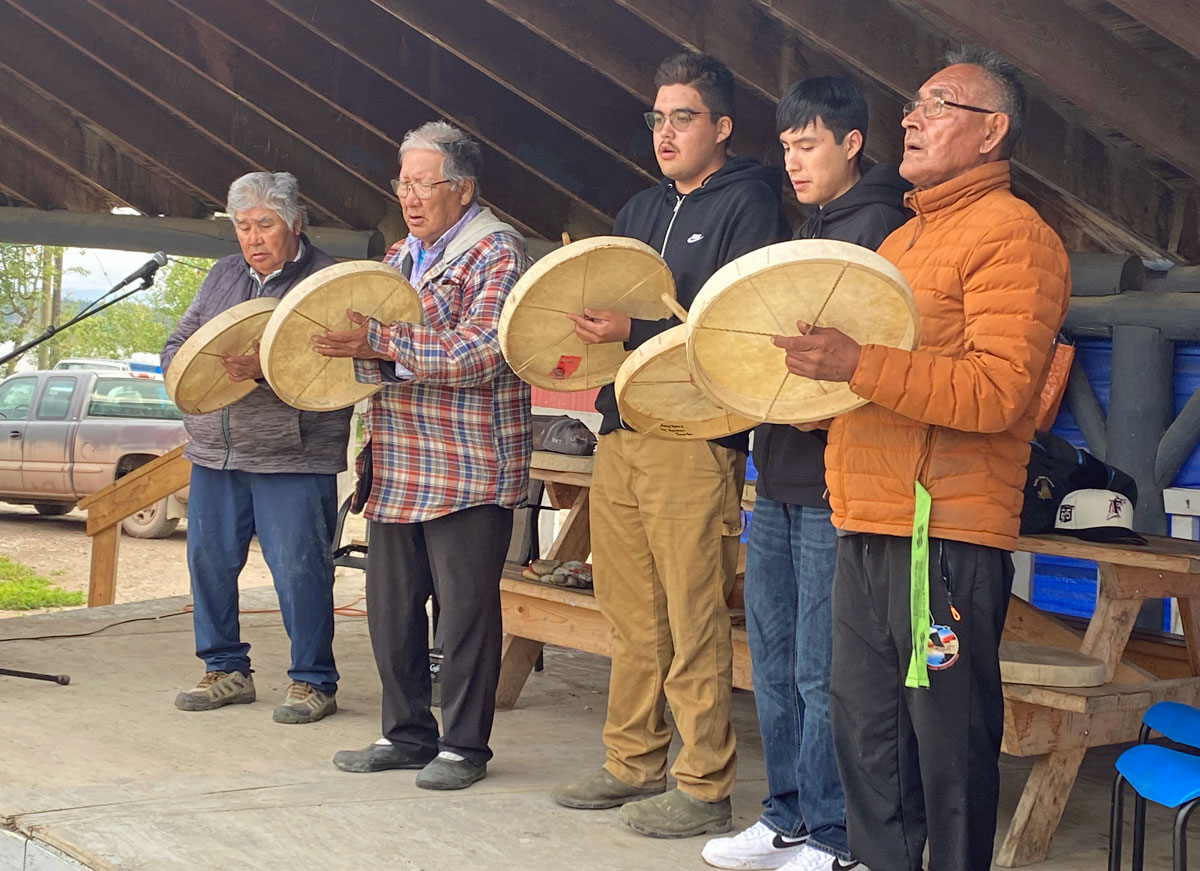
Chief Frank Andrew organized a drum and dance event on the final day of the team’s visit to Tulita. (Submitted photo)
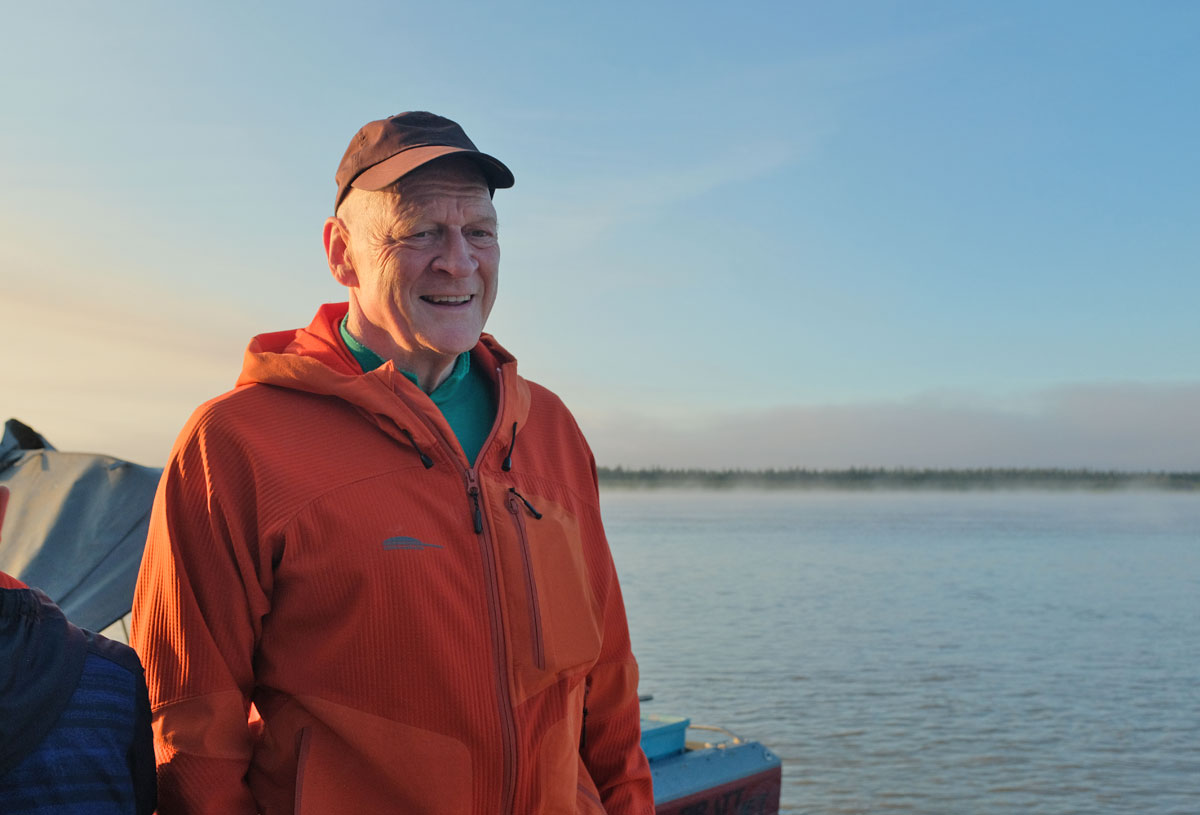
Travel by boat was an important means of transportation over the long distances of the north. (Submitted photo)
The long-distance challenges of northern travel continued on the way home. “The boat ride south was to begin very early the next morning – at 6:00 a.m. However, because of early fog, our departure was delayed. The ride south was actually longer – some seven hours – because we were travelling upstream,” described Hagemoen.
“We arrived into Wrigley mid-afternoon, and then had a three-hour drive to Fort Simpson, which meant catching a vehicle ferry over the Mackenzie River, before the ferry stopped running in the early evening. The team had one last evening together in Fort Simpson, before we split up the next day to travel to our home destinations.”
Reflecting on the Experience
“Spending time in a First Nations community in the North has truly been a blessing,” said Therese and Ray Steiner in a reflection about the project.
“We were received with great hospitality and generosity and always welcomed to join in whether from the meals of fresh fish and meat to the berry picking, from the evening baseball games to the community celebration and games, from the sharing of building supplies for church repairs to the drum dance held in our honour,” said the Steiners.
“We are so grateful for the love, generosity and openness of the people. We go offering what we can, but we are always blessed a hundred-fold in doing so,” the couple added. “During this time in history, a time when we are often intentionally divided by our differences, it was so refreshing to be together as one people, sharing God’s steadfast love, experiencing the His faithfulness, and praising the Lord.”
Ronan Gillespie described the mission experience as “a wonderful blessing,” saying “The communities of Tulita and Deline welcomed us with great hospitality and joy. Spending a couple weeks with the Dene people helped me understand better the struggle that Indigenous people face, especially the youth.”
Maximillian Connelly said the experience of meeting and sharing with the Dene people was unforgettable. “I am very grateful for this trip. By exposure to a new culture, especially one so beautiful, my heart and faith have both been energized and rejuvenated,” he said.
“Through my own companions as well, I was given a wonderful gift of community and fraternity that I will not soon forget,” Connelly added. “My time up north with the Dene people will remain in my heart for a long time, and I hope to return should the chance arise.”
Kieran Gillespie agreed: “I come away from the trip with a deep sense of gratitude. We were shown immense generosity and hospitality by the people of Tulita and Deline, who welcomed us into their community and shared their culture and traditions.”
“I experienced a different way of living, with the challenges and blessings that come from living somewhere so remote,” Kieran Gillespie added. “I encountered God in the wilderness, especially while being on the water and taking in the beauty around us (we spent hours traveling up and down the Mackenzie River in speedboats, some of my favorite moments of the trip). I come away feeling enriched and affected, and I look forward to continued reflection and prayer, and, if it is in God’s will, an eventual return to the north.”
Bishop Hagemoen is already thinking ahead to next steps in building relationship, healing, and a way forward together.
“Our mission trip only opened a doorway,” he said. “I am sure the Tulita and Deline communities have experienced many times previously when groups from the south come to the north for ‘an experience,’ and then depart without much — or any — further contact. We need to reflect on how we will follow up and continue to build relationships.”
He added: “It was again confirmed throughout the trip that Dene (Indigenous) teaching and sharing is not so much pedagogy of teaching and learning, but an experience of persons, story, and relationship together.”
“Truth and Reconciliation work is less about completing projects, but is more about the slow and deliberate work of building right relationship,” stressed Hagemoen. “This happens over time, with much personal investment of time and presence.”
The northern trip this summer was one more small step in that journey for participants and all those they encountered. “We’ve only just begun,” said the bishop.
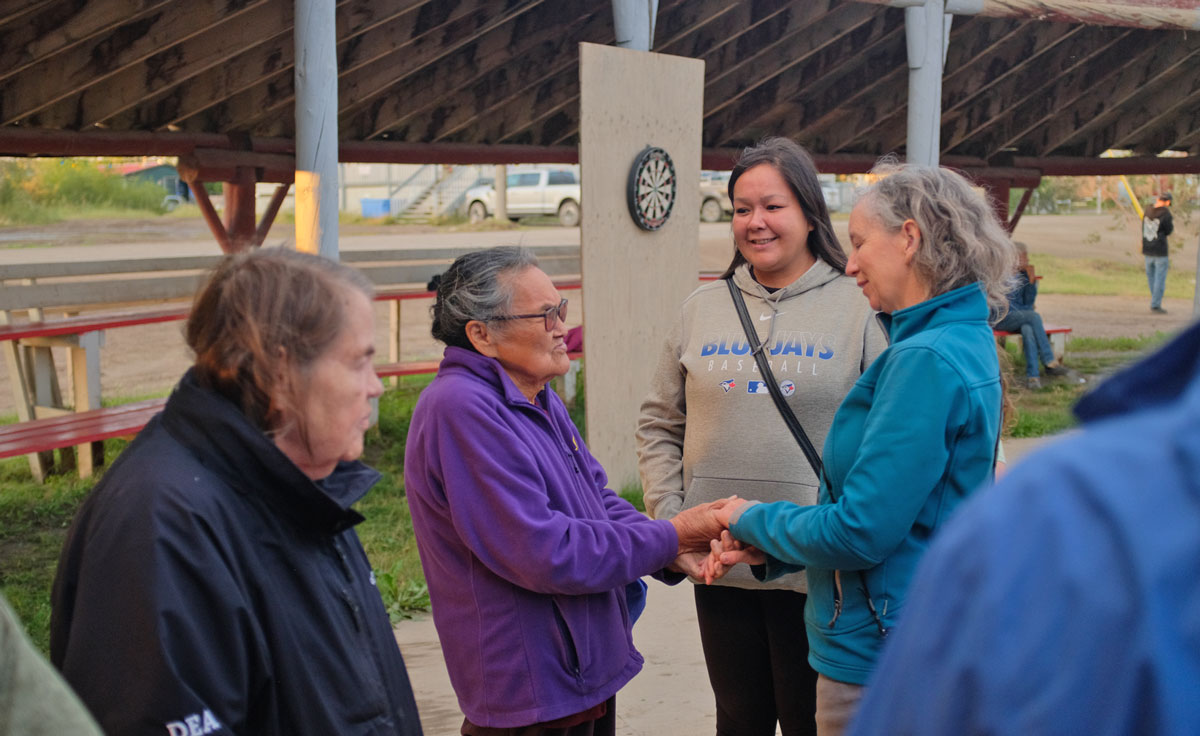
Encounter, relationships, and presence were key elements of the missionary pilgrimage trip. (Submitted photo)
More about the communities involved:
- The Deline Got’ine First Nation states as their vision to protect and conserve their lands in and around ‘Great Bear lake’ for the future – it is about how we see the land and water and our relationship with it. “Our vision allows us to pass along the knowledge and teachings of our ancestors onto the youth. Our vision captures what we want for our community – now and looking to the future. It will help us with our planning and setting priorities…Our vision is to fully implement our Self Government and to realize the dream of our Elders – one government for our people.” The Deline community is well recognized and respected for their leadership and progress towards this vision, which builds on a strong spiritual heritage, which features the leadership and teachings of their “Four Prophets.”
- The Tulita First Nation is the permanent settlement for predominately Sahtu Dene and Métis people on whose traditional land a “Fort Norman” trading post was built in the latter 1800s. In 1996, the name Fort Norman was officially changed to Tulita, which translates in Dene to “where the rivers or waters meet.” In 2004 a self-government framework agreement was established with the federal and territorial governments. For many years the community has been served by the Felician Sisters, in particular Sr. Celeste Goulet, CSSF, at the community’s Catholic Church and community outreach centre.
- The Roman Catholic Diocese of Saskatoon has a strong history of working with Indigenous leaders and Indigenous-led projects. It is currently guided by several Indigenous-led groups, including:
- The Diocese Truth and Reconciliation Committee – established in 2012 after the national Truth and Reconciliation Commission session that was held in Saskatoon;
- The IRF Discernment Circle and its ‘Granting Committee’ for the national Indigenous Reconciliation Fund (IRF);
- The Elders/ Parish community members of Our Lady Guadalupe Parish;
- The diocese is also well served and guided by the efforts of Greater Saskatoon Catholic Schools, and St. Thomas More College at the University of Saskatchewan, and the work of St. Paul’s Hospital and Emmanuel Care Catholic Health in terms of pursuing many of the “Calls to Action” from the TRC.
More photos:
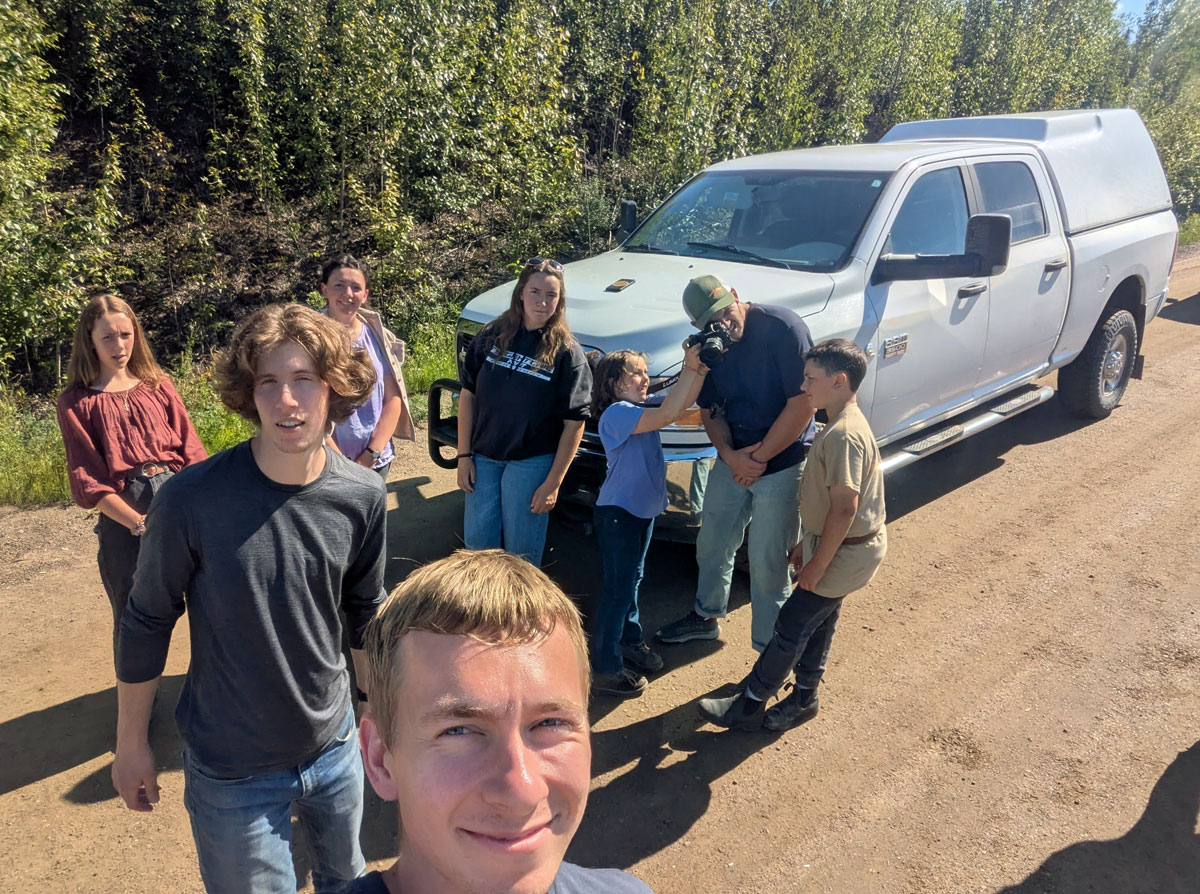
The journey to Tulita took four days: the team travelled 4,500 km (return) by road, and another 1,000 (return) by boat and ferry. (Submitted photo)
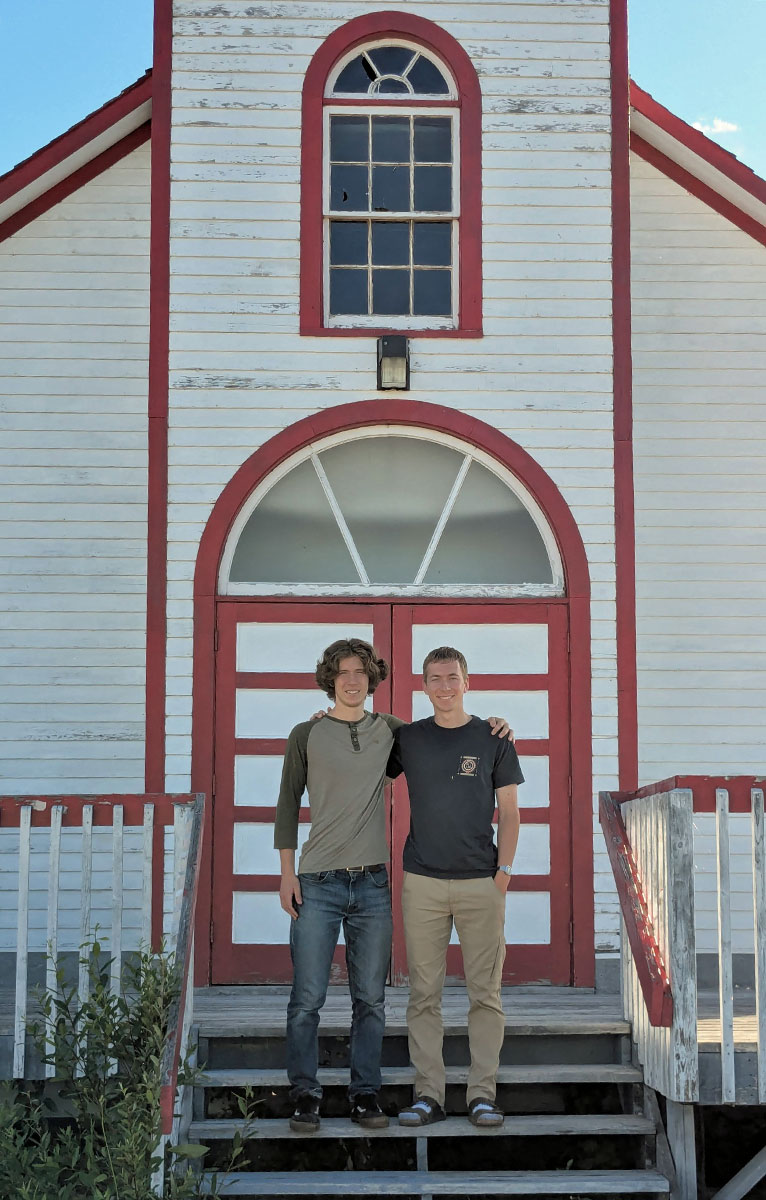
Ronan and Kieran Gillespie in front of St. Anne Catholic Church at Katlodeeche First Nation near Hay River, NT. (Submitted photo)
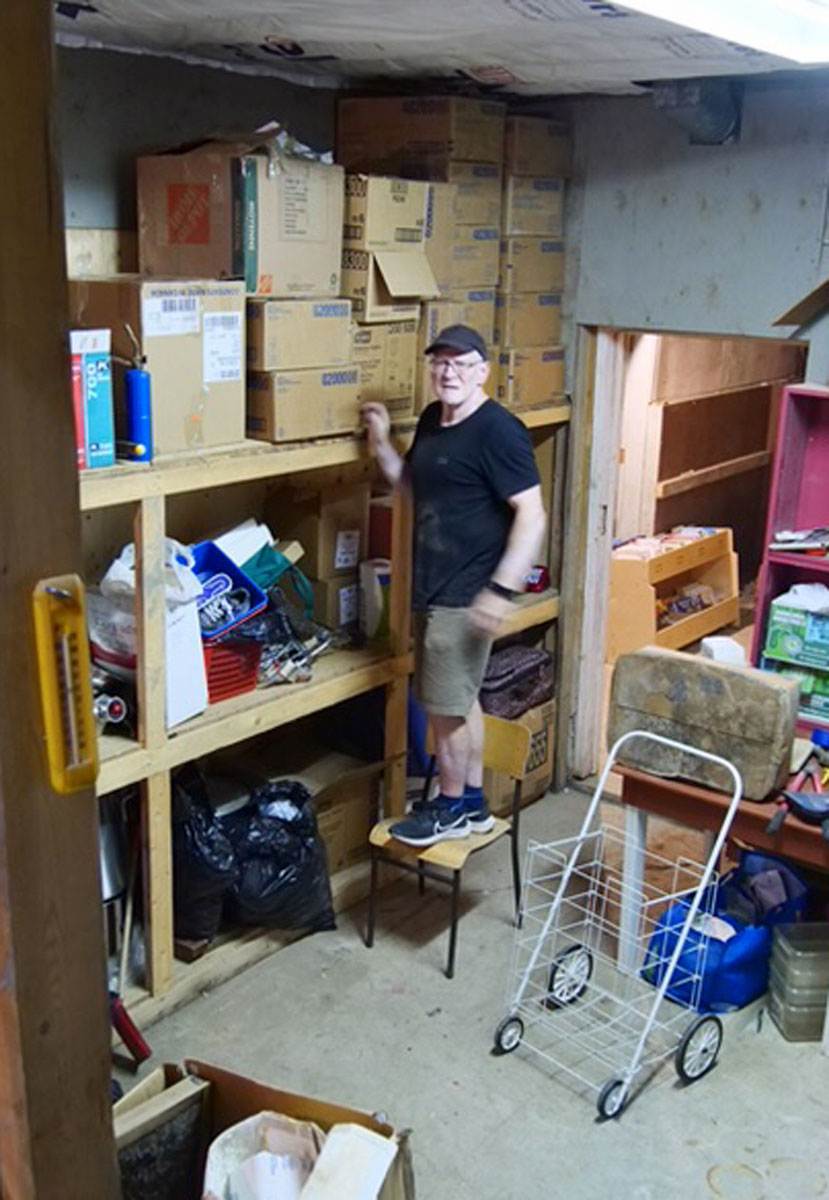
Bishop Mark Hagemoen works on organizing a storage area at the Tulita church and pastoral centre. (Submitted photo)
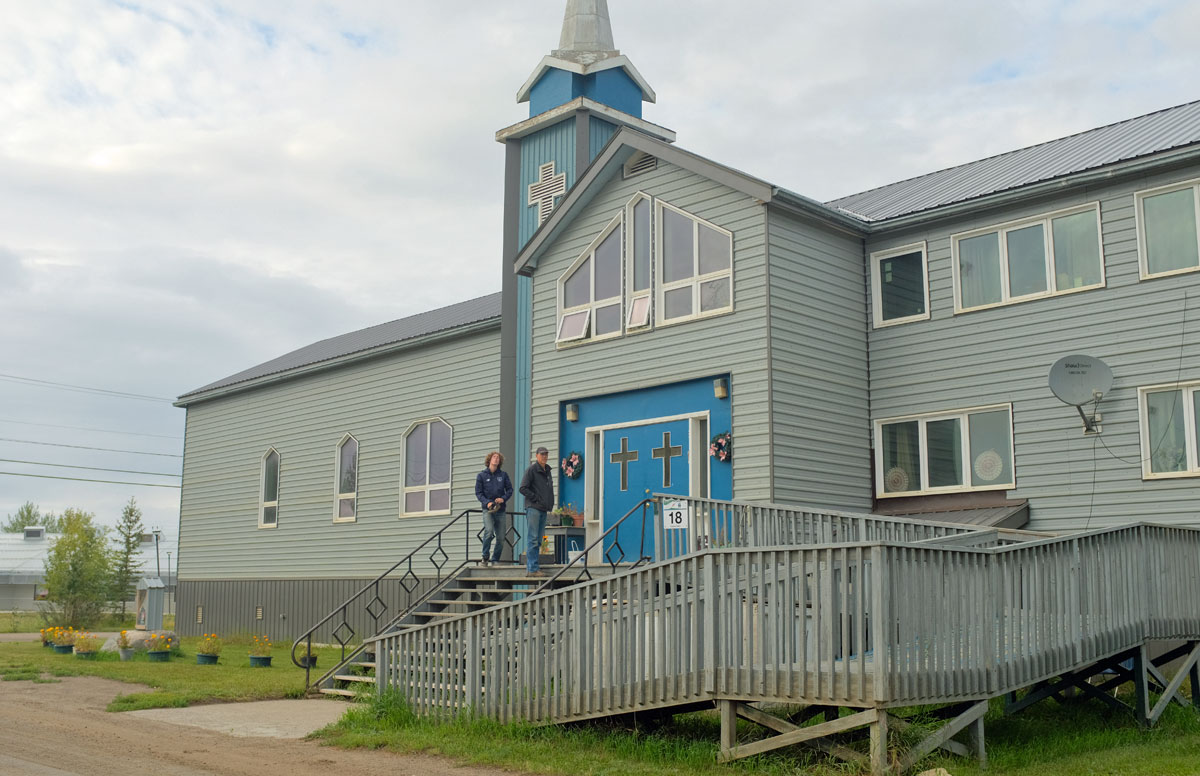
Ronan Gillespie and Ray Steiner in front to the Tulita pastoral centre and church. (Submitted photo)
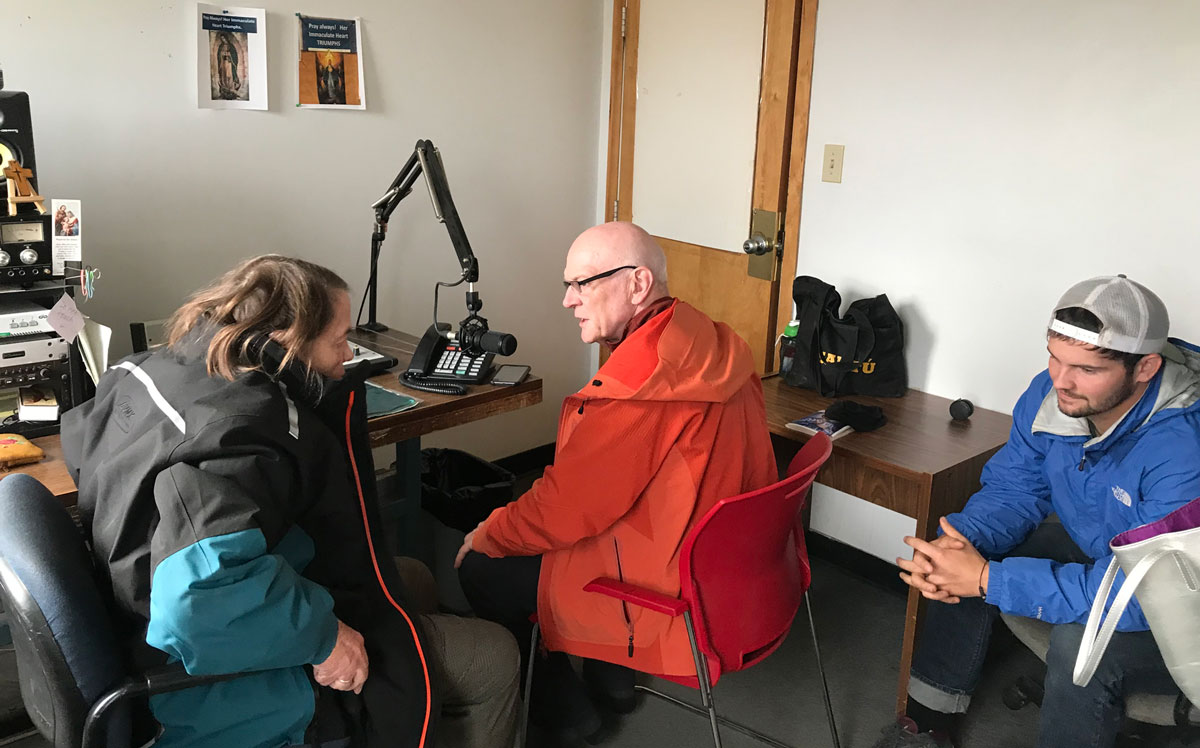
Bishop Mark Hagemoen and members of the team were interviewed by Sr. Celeste Goudet on her radio broadcast to the Tulita community. (Submitted photo)
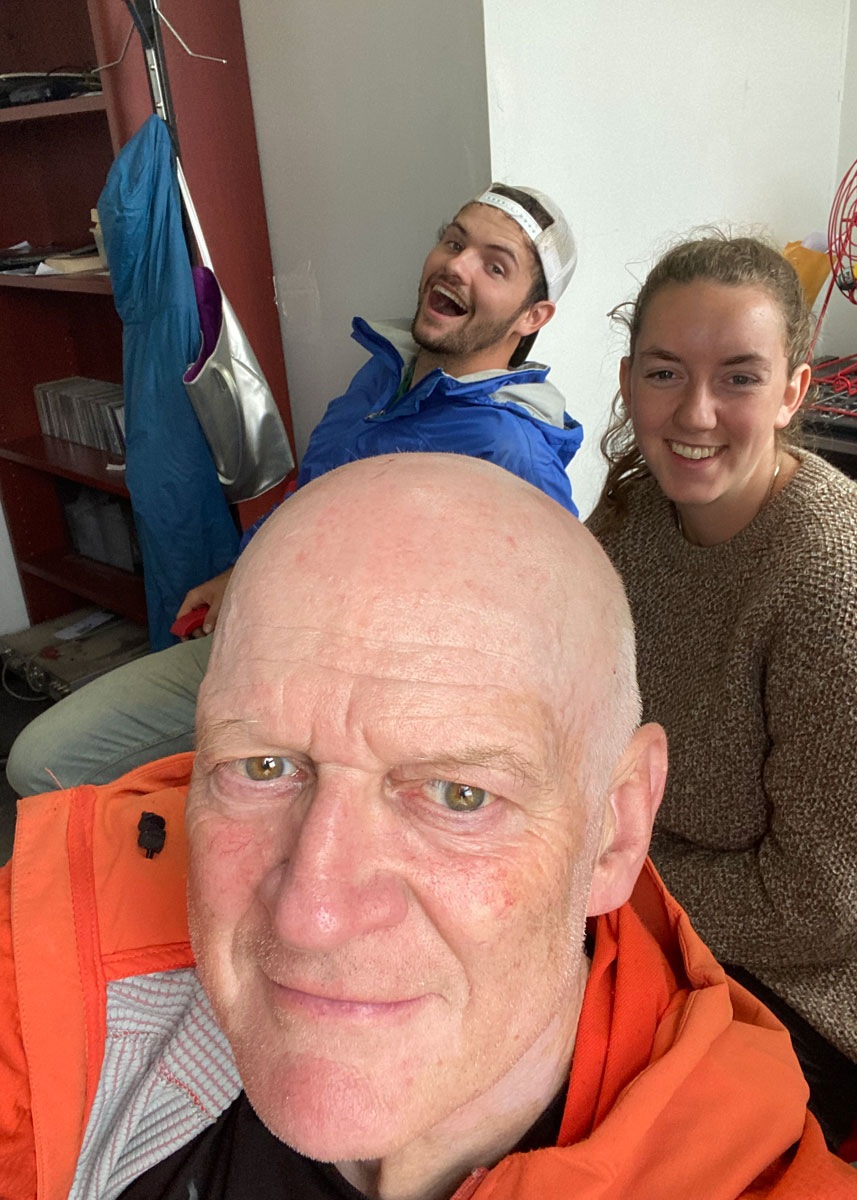
Bishop Mark Hagemoen, Max Connelly, and Kathleen Steiner were guests on the radio program hosted by Sr. Celeste Goulet in Tulita. (Submitted photo)
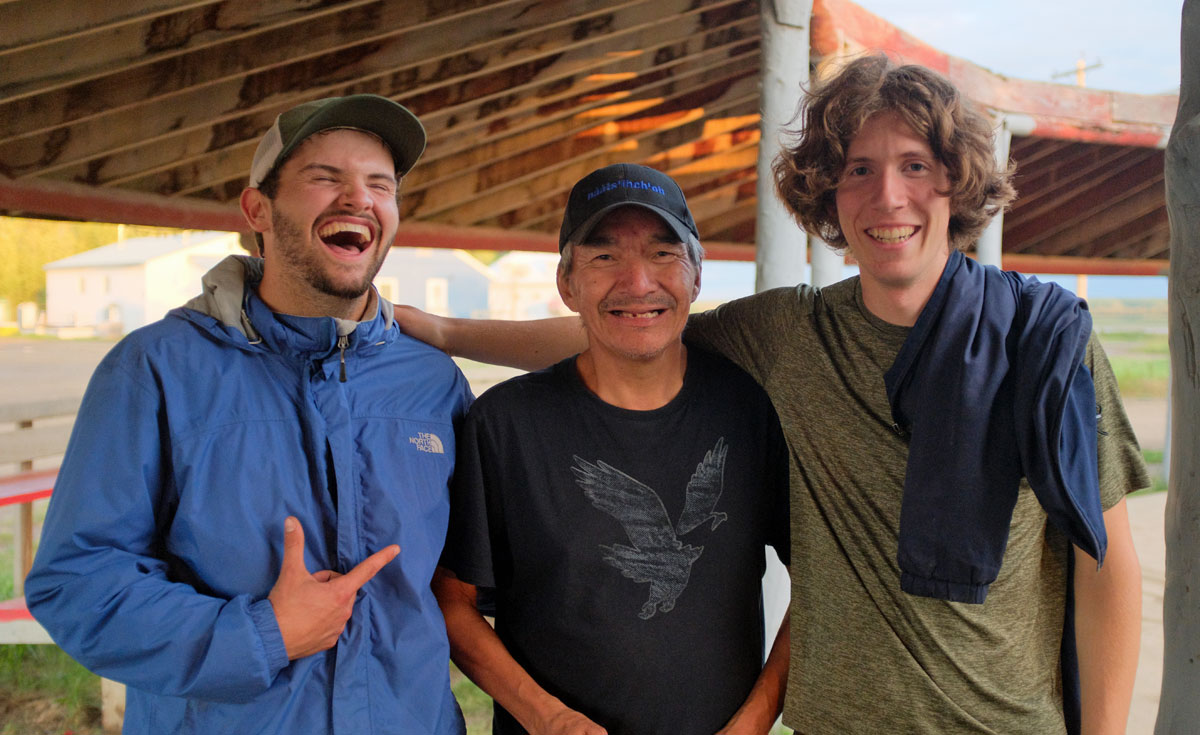
Max Connelly (left) and Ronan Gillespie (right) with a member of the Tulita community. (Submitted photo)

Leroy Andre piloted the boat that carried some members of the team up the Great Bear River Delta during a visit to Deline Dene Nation. (Submitted photo)
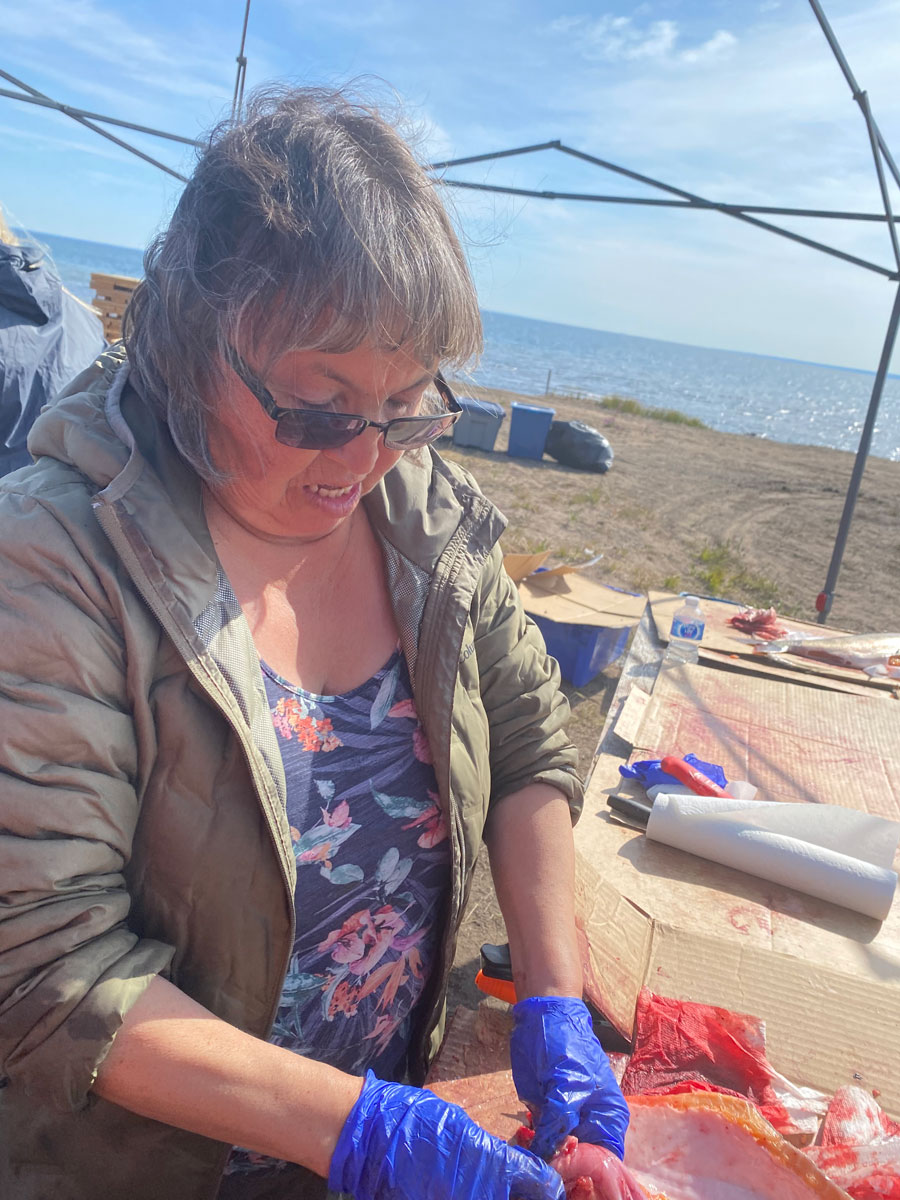
Traditional methods of filleting and preserving fish were part of the “on the land” camp visit. (Submitted photo)
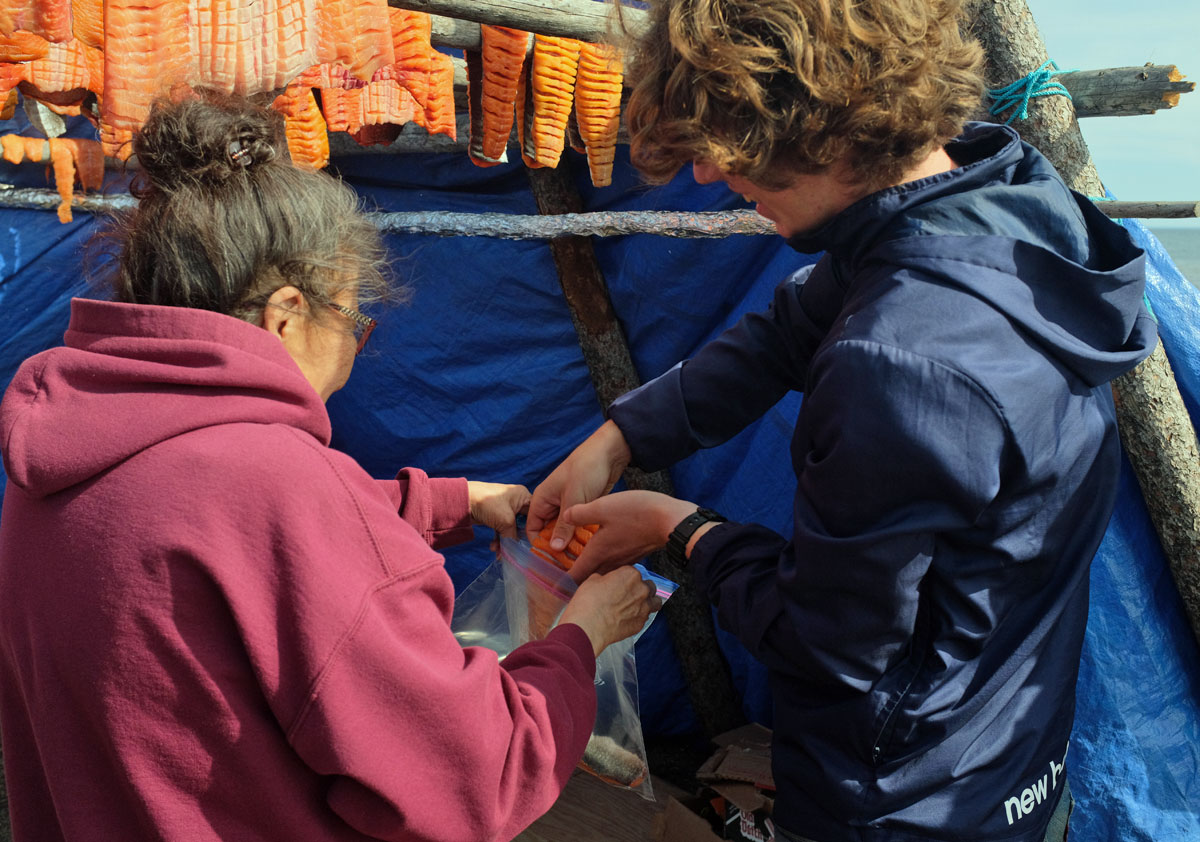
Ronan Gillespie (right) watches traditional skills demonstrated at the “on the land” fishing camp. (Submitted photo)
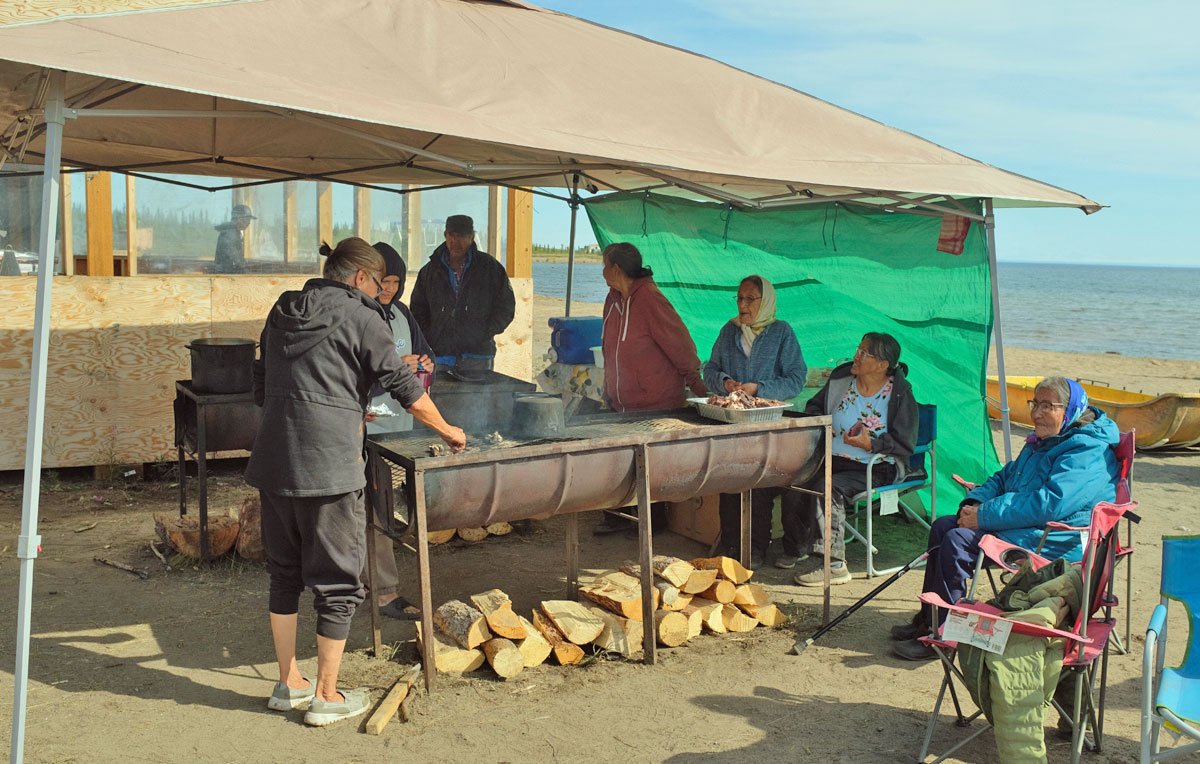
Traditional methods of filleting and preserving fish were underway at the Deline Dene “on the land” fishing camp. (Submitted photo)
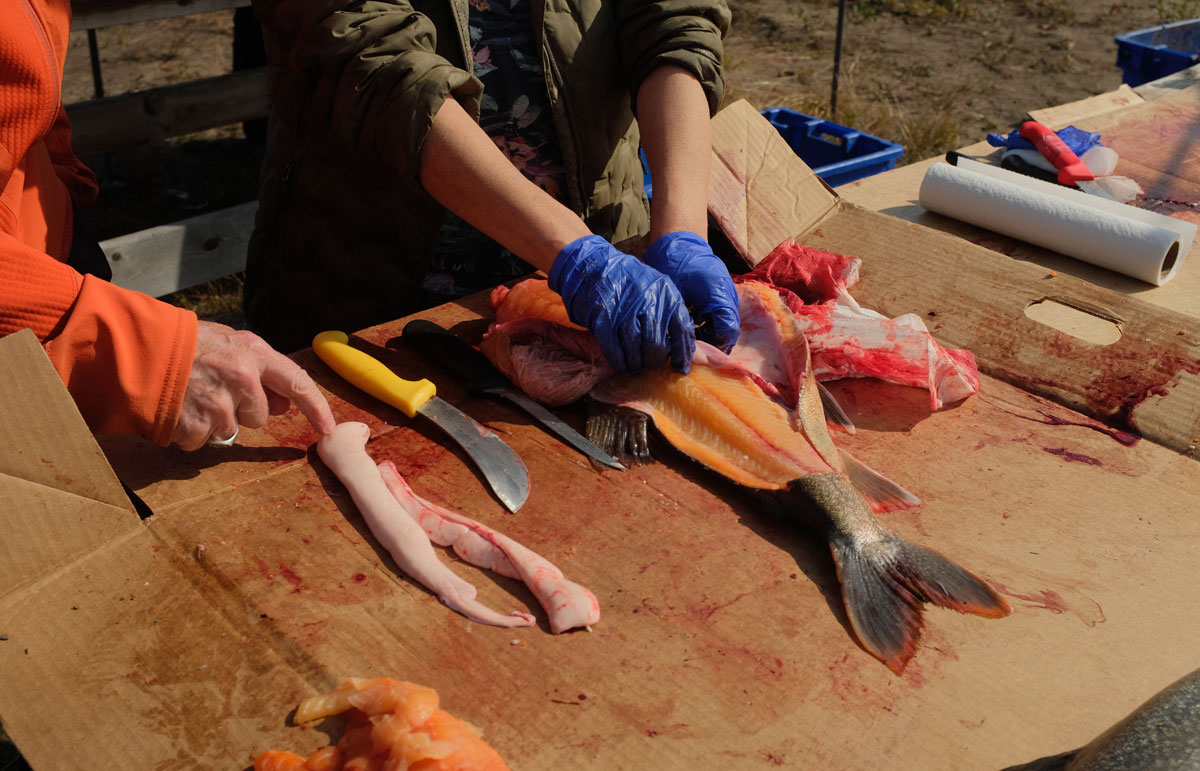
Traditional methods of filleting and preserving fish were underway at the Deline Dene “on the land” fishing camp. (Submitted photo)
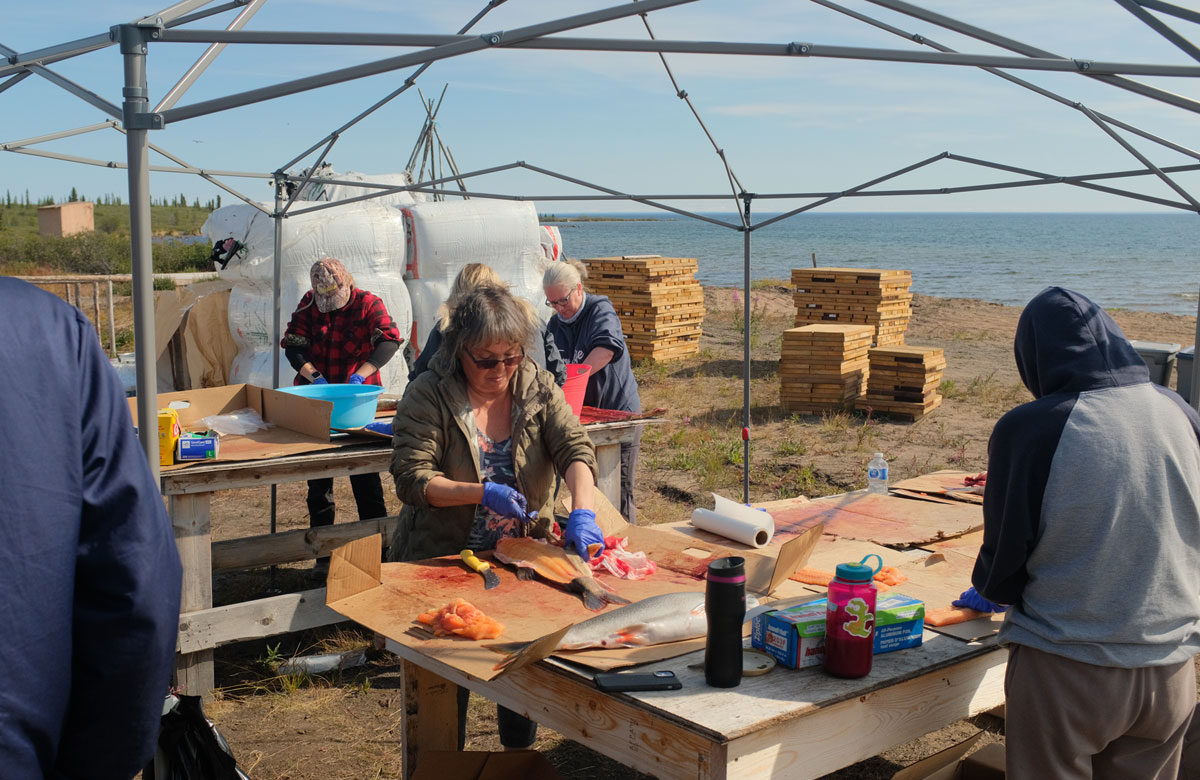
Traditional methods of filleting and preserving fish were underway at the Deline Dene “on the land” fishing camp. (Submitted photo)
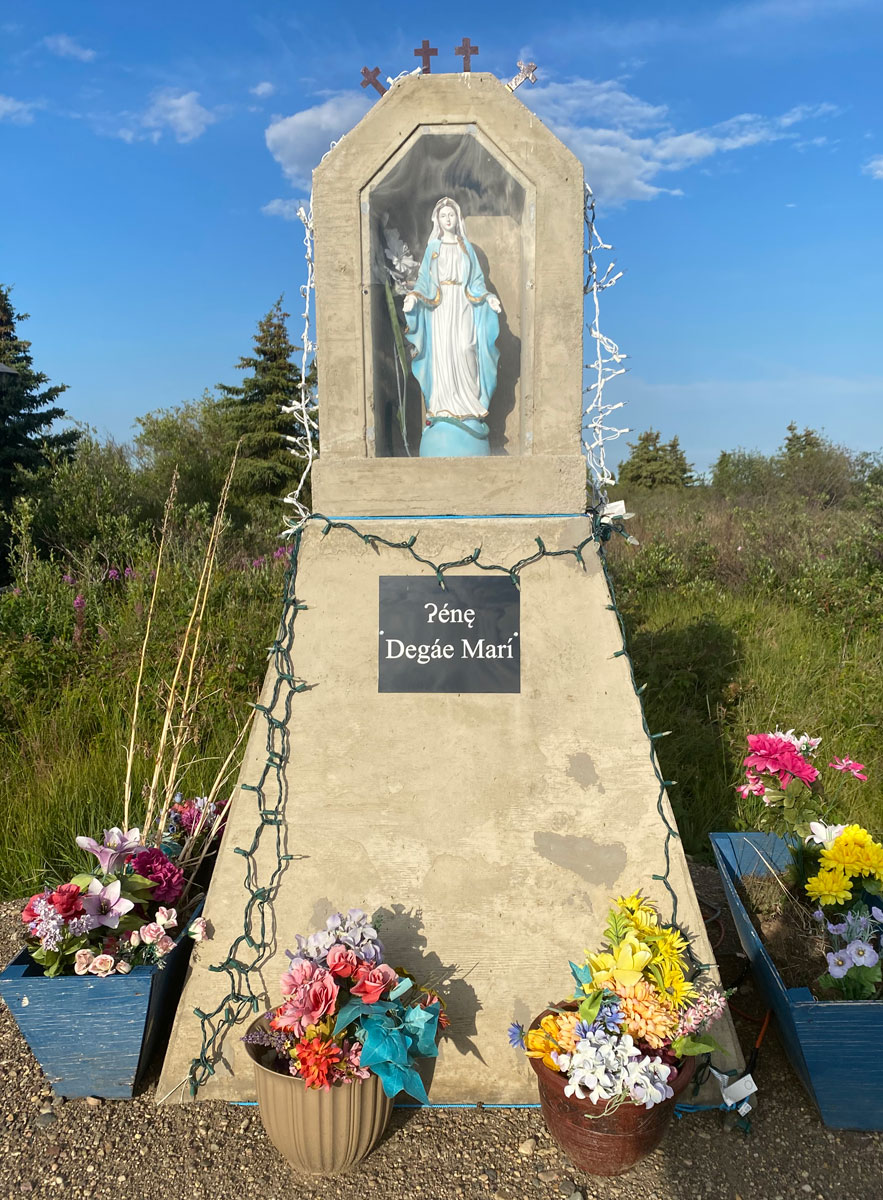
Shrine with a prayer to Mary in the Dene language, near St. Therese of Lisieux Church in Deline. (Submitted photo)
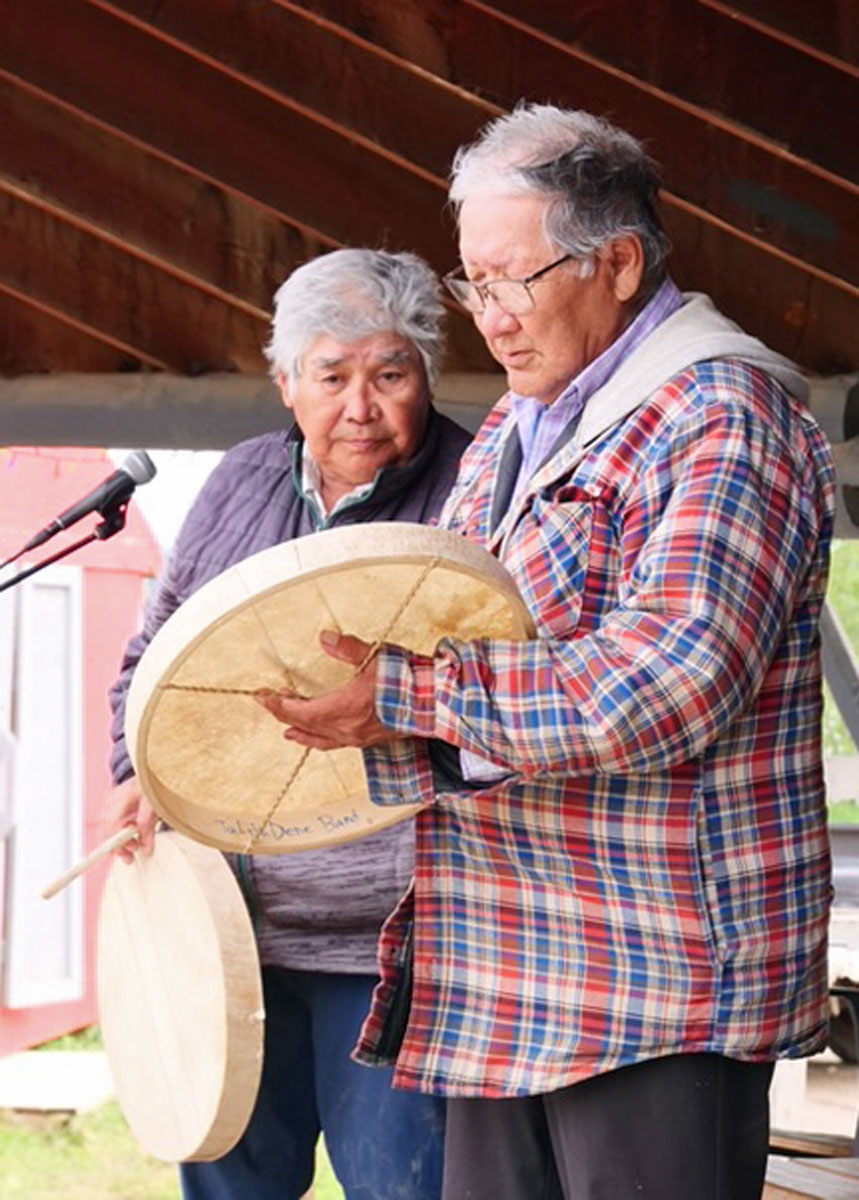
Chief Frank Andrew with the lead drummer during the team’s last night in Tulita, NT. (Submitted photo)
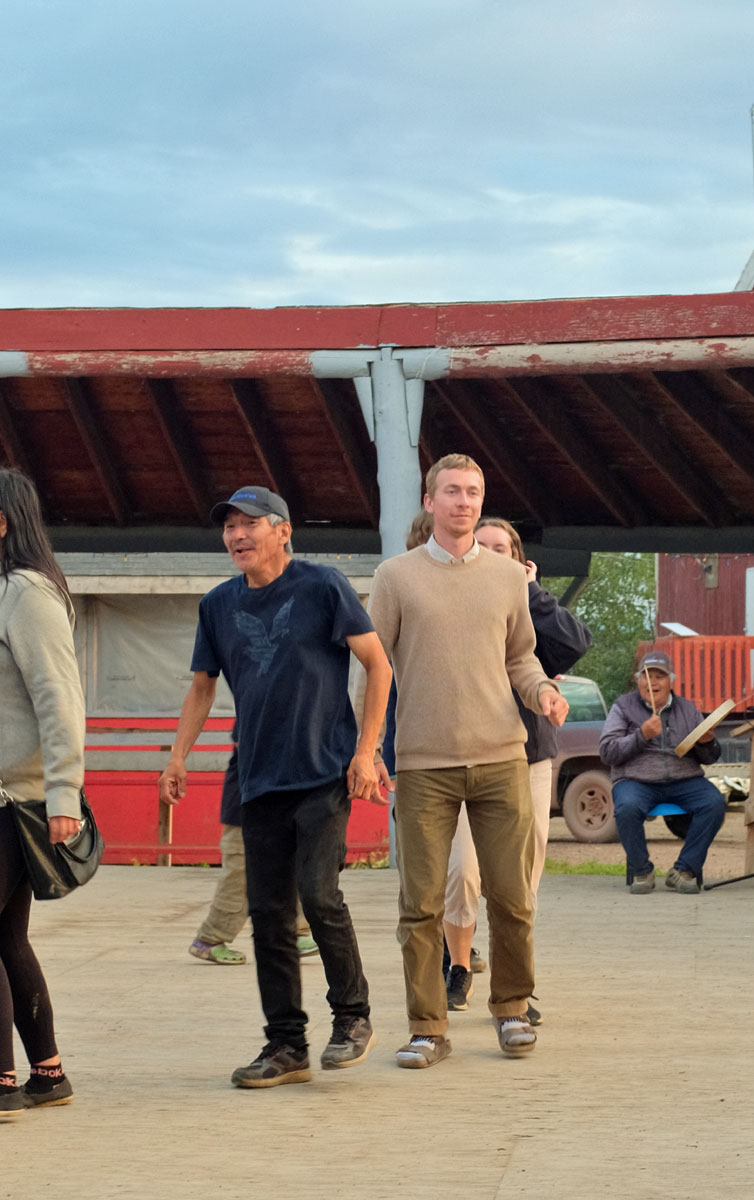
Kieran Gillespie and other team members participated in the drumming dance held in their honour at Tulita, NT. (Submitted photo)
-30-
Kiply Lukan Yaworski is the communications coordinator for the Roman Catholic Diocese of Saskatoon: rcdos.ca
Catholic Saskatoon News and the diocesan Communications Office are supported by gifts to the Bishop’s Annual Appeal: dscf.ca/baa
